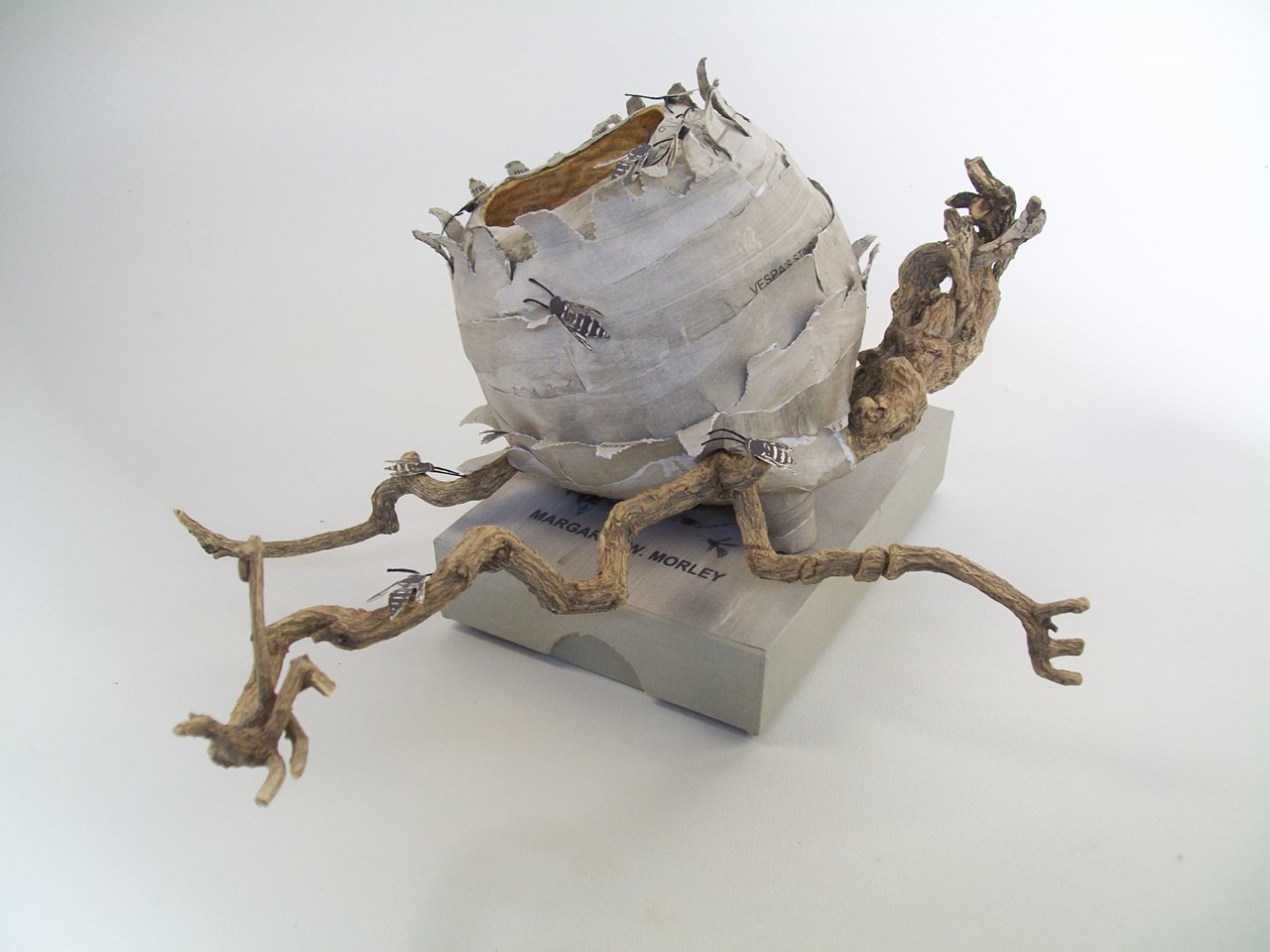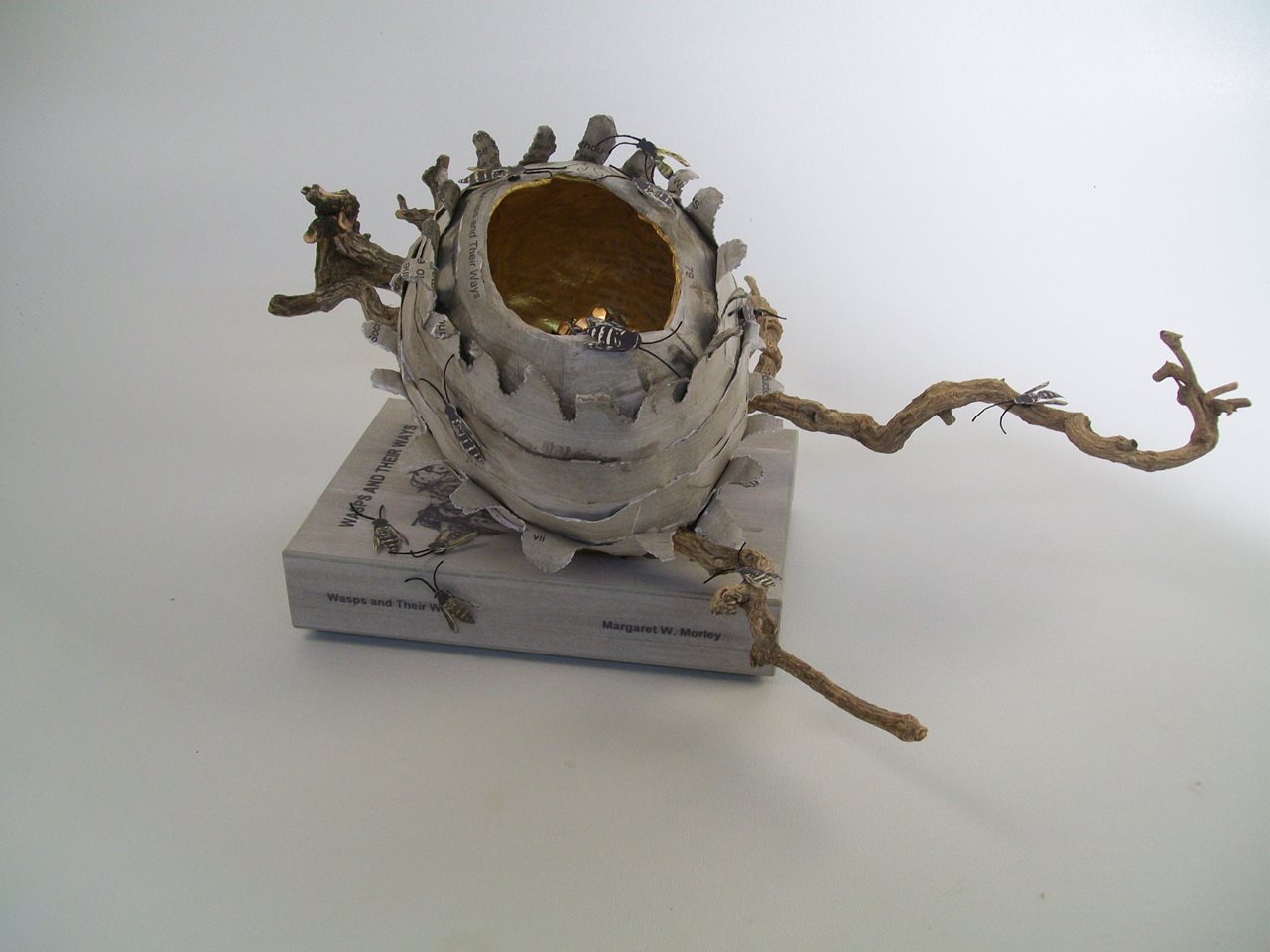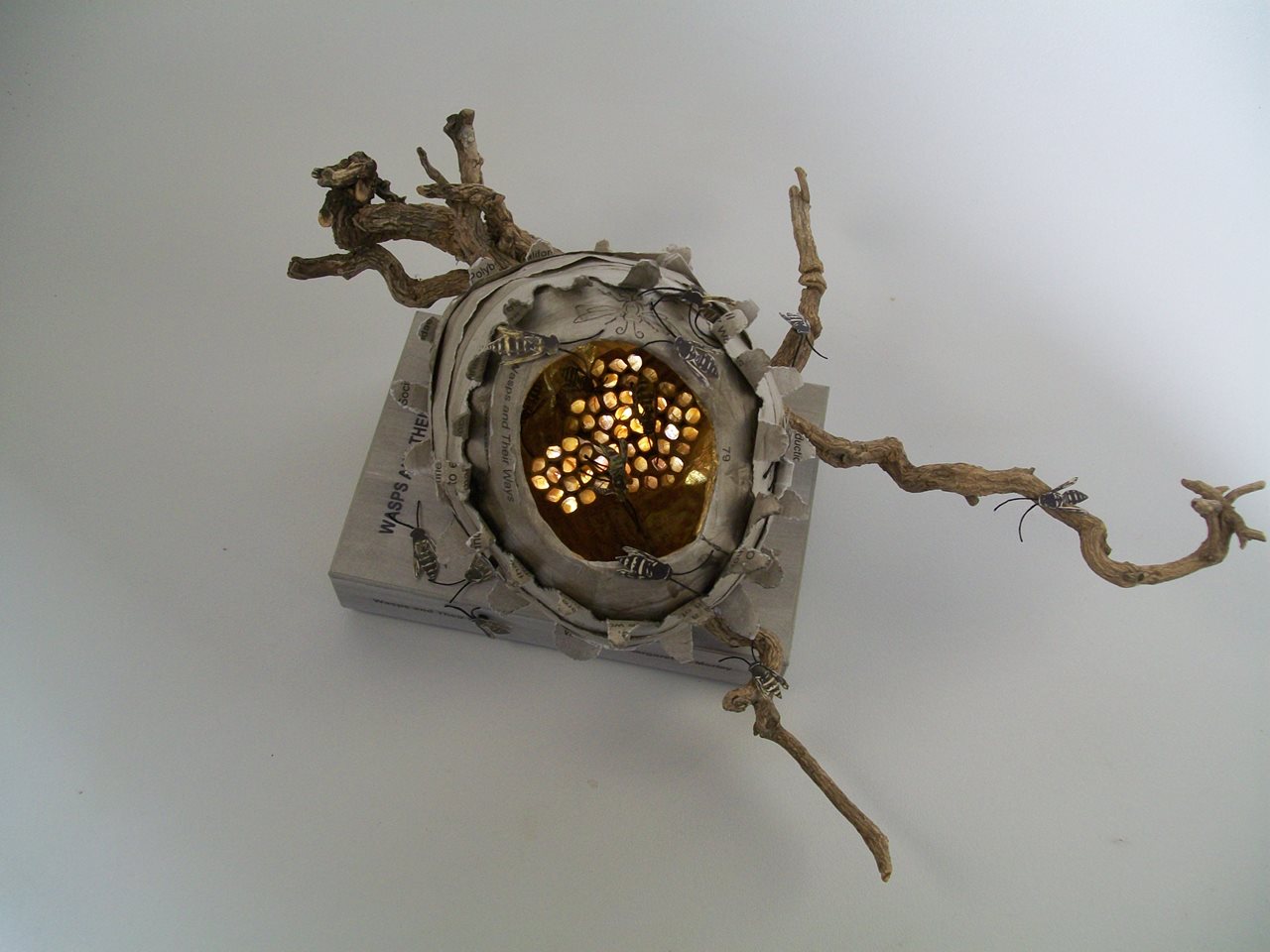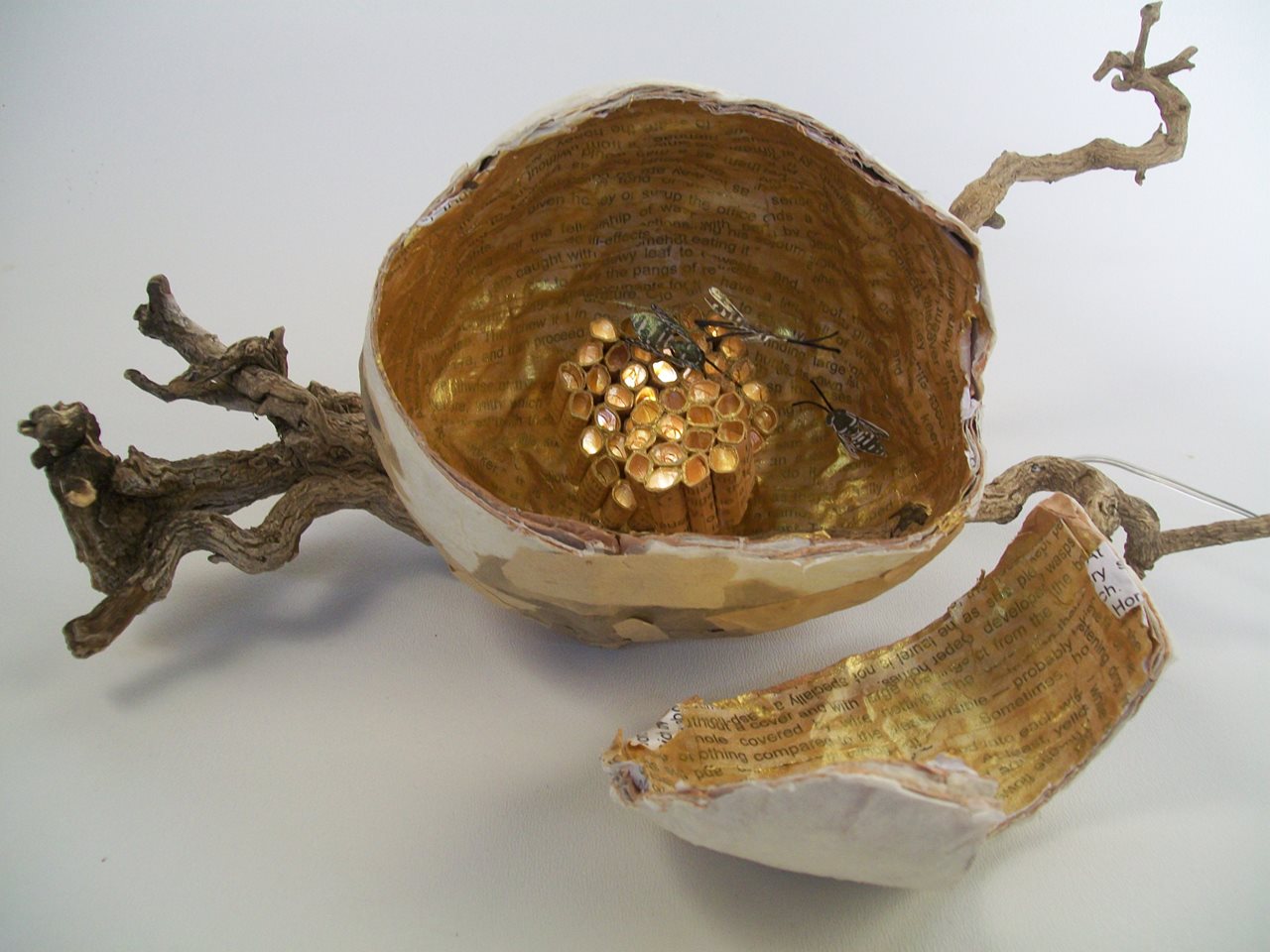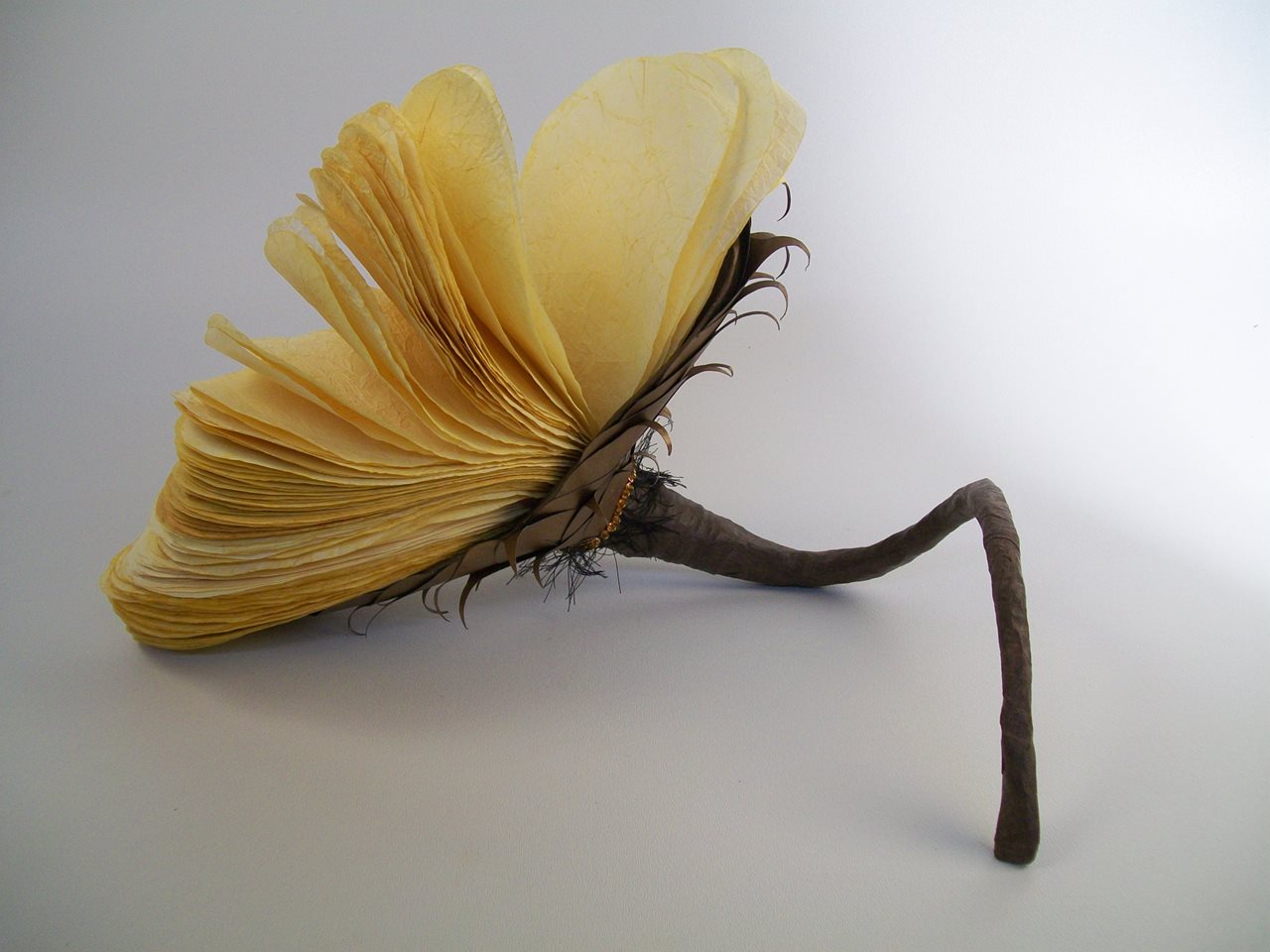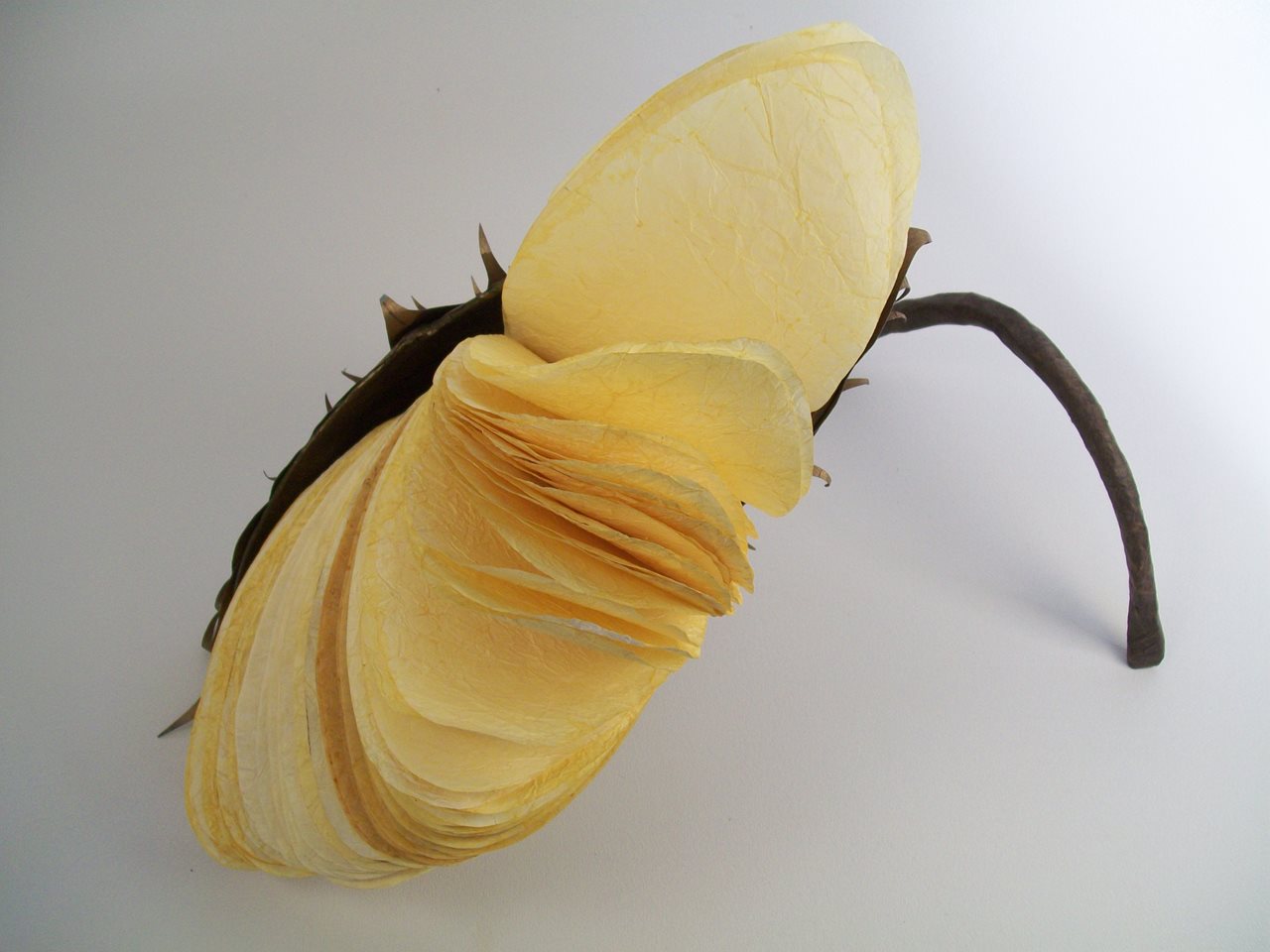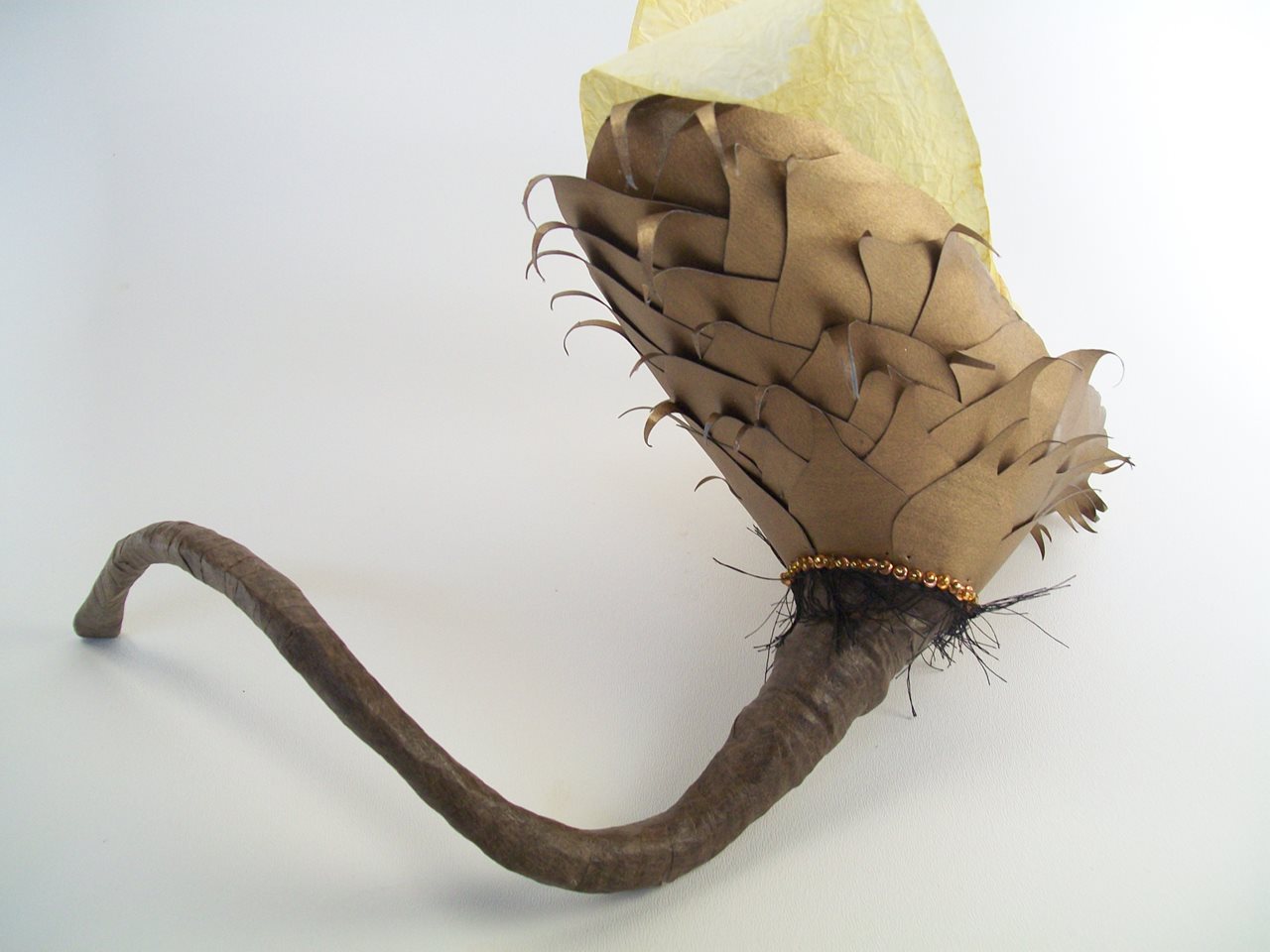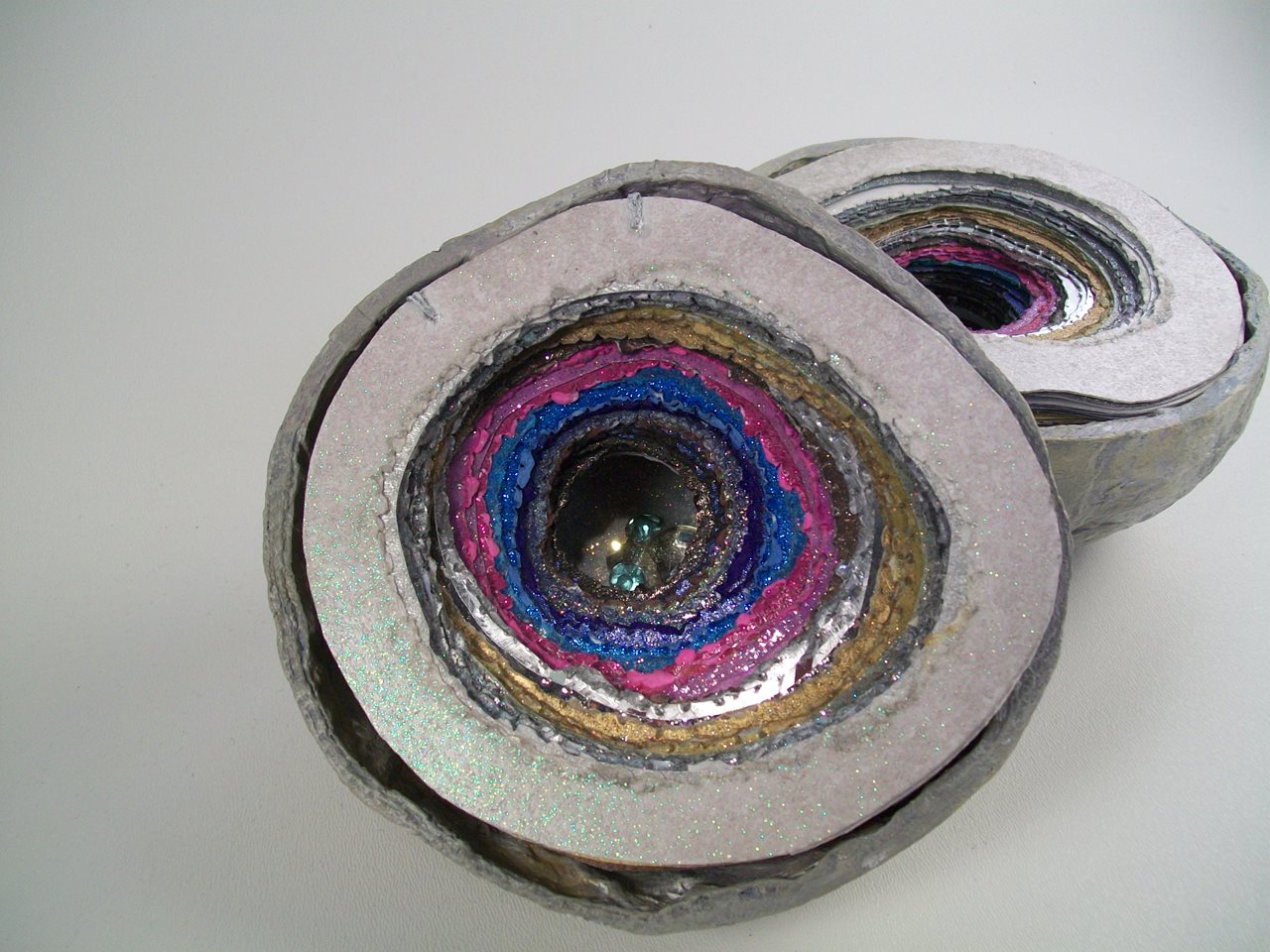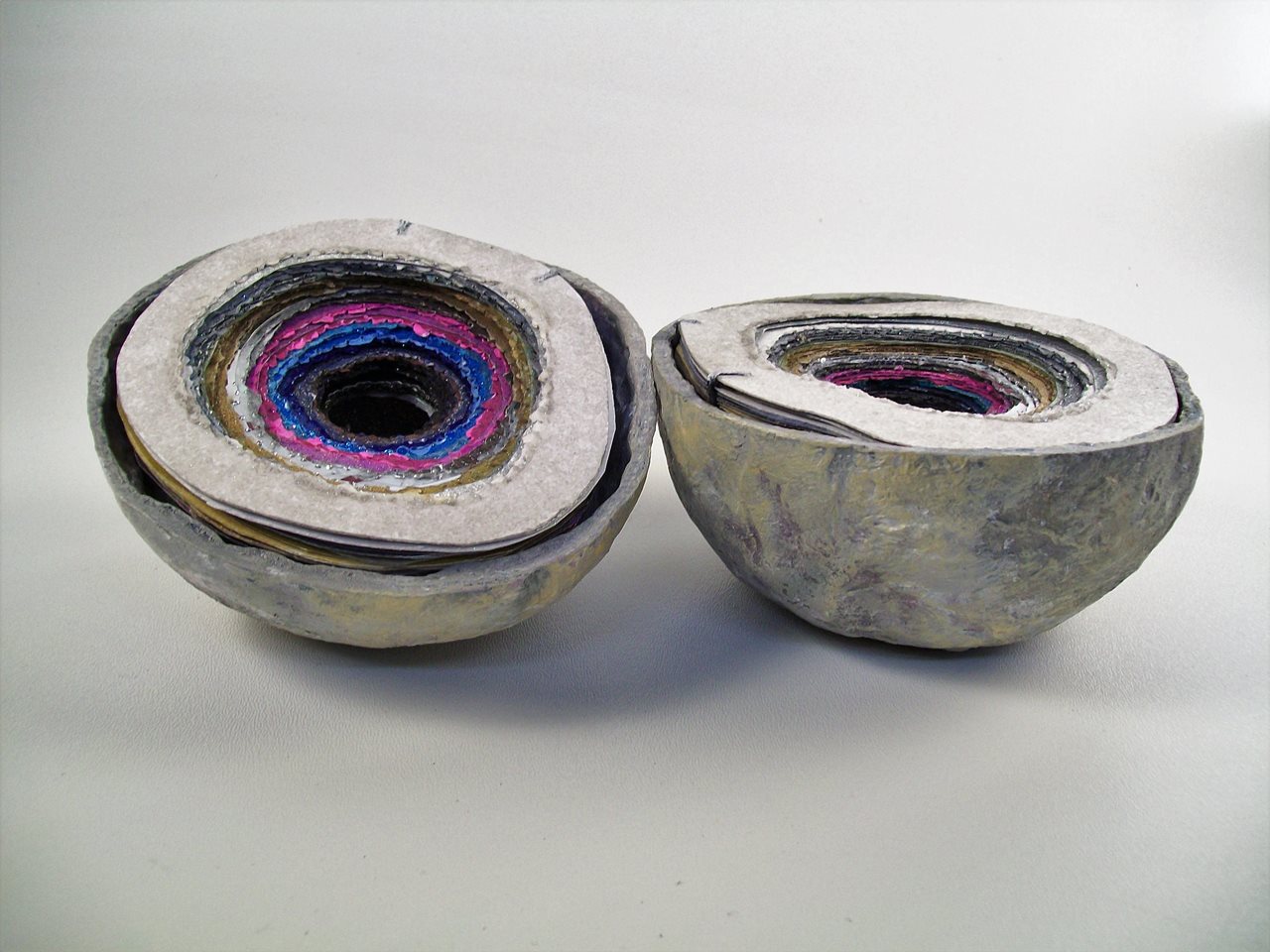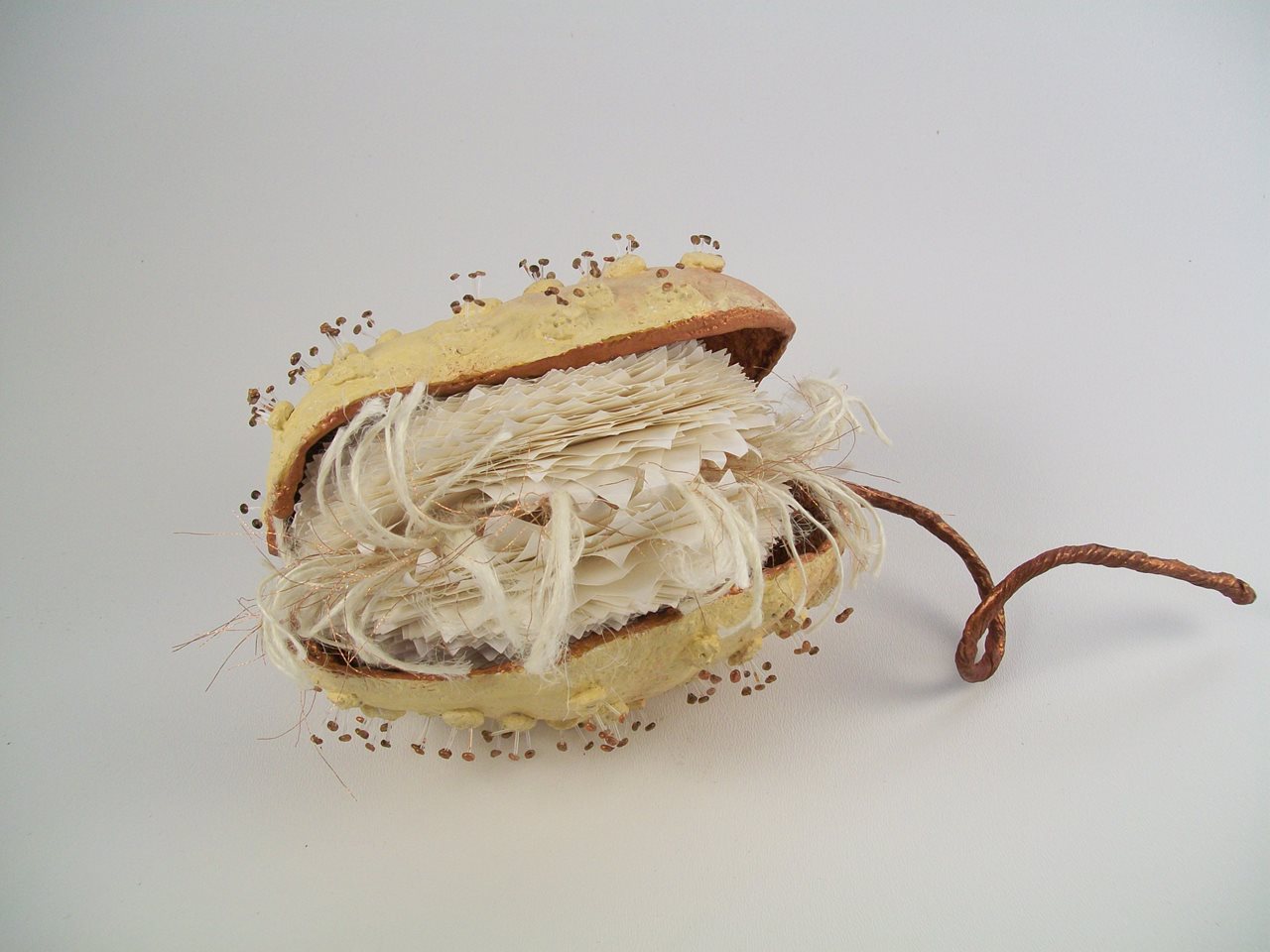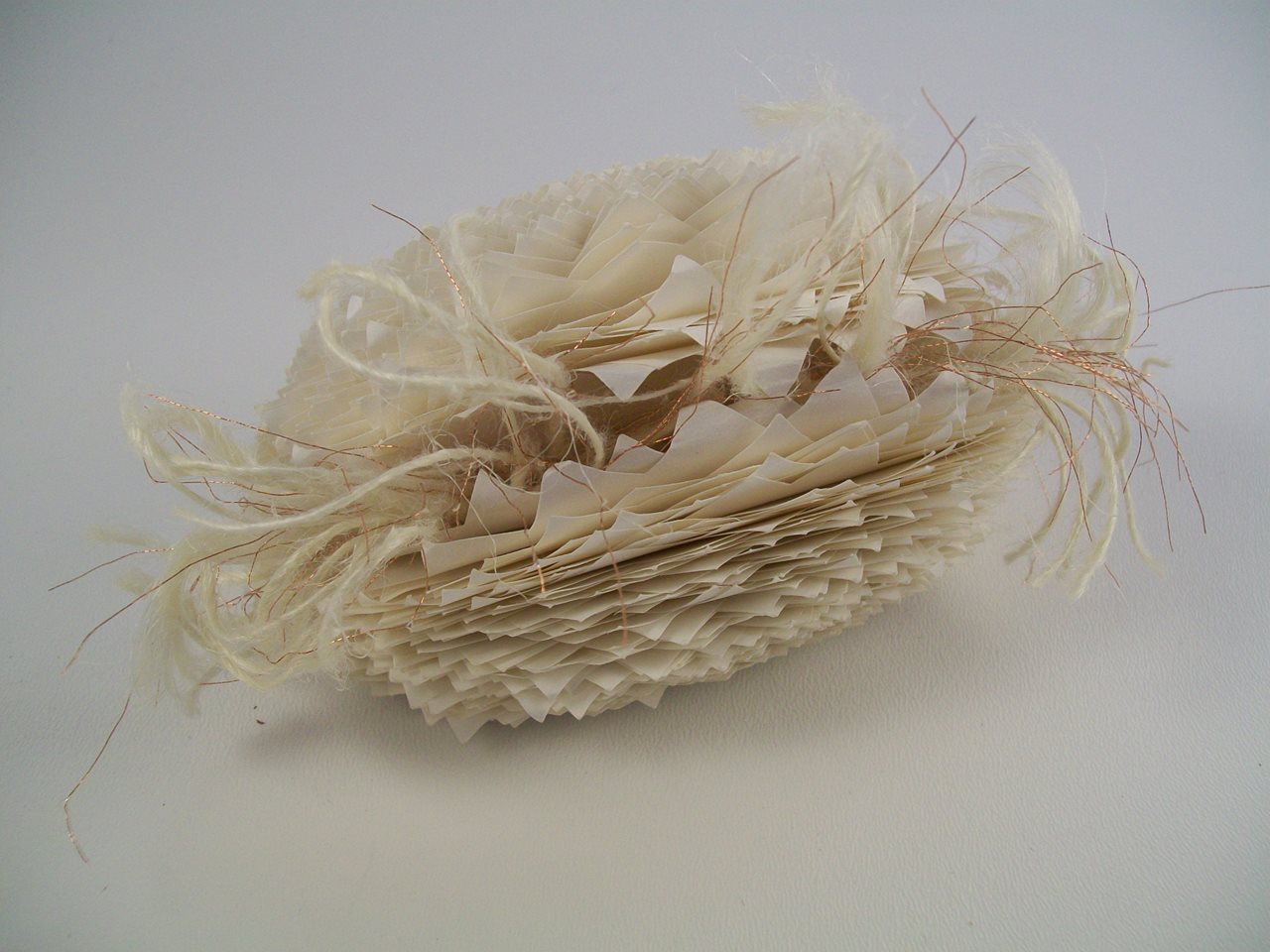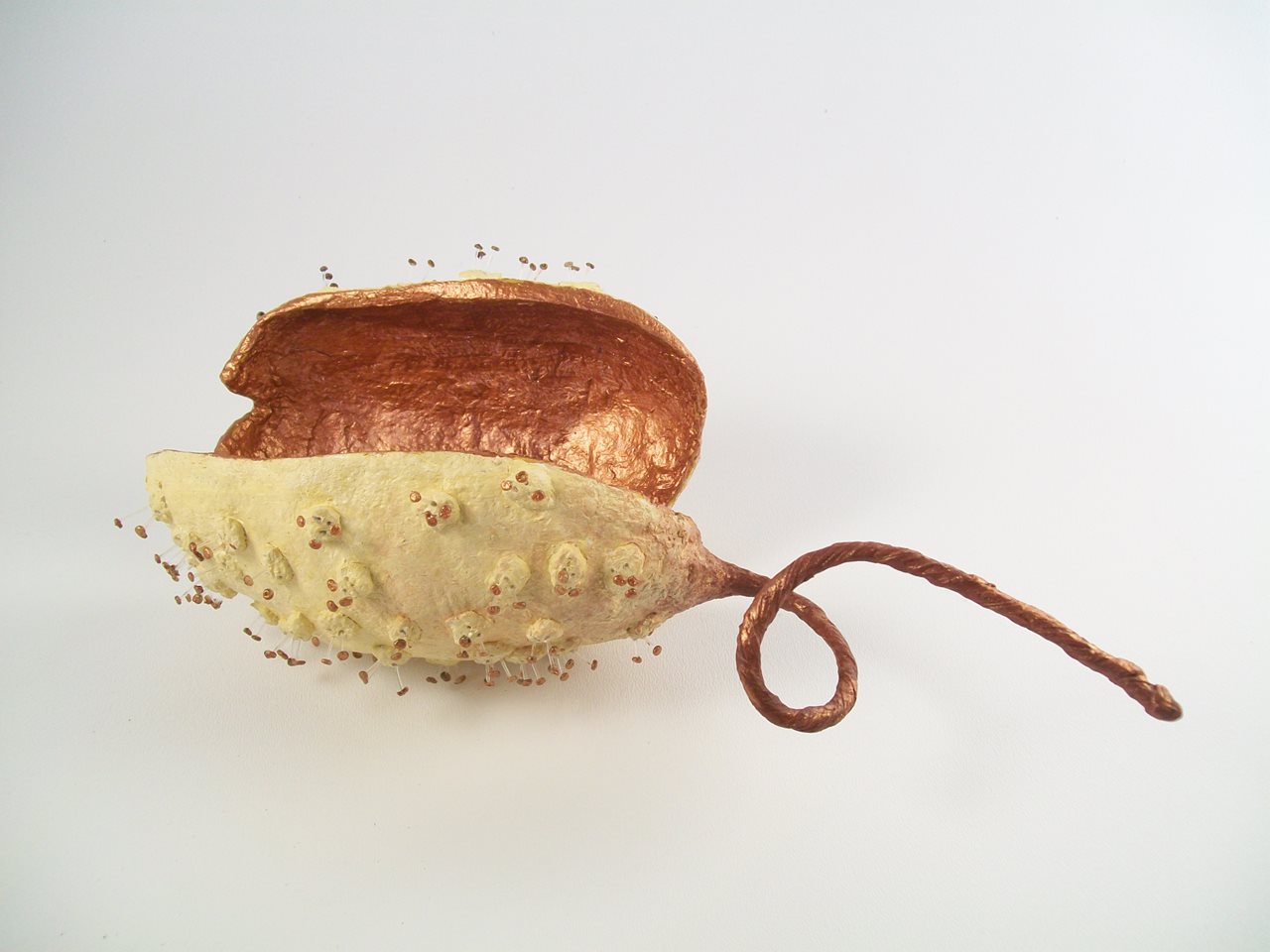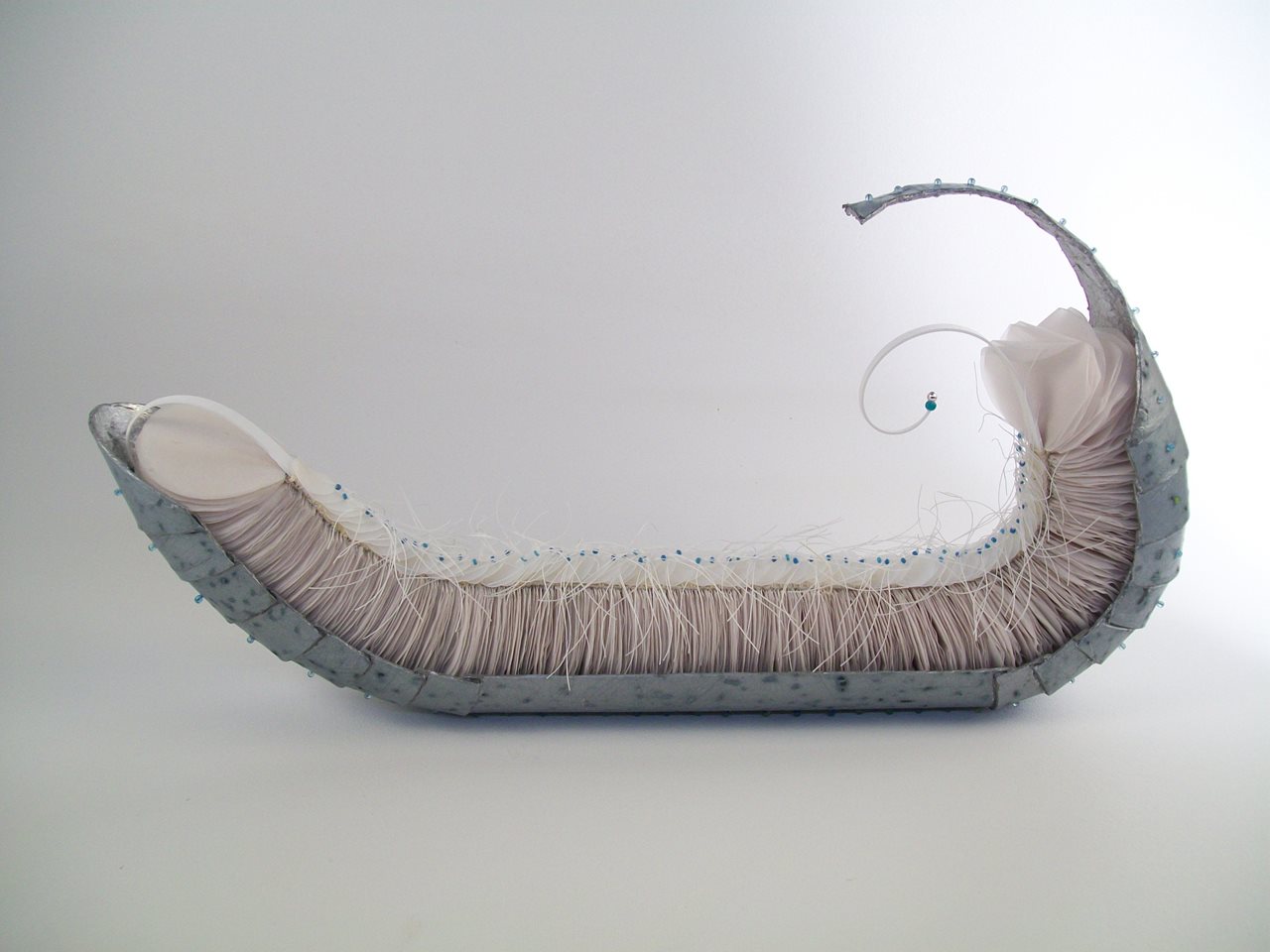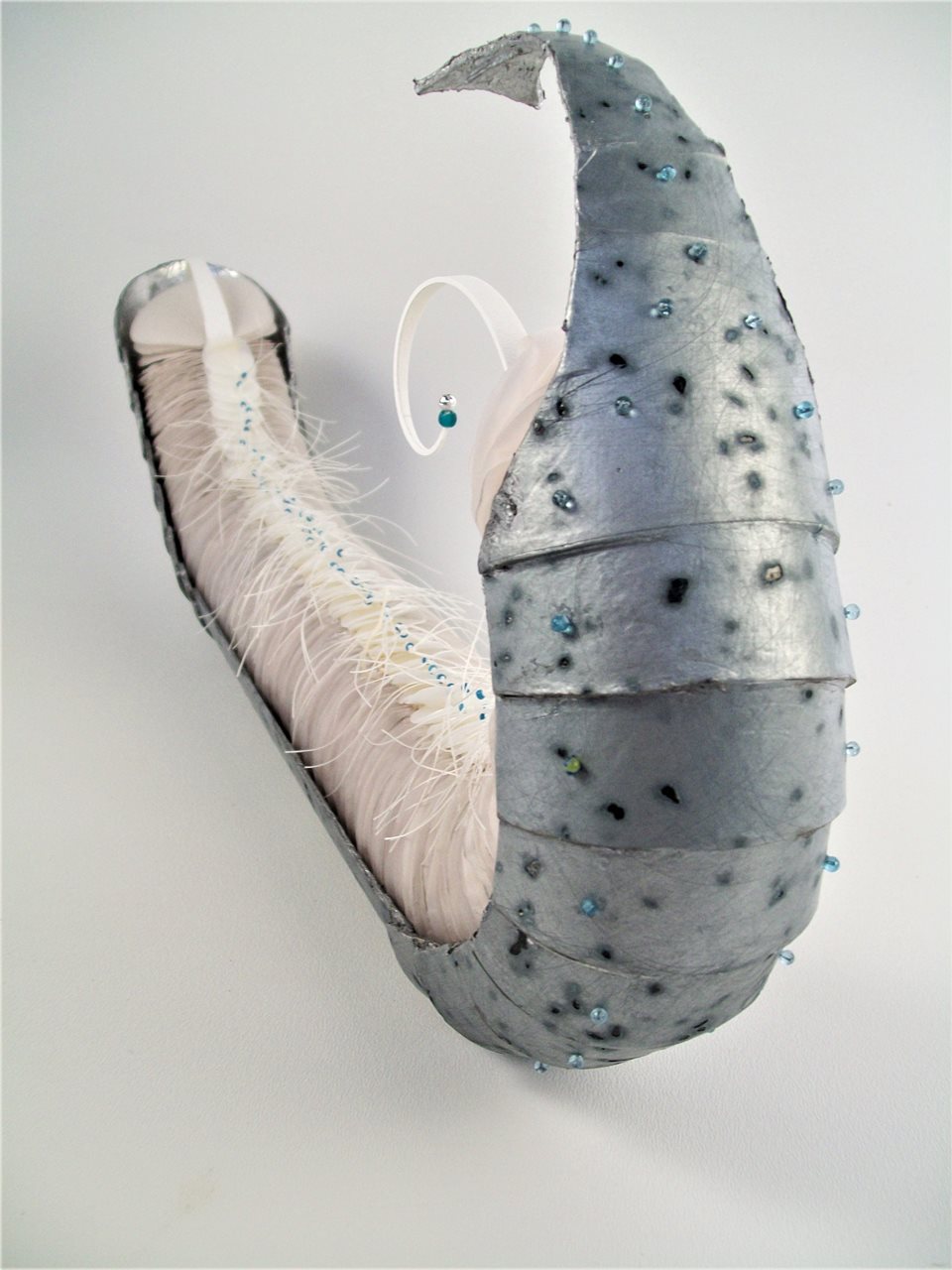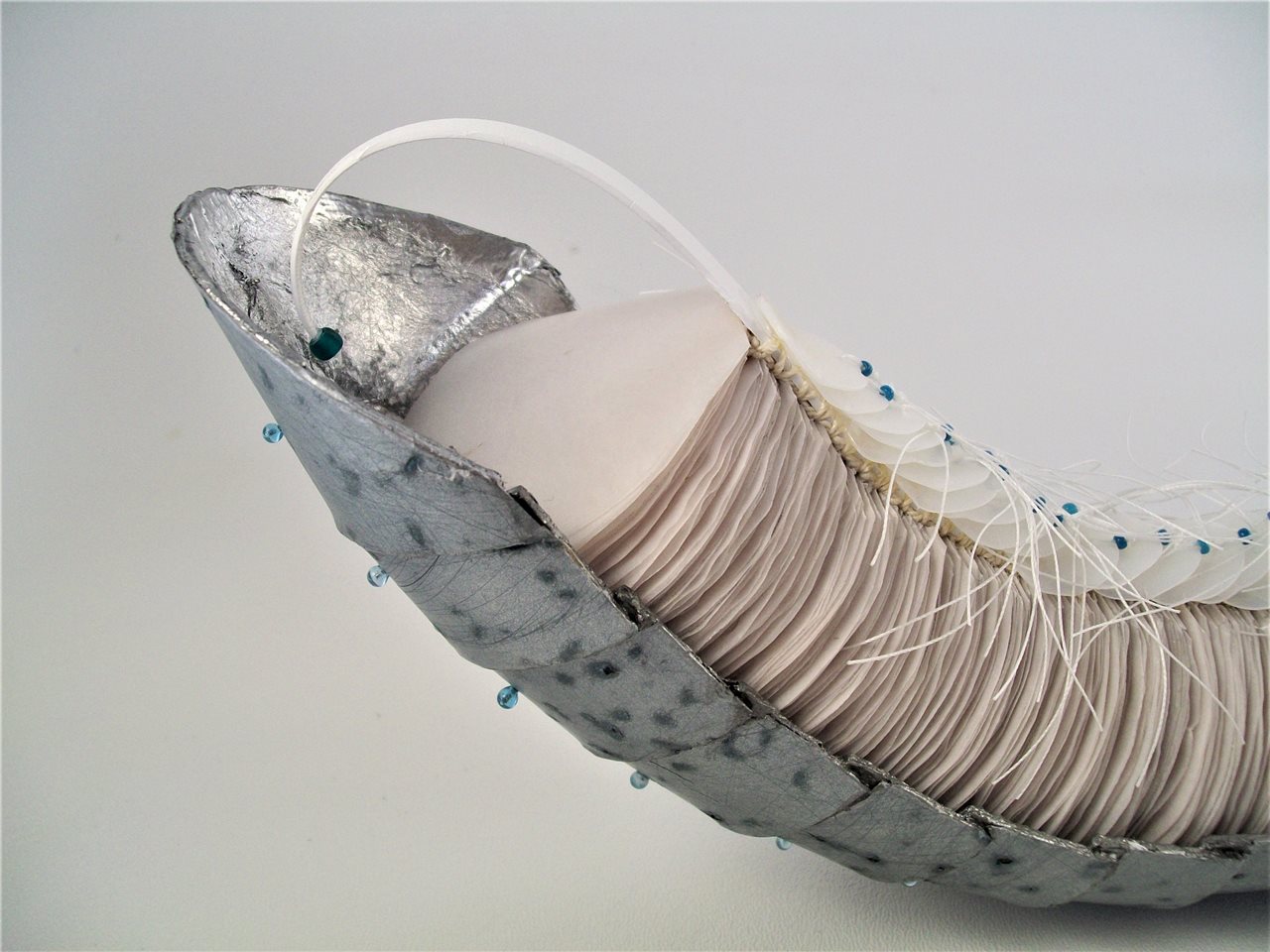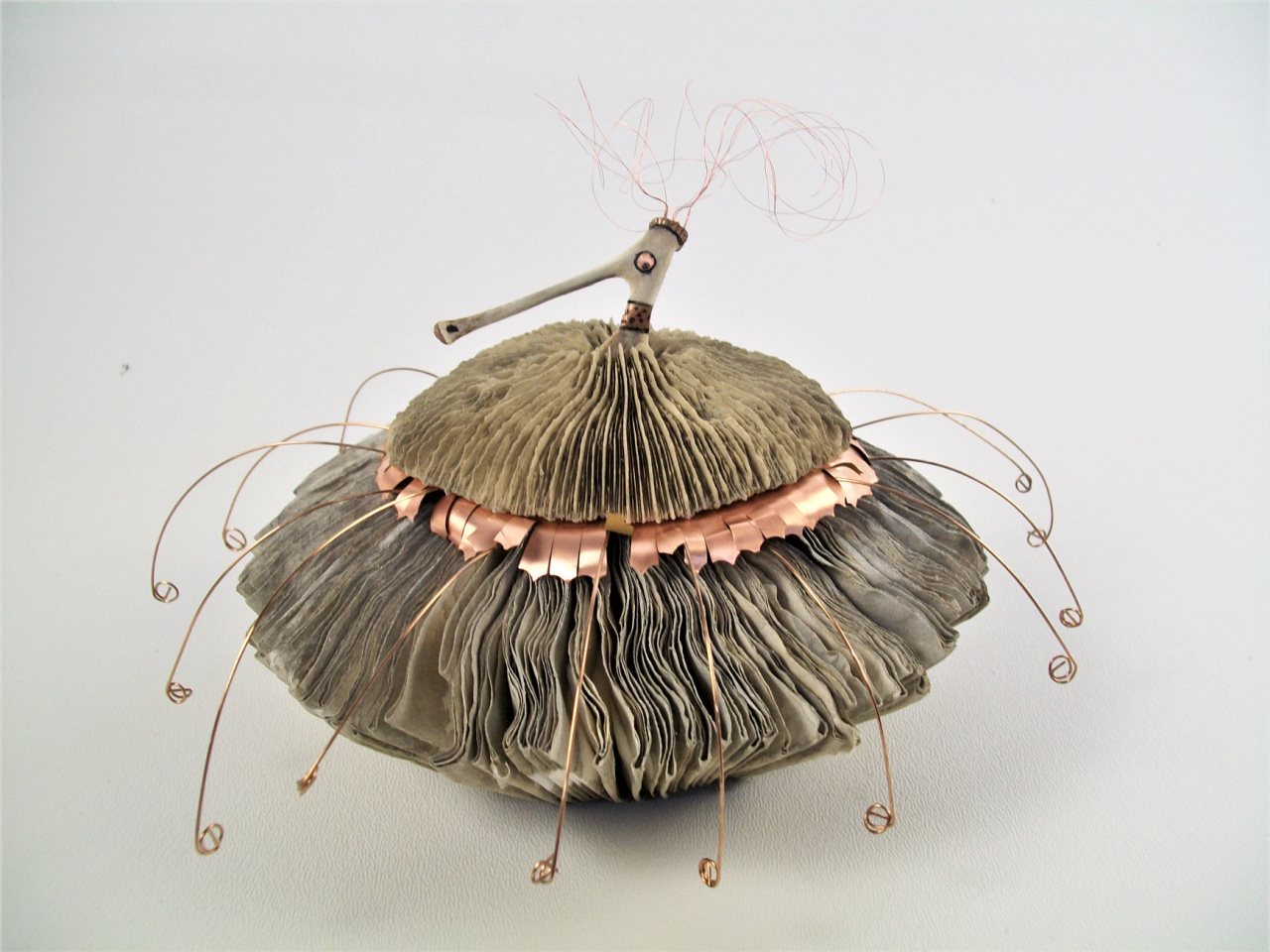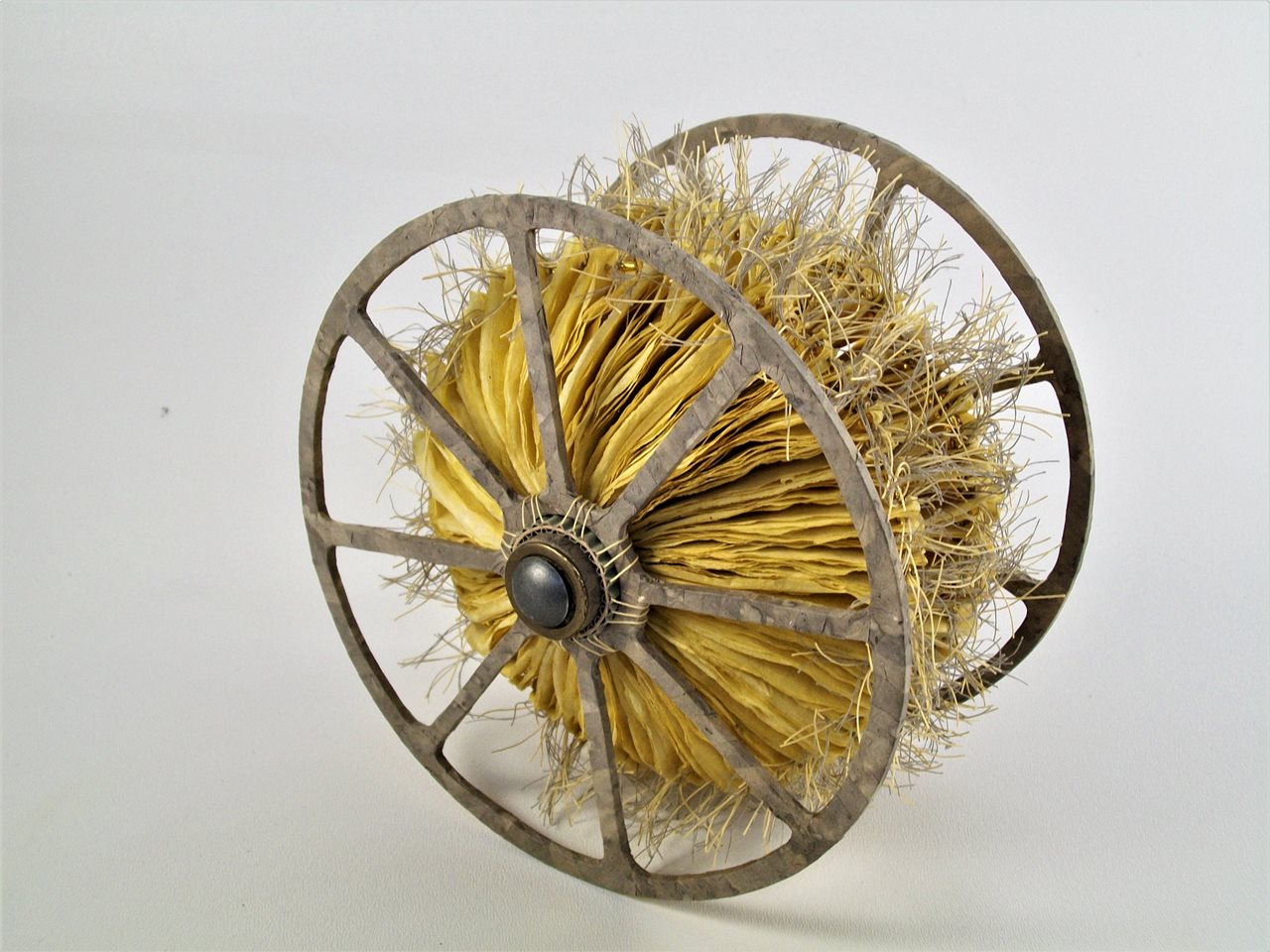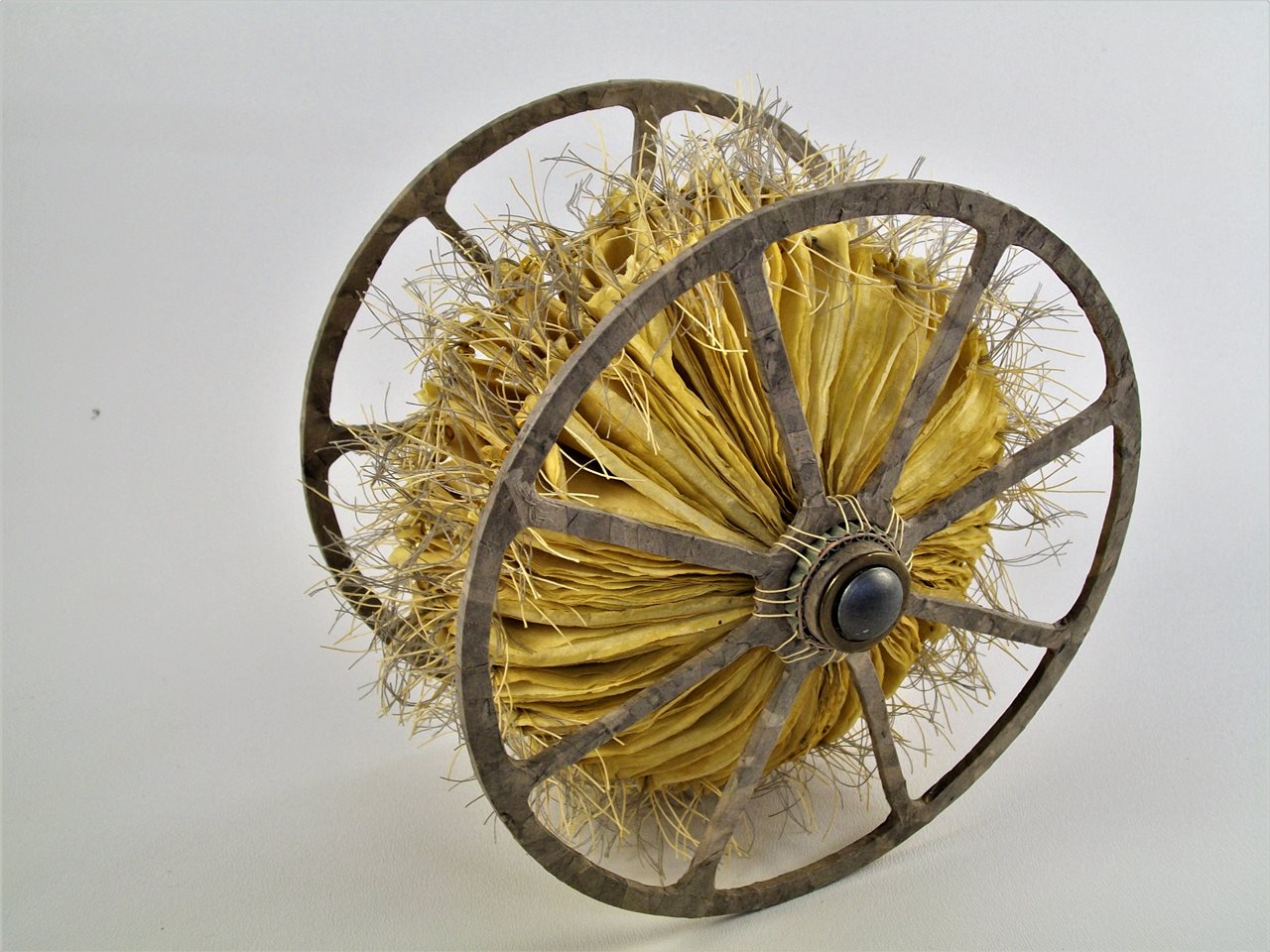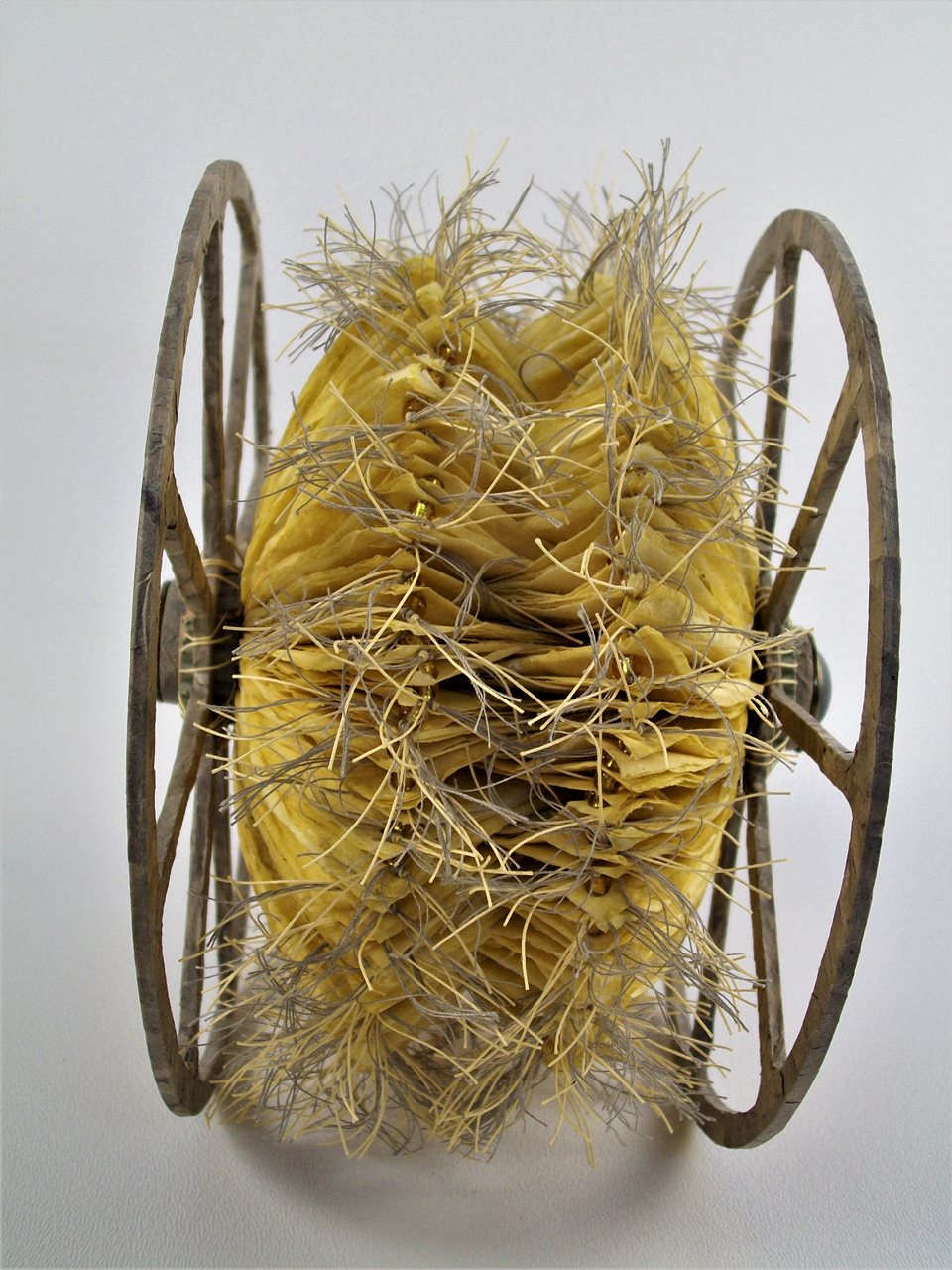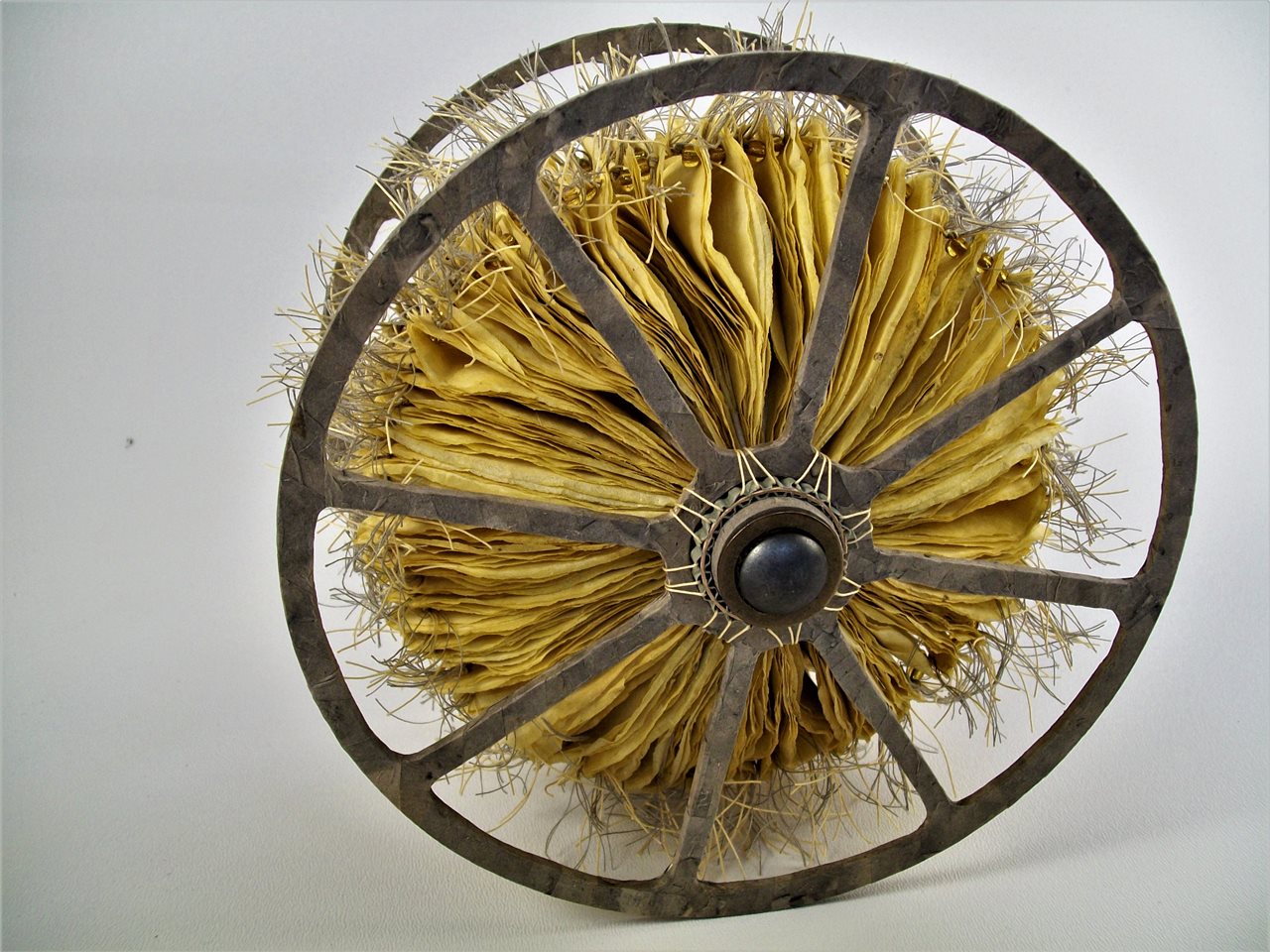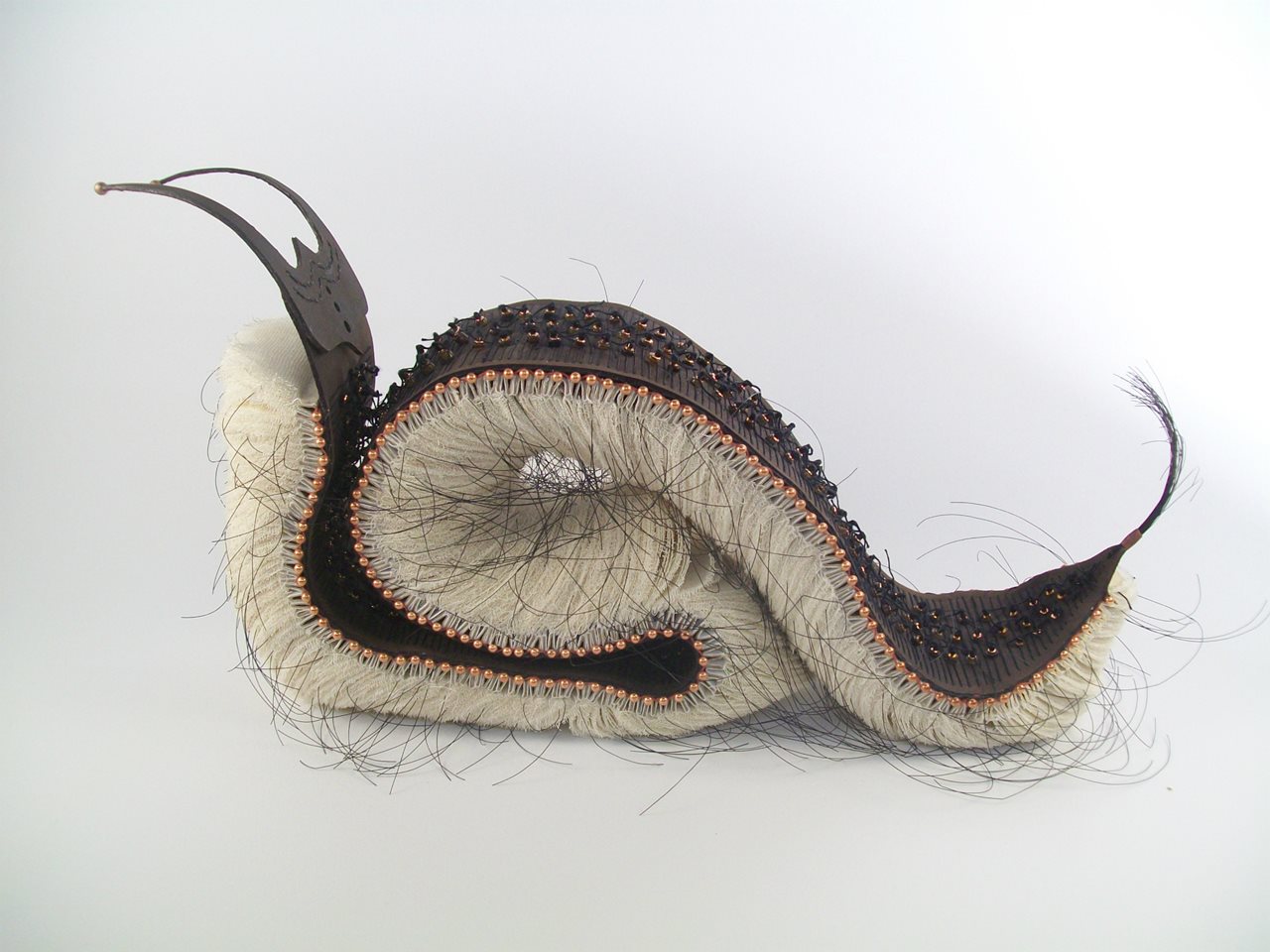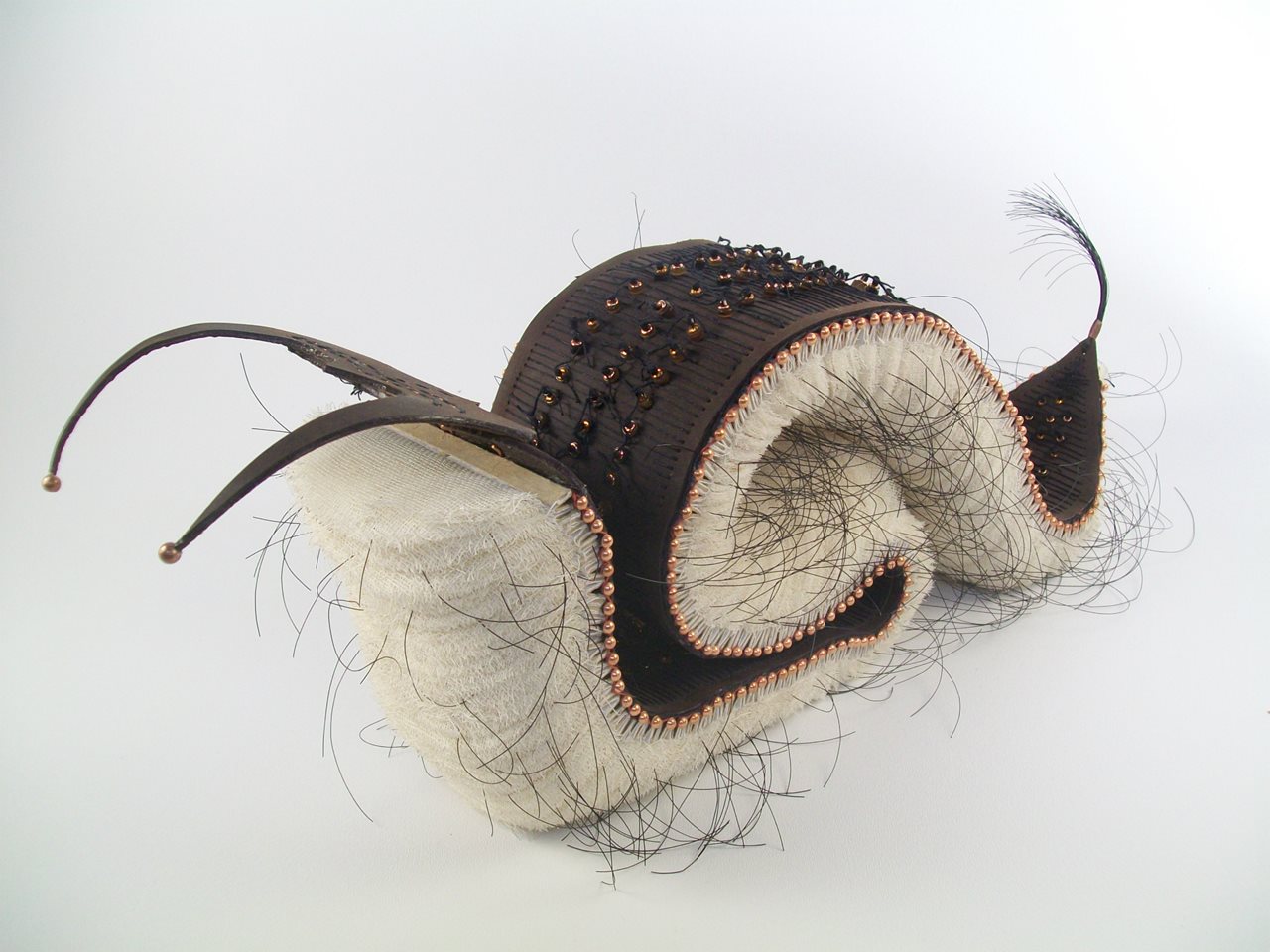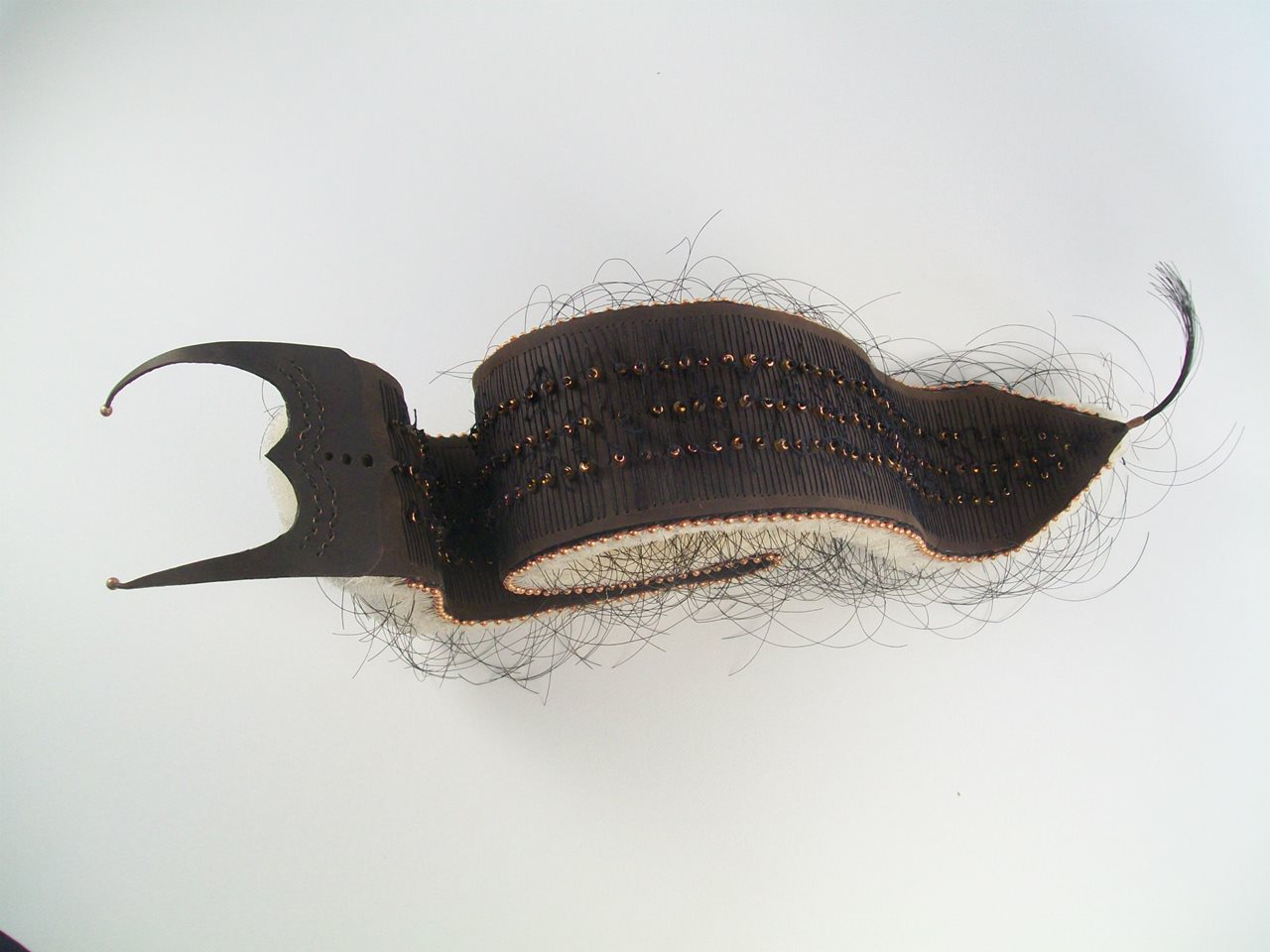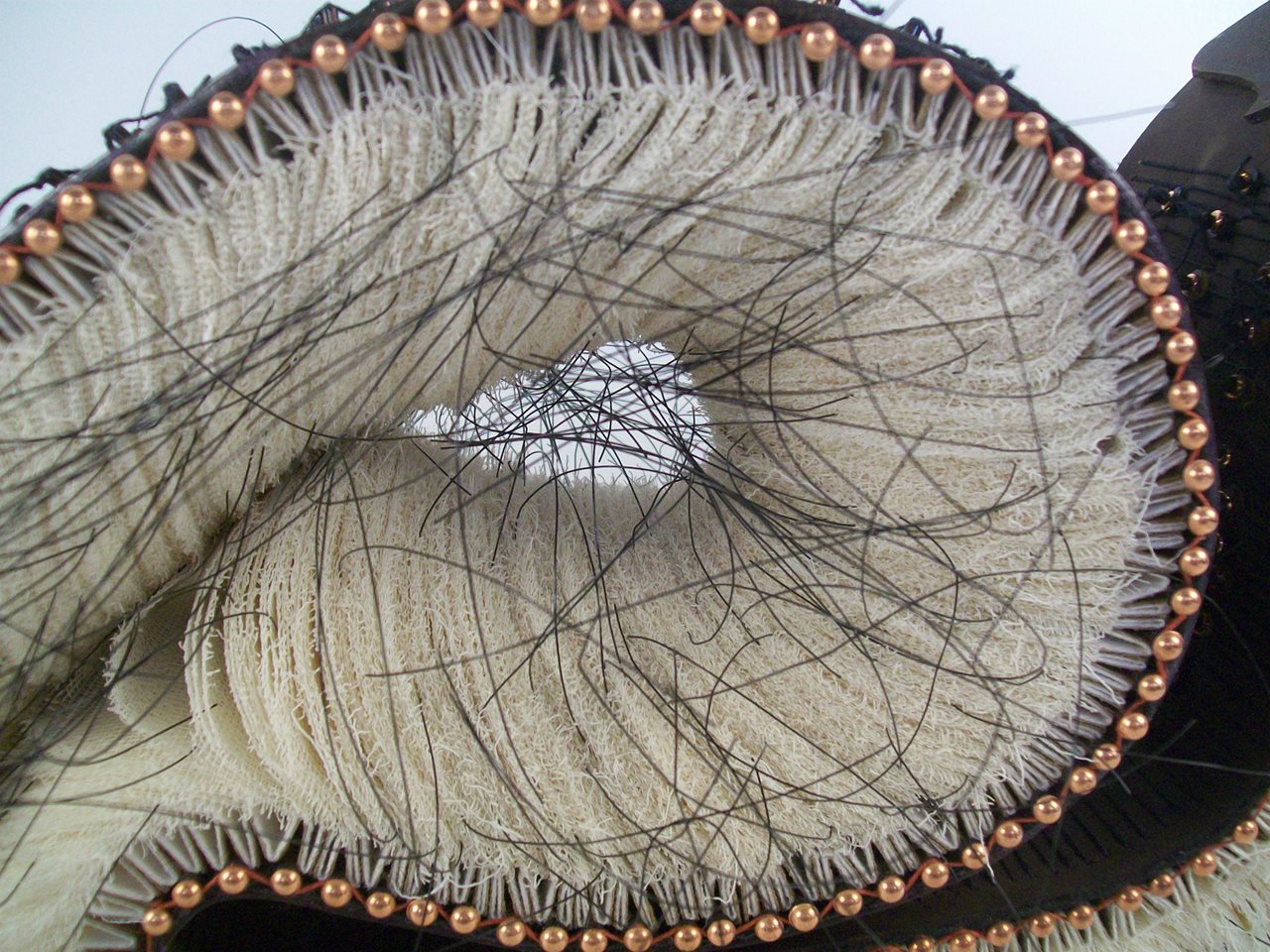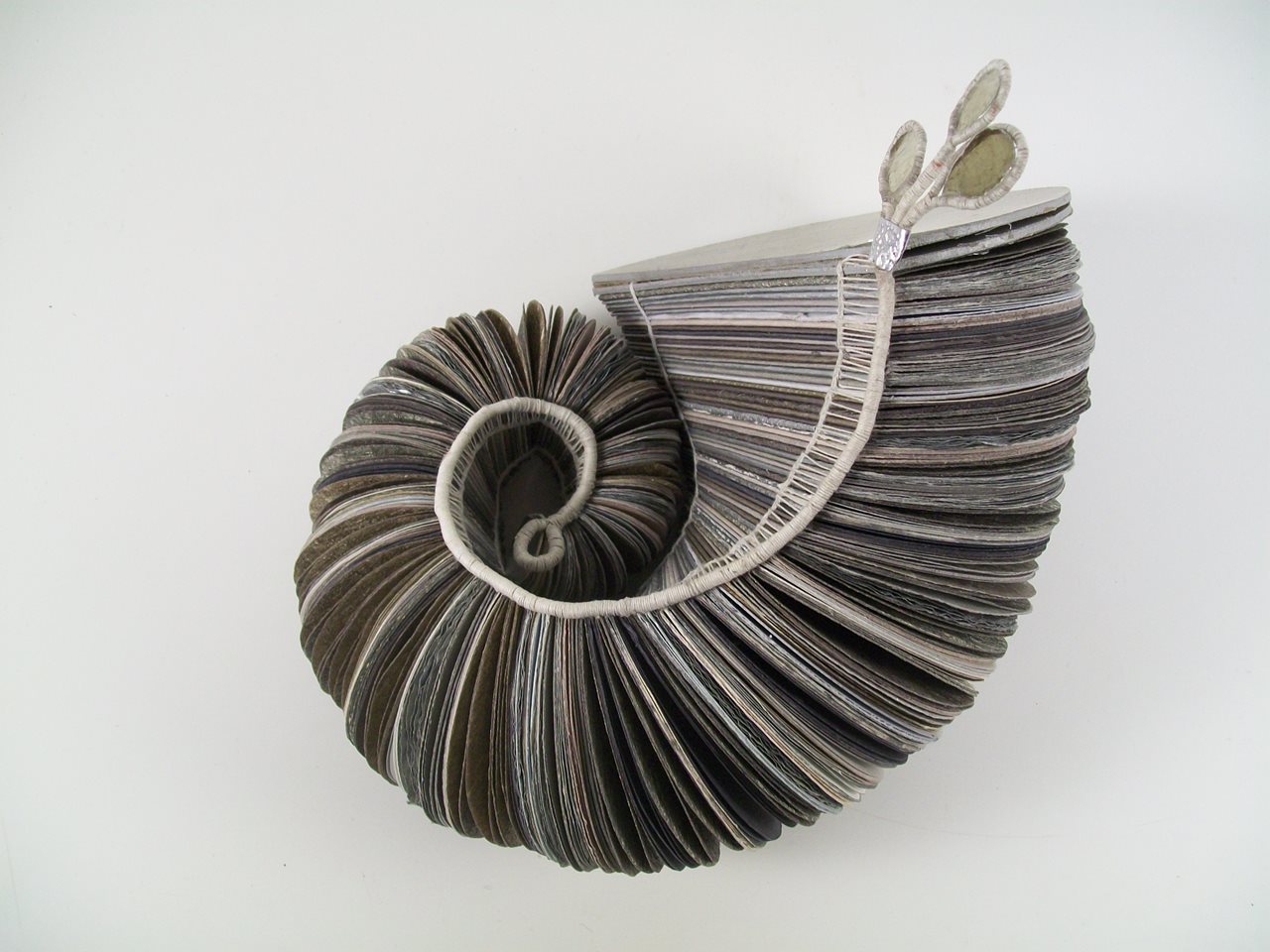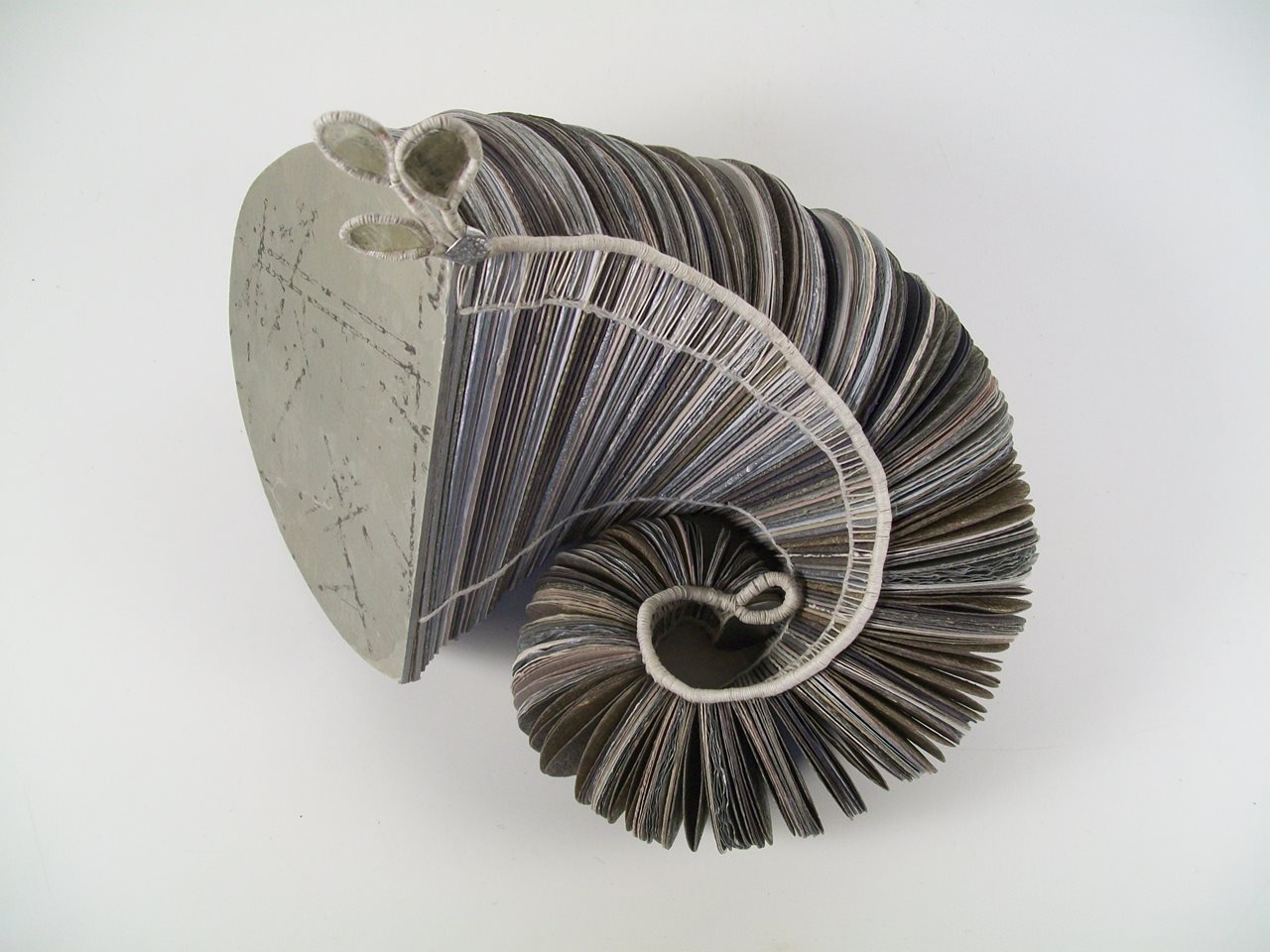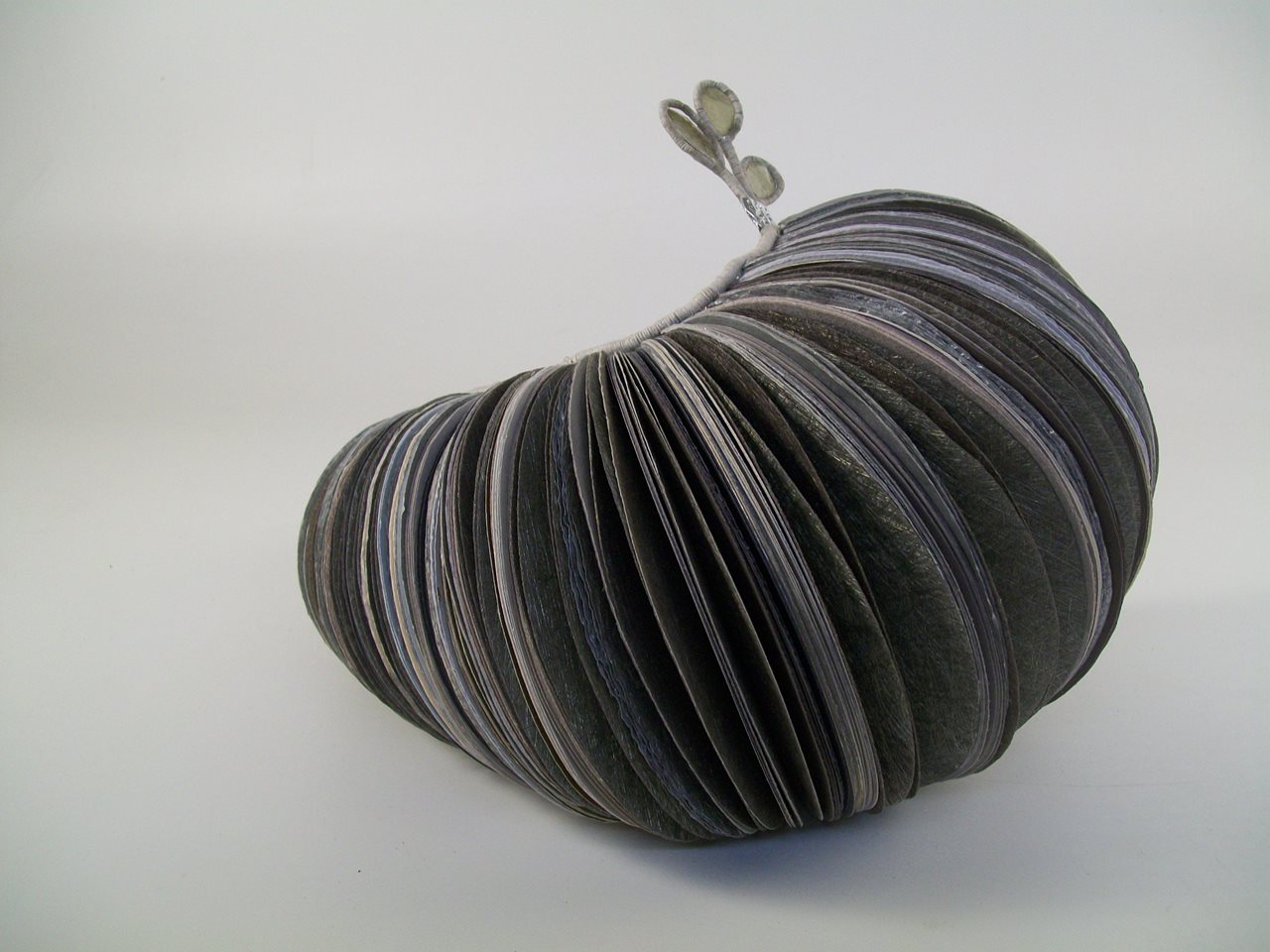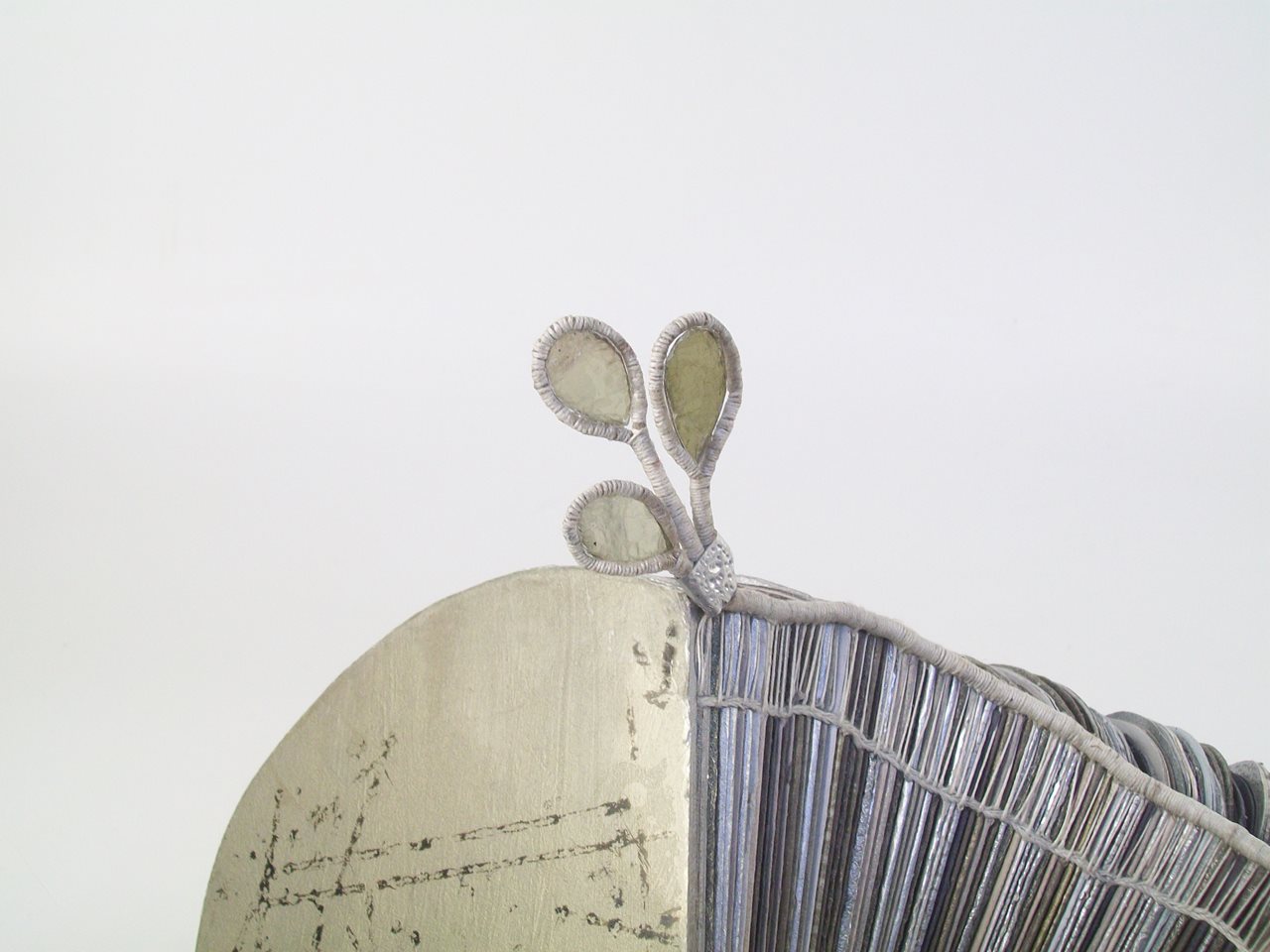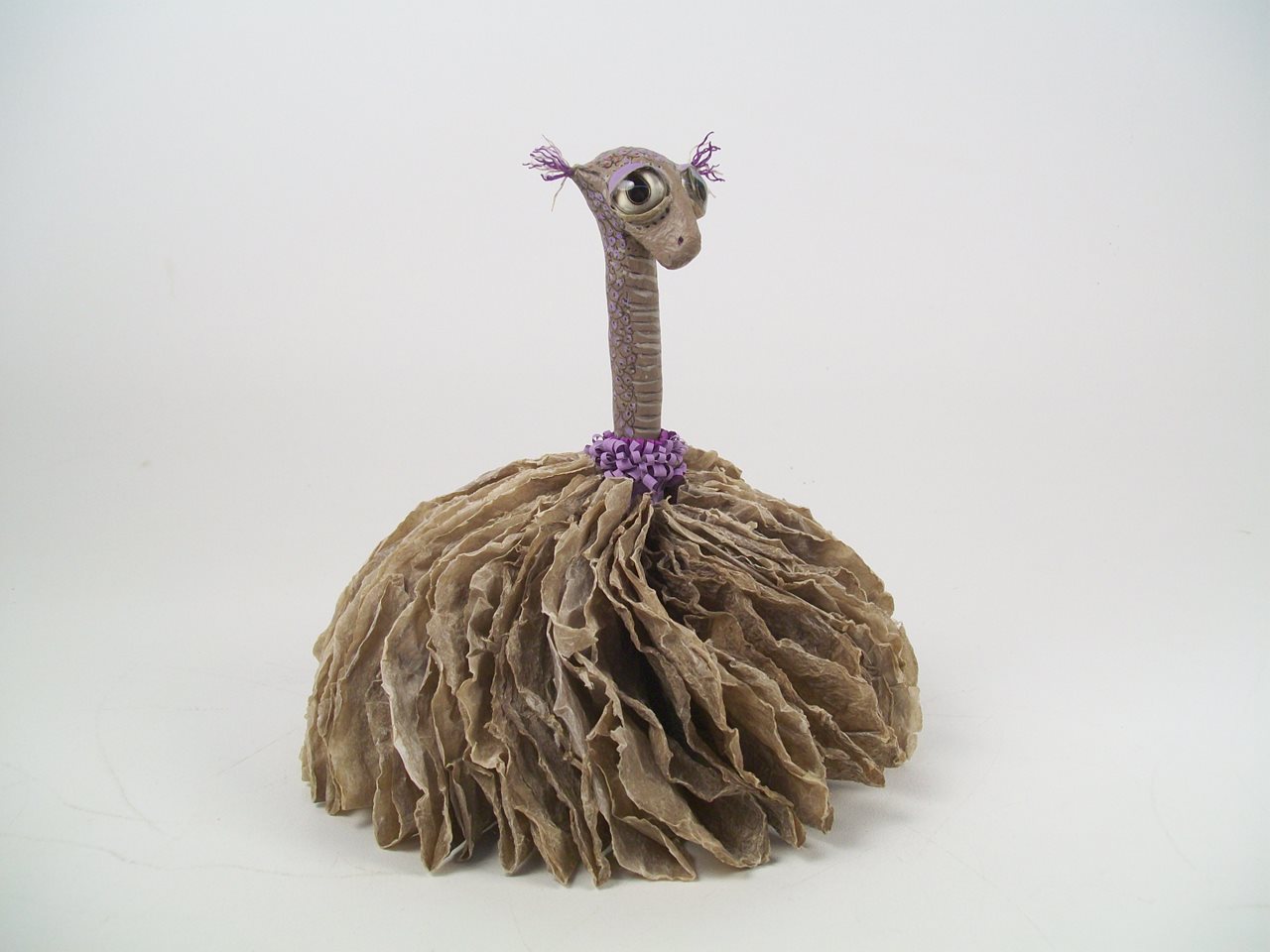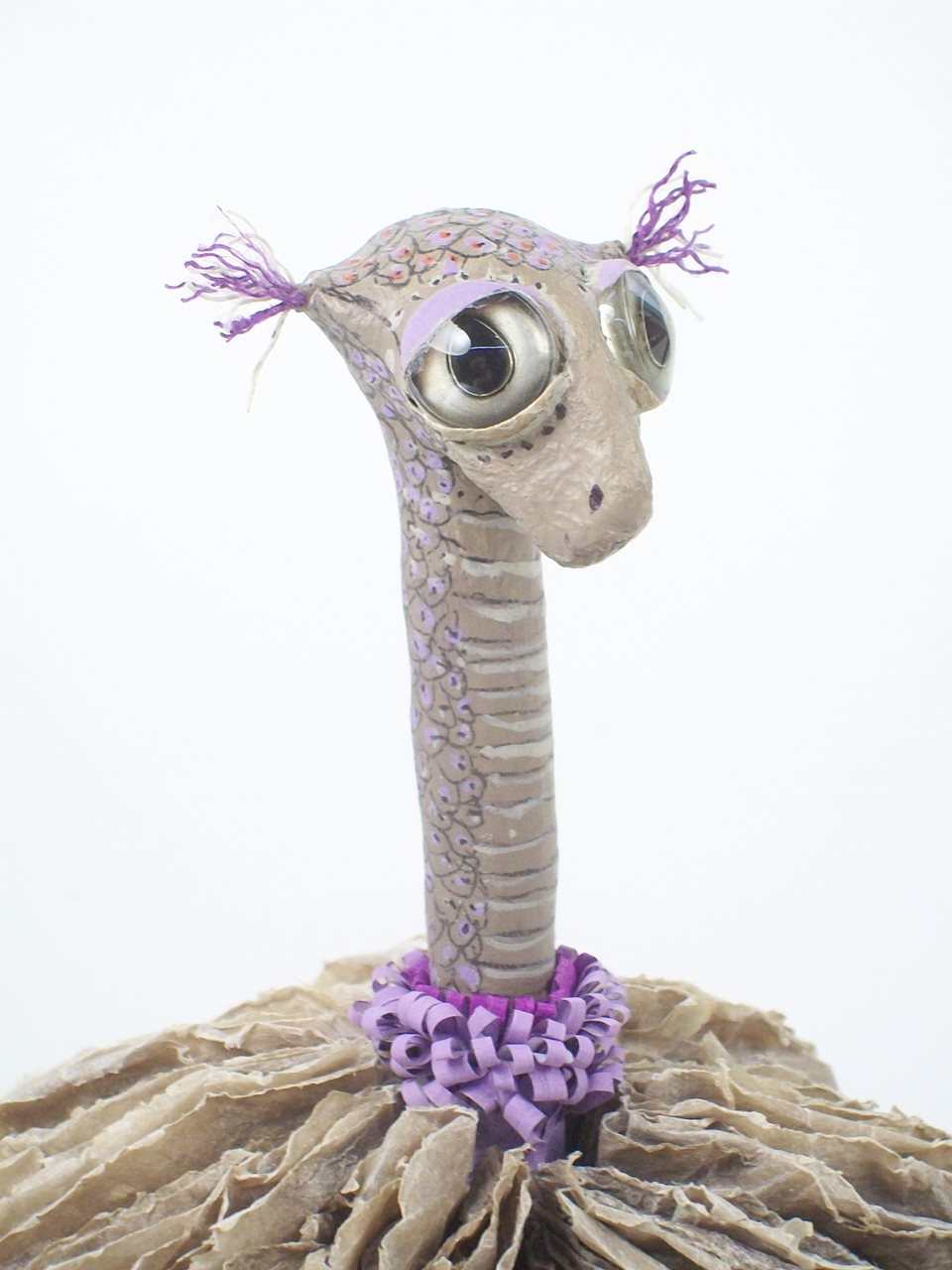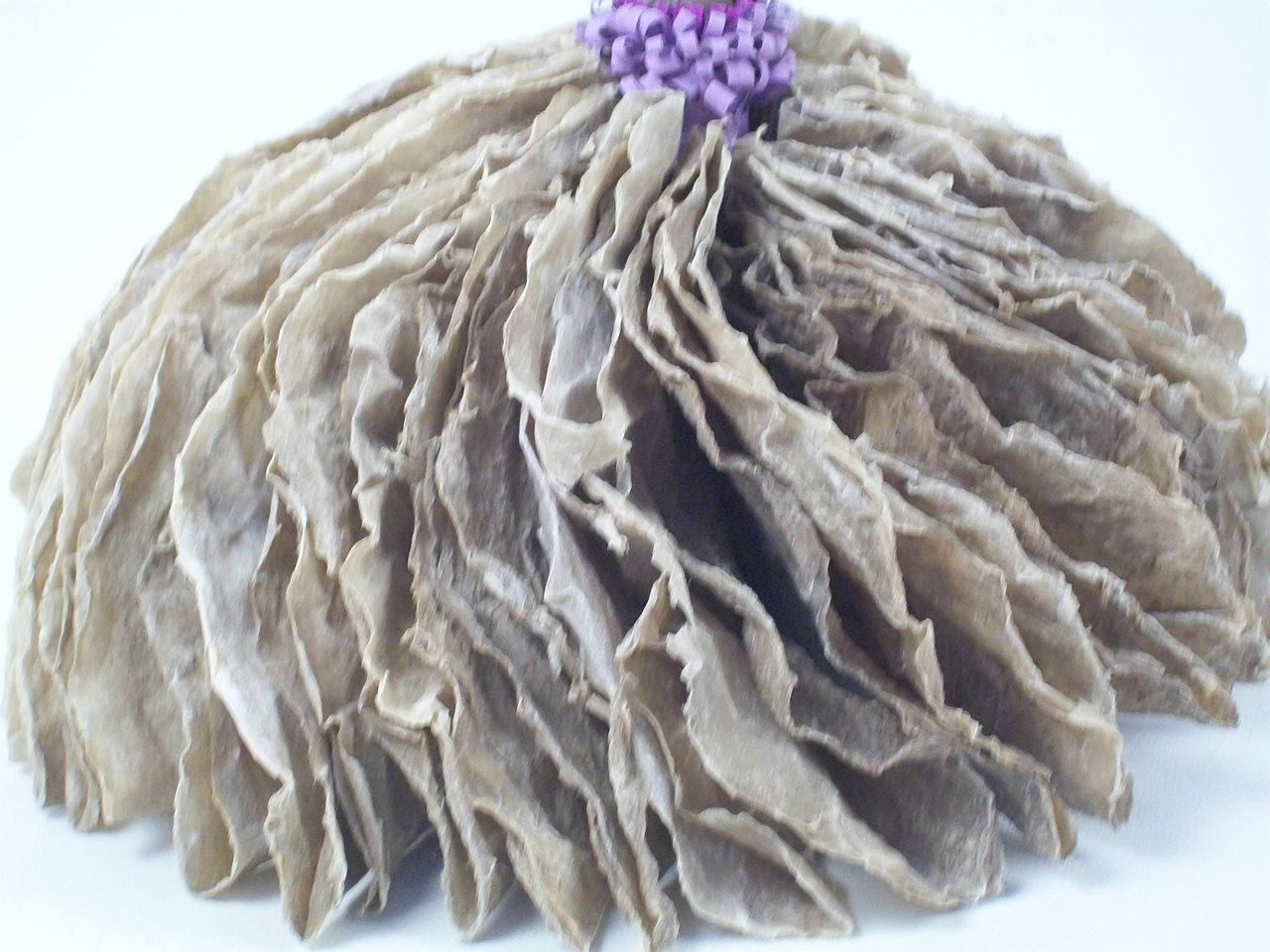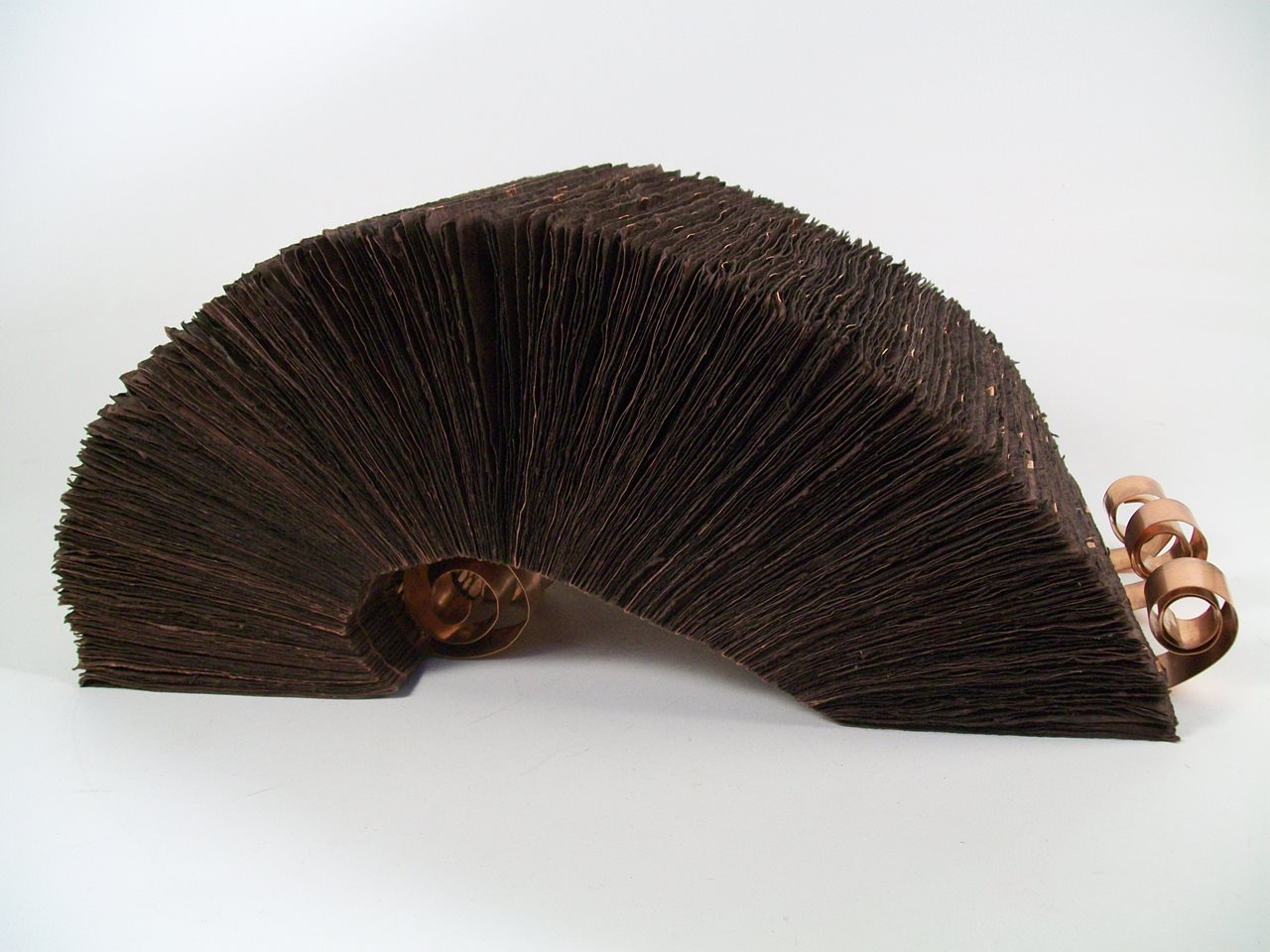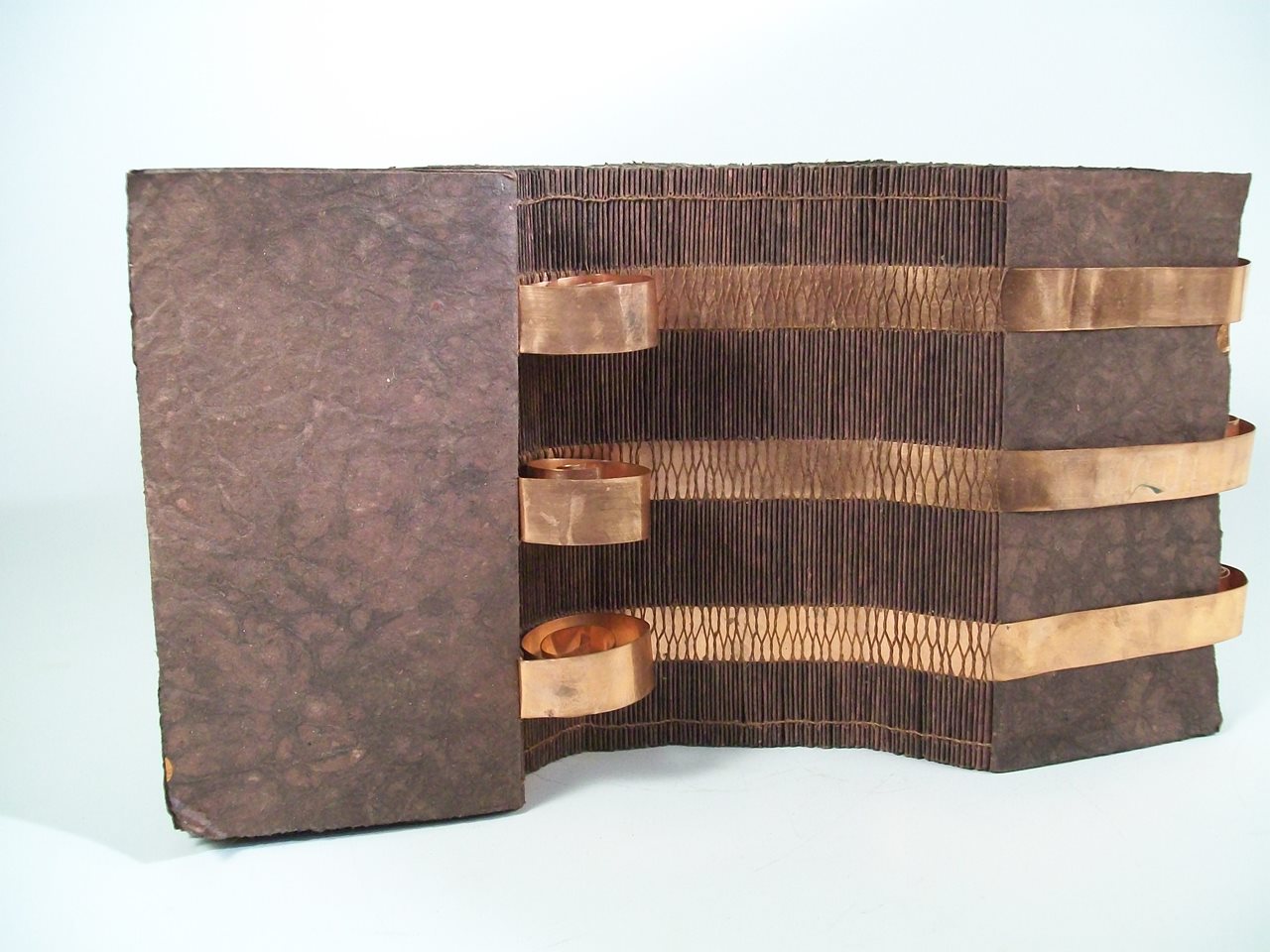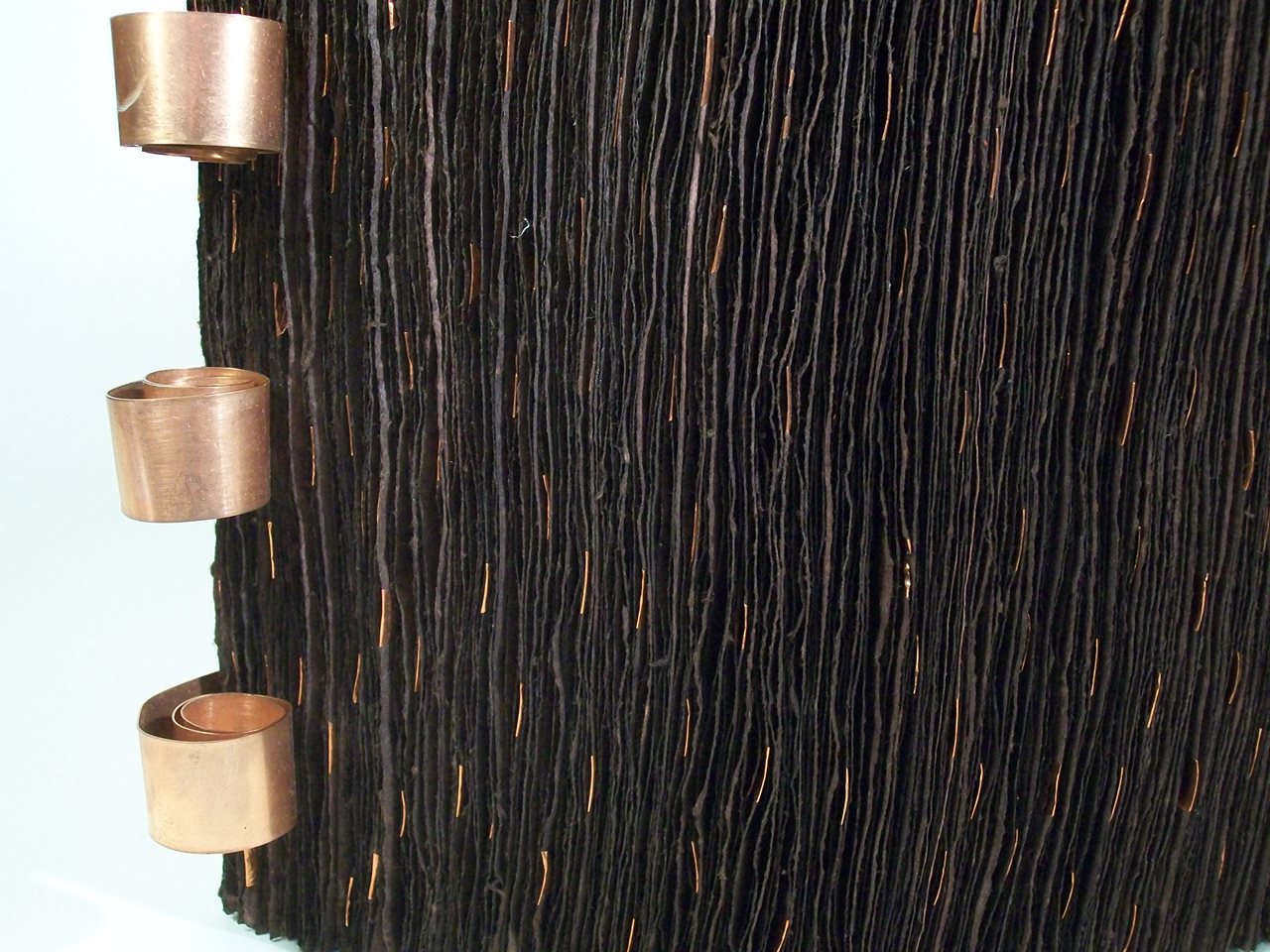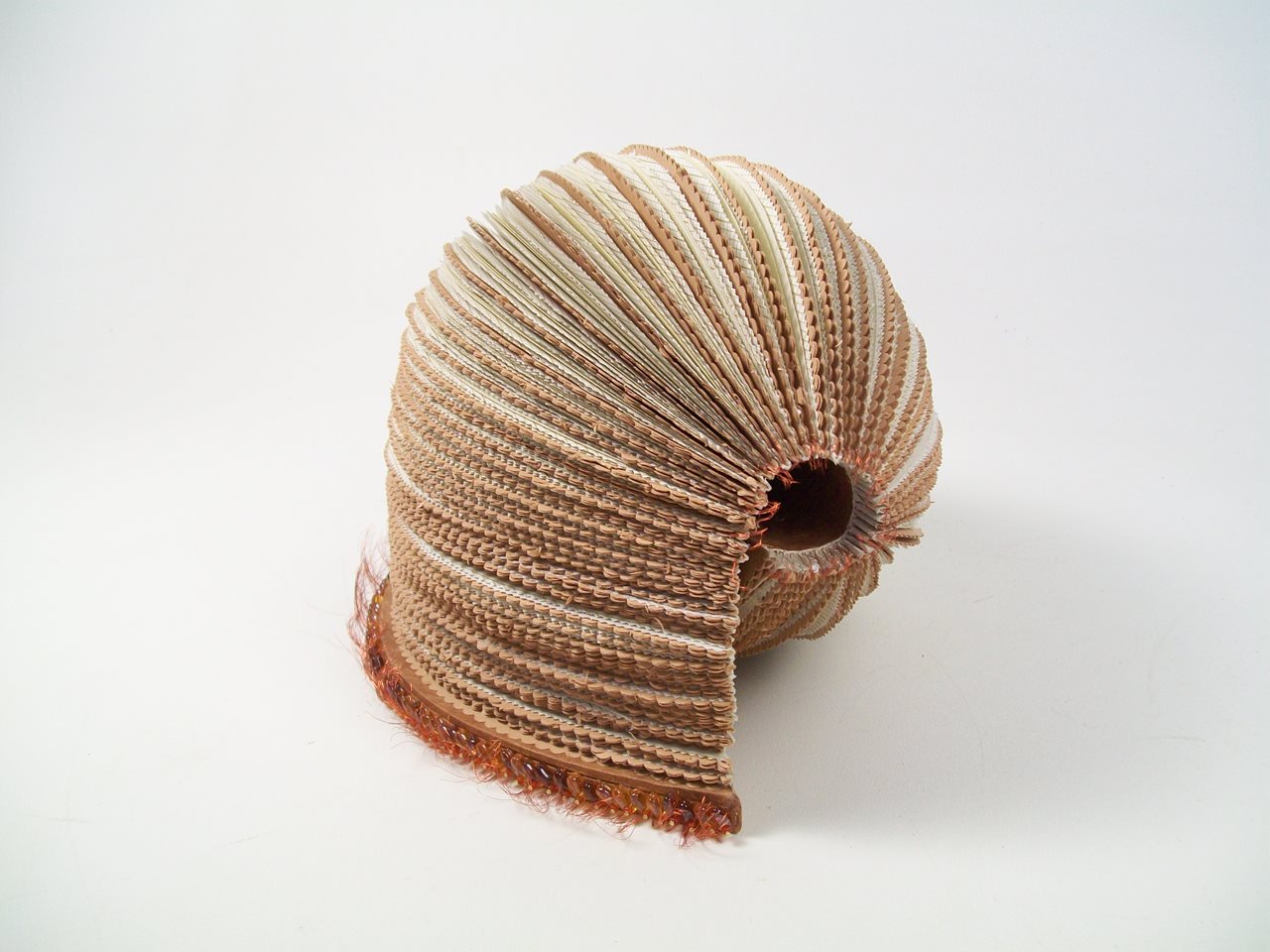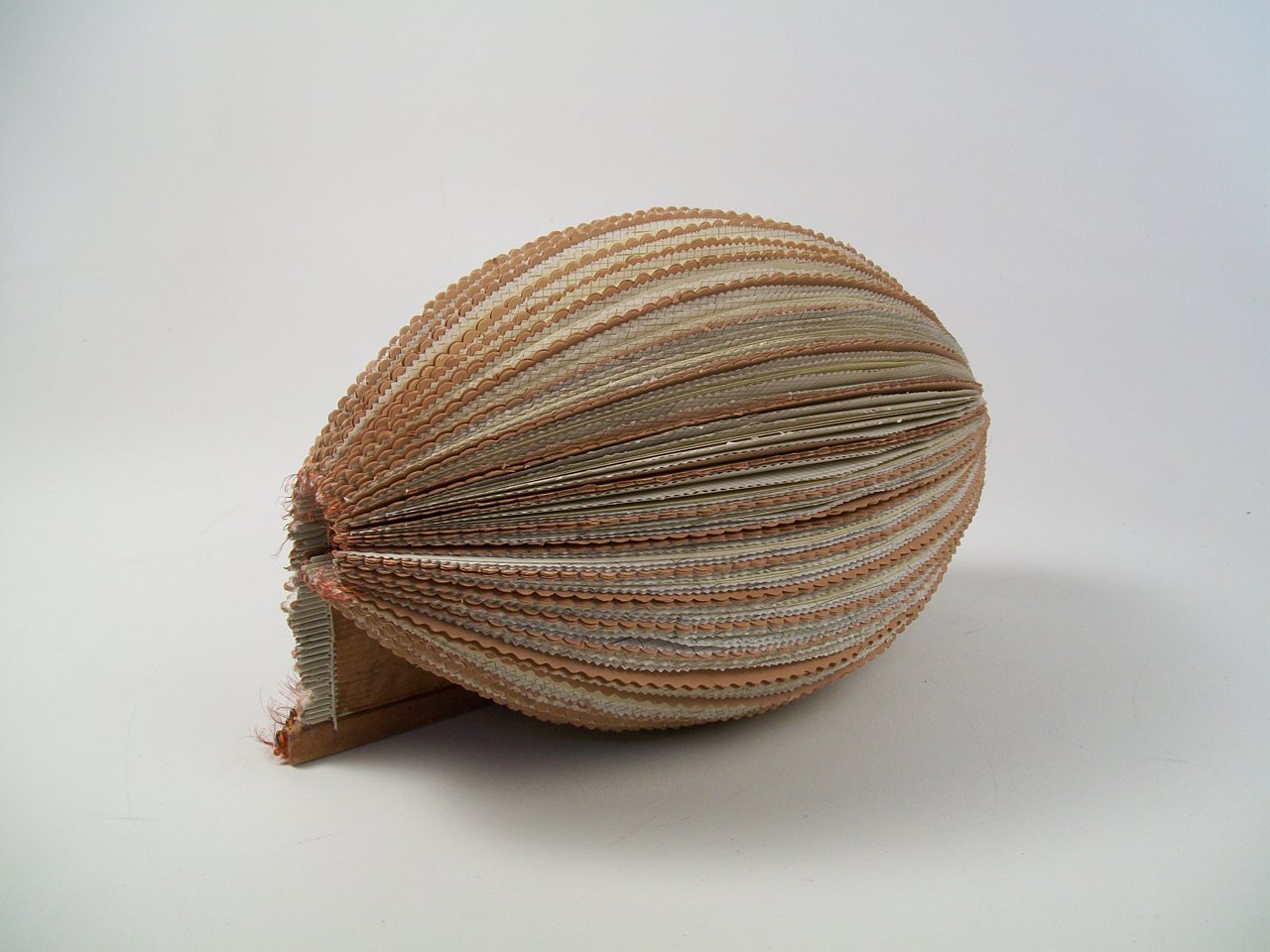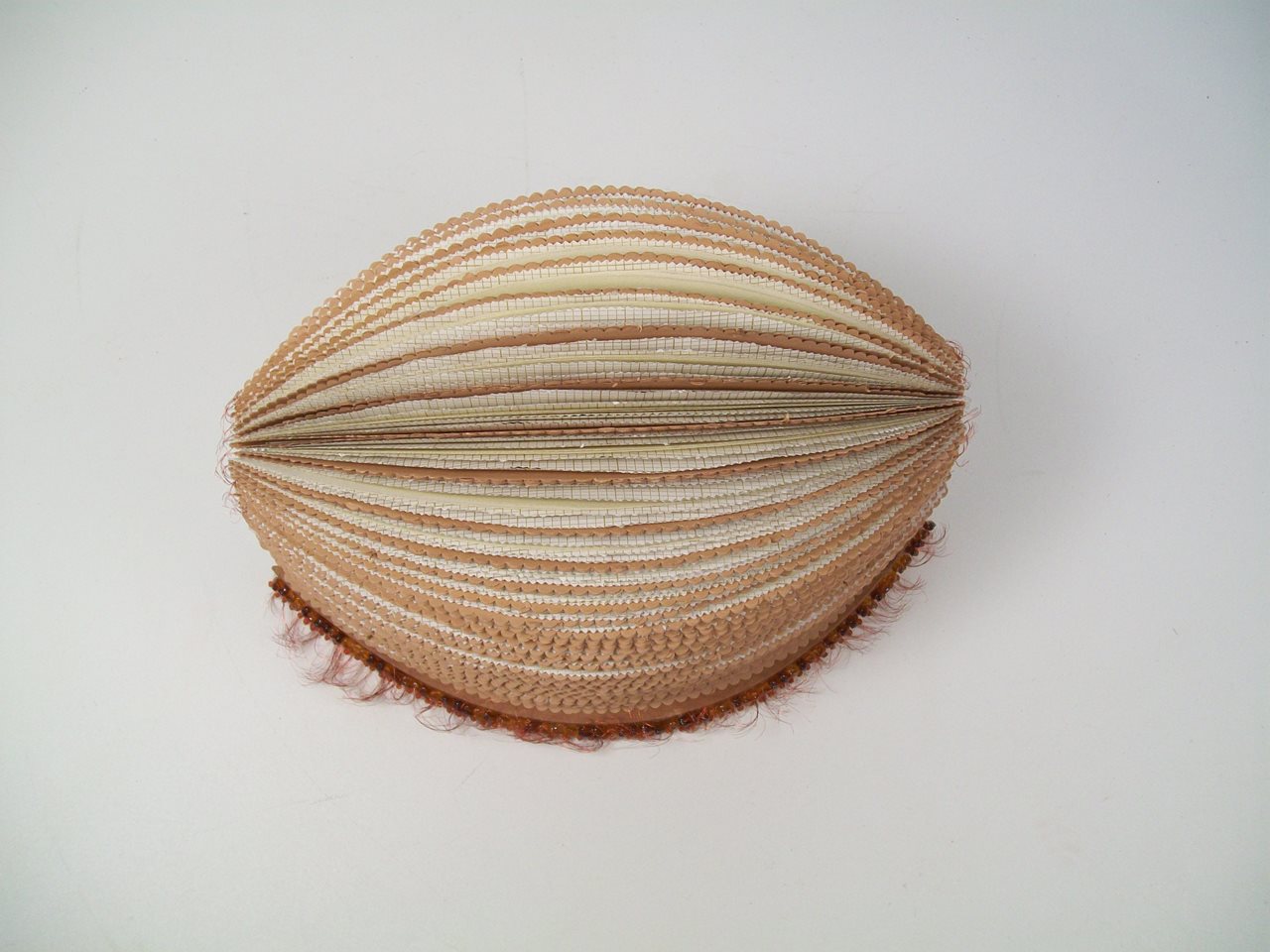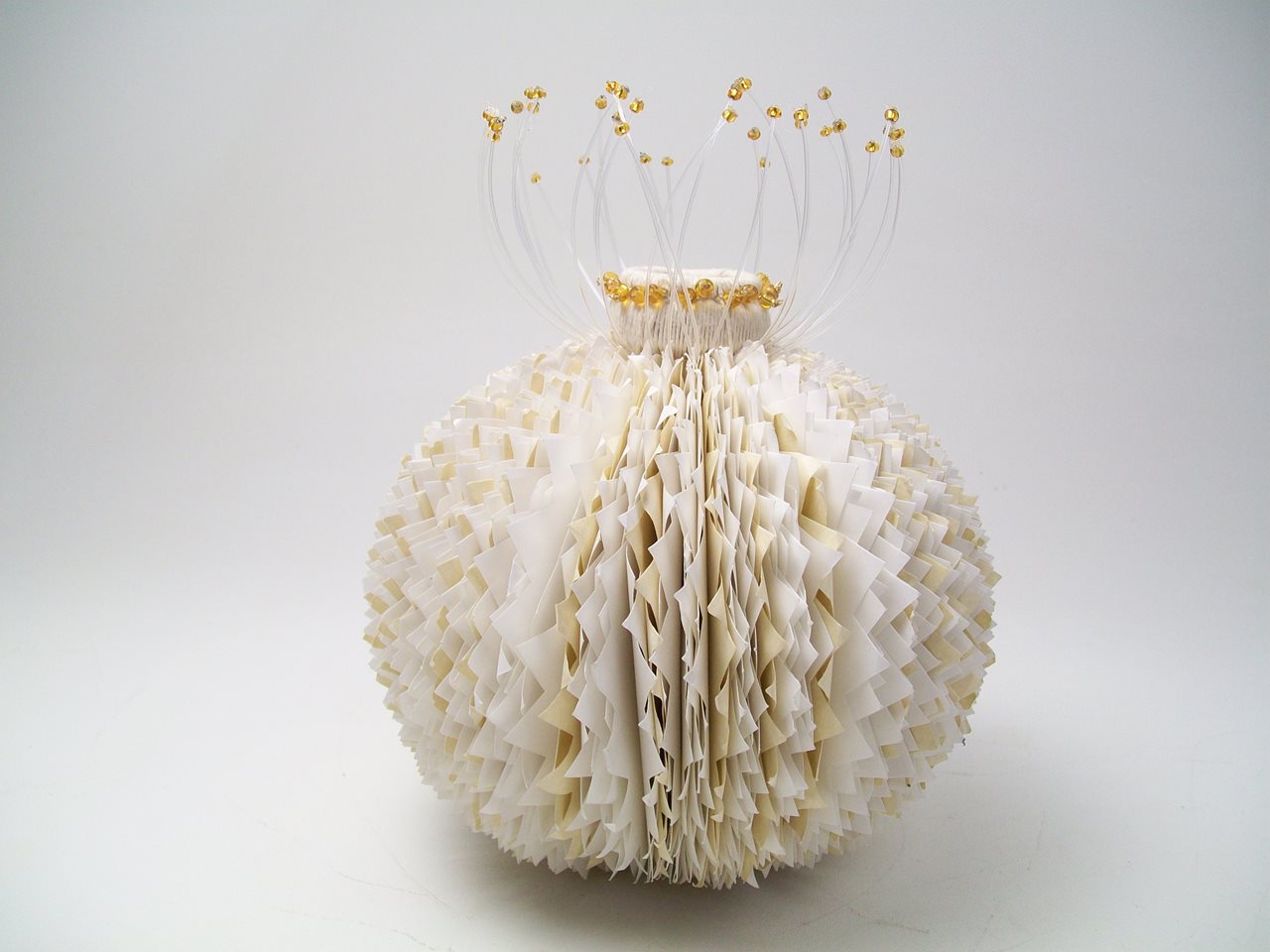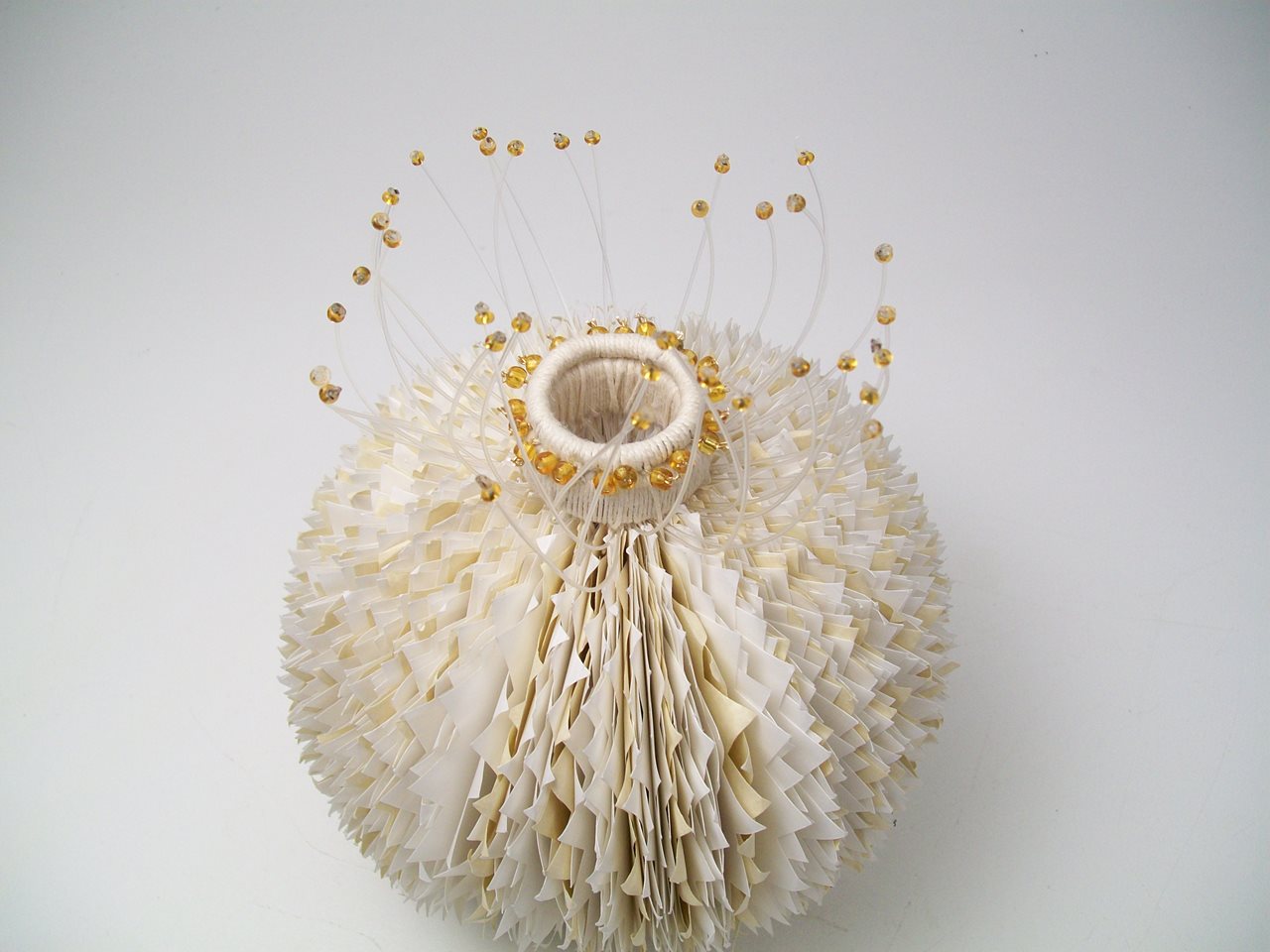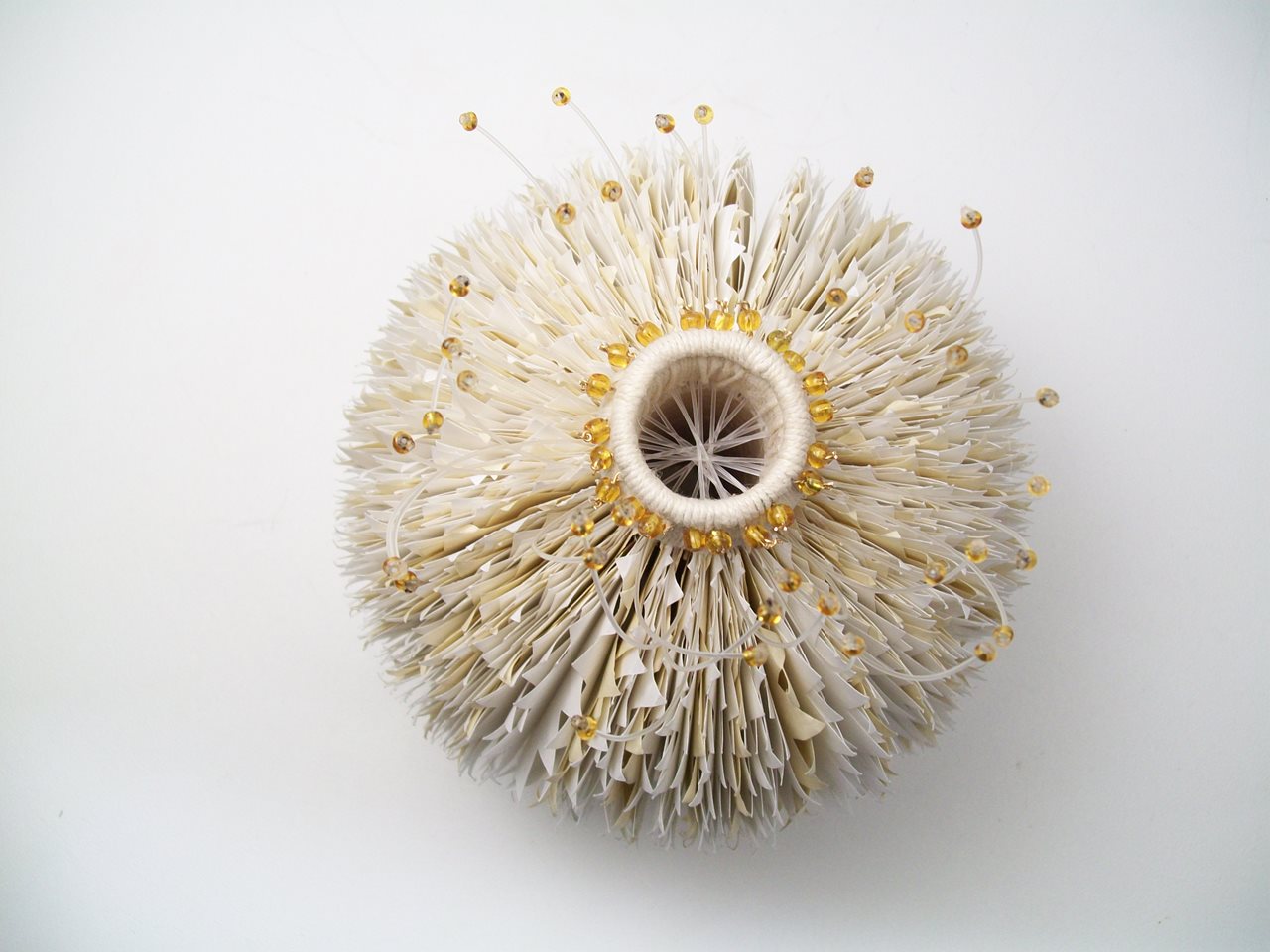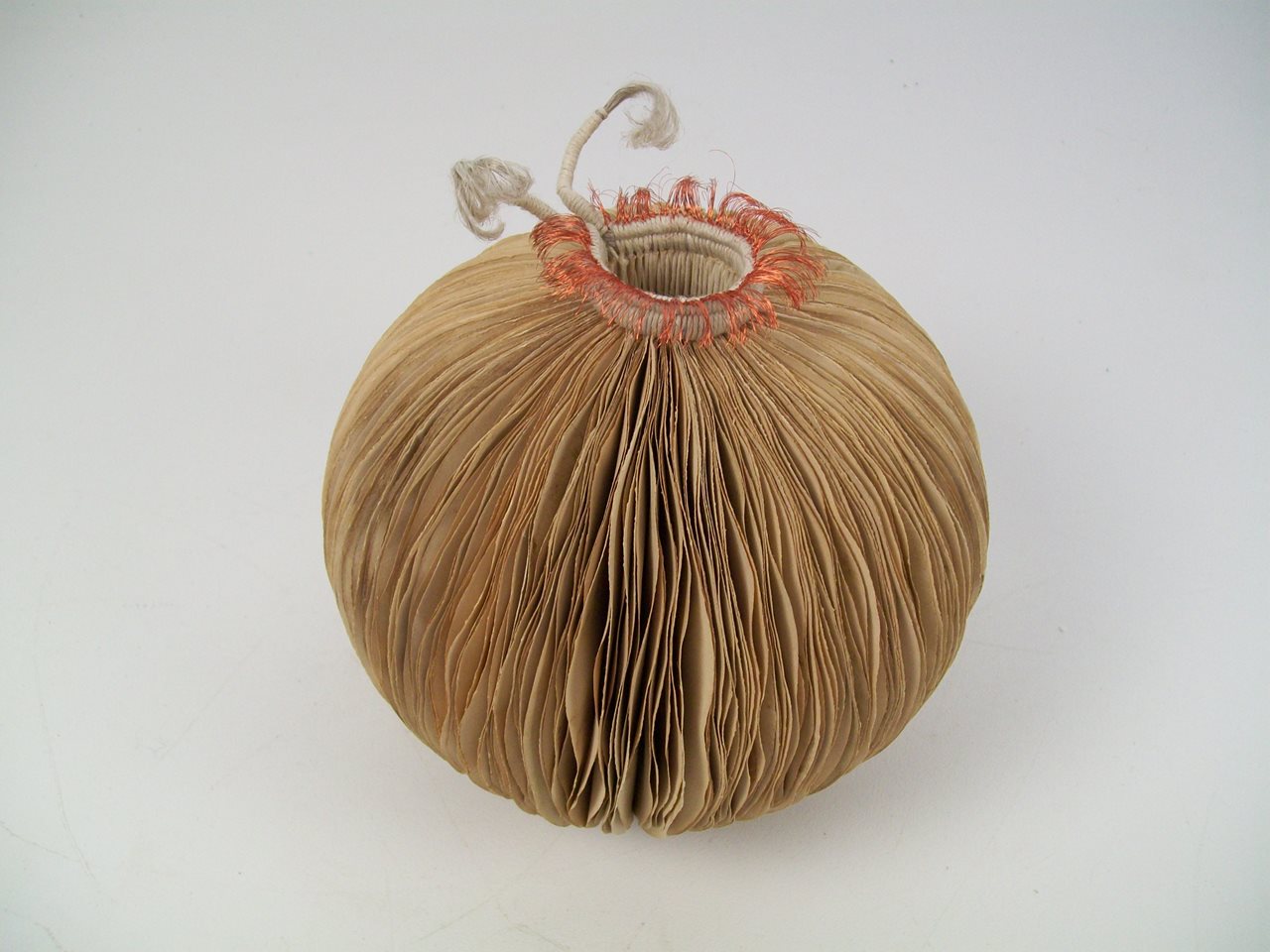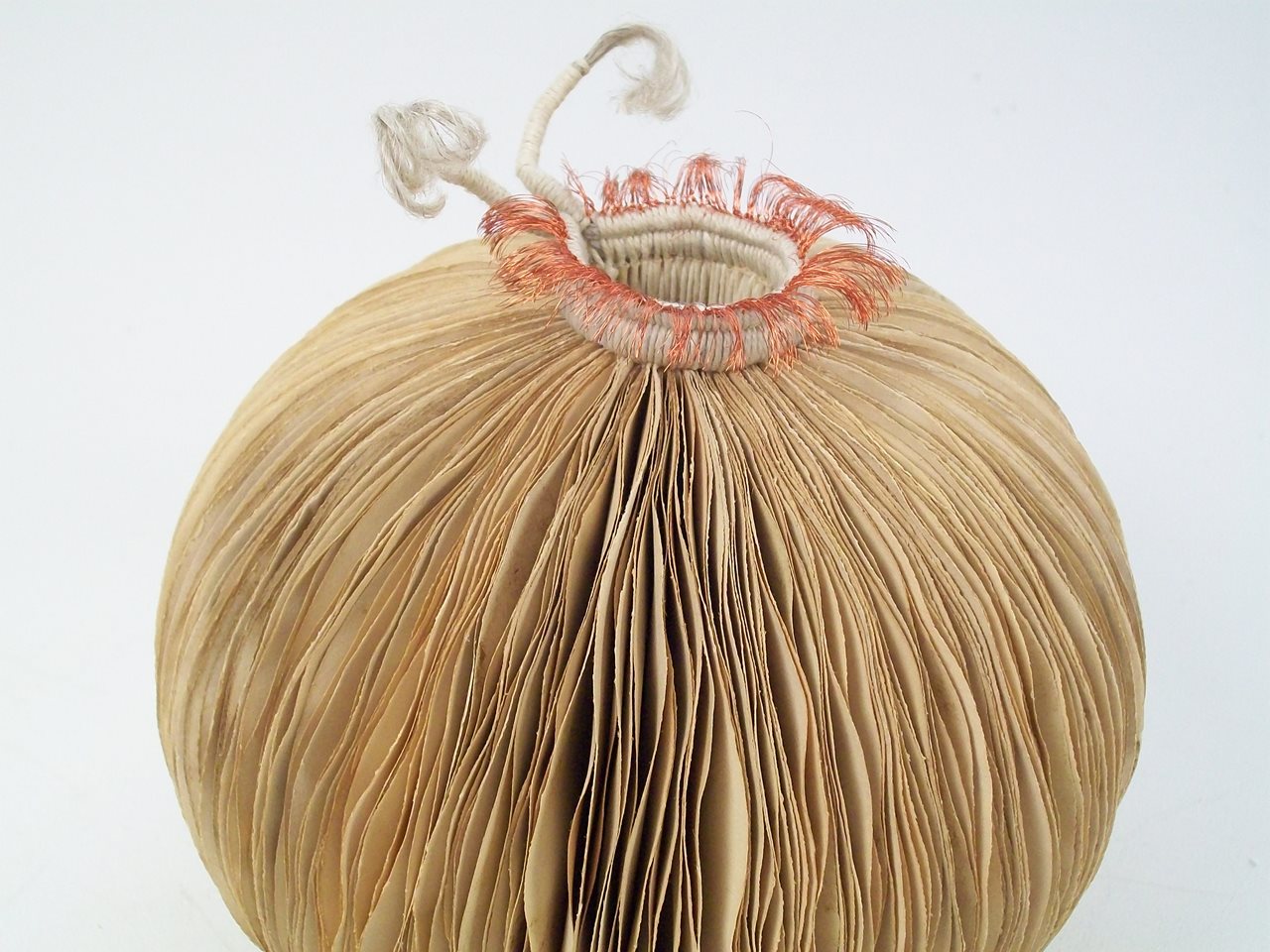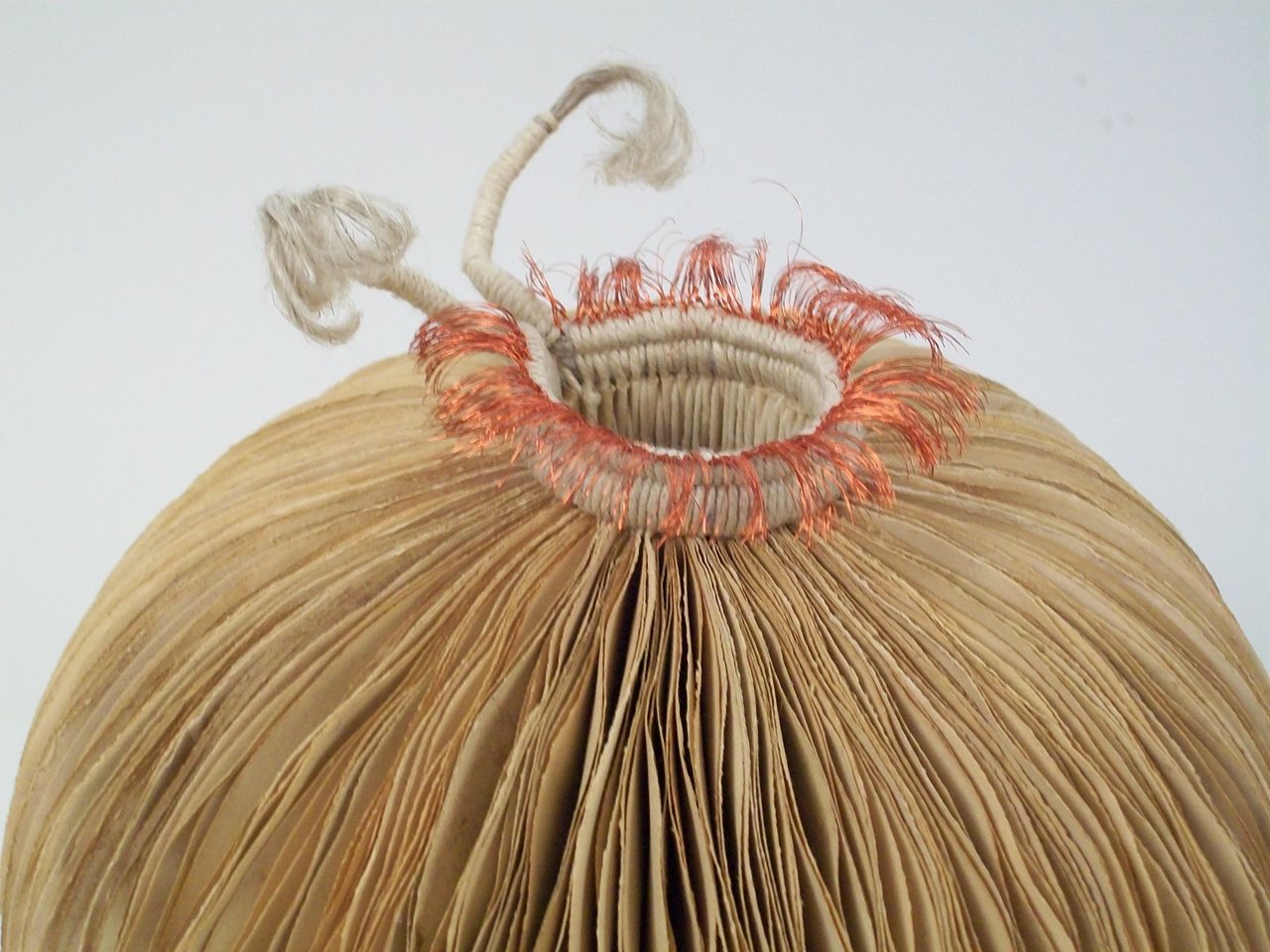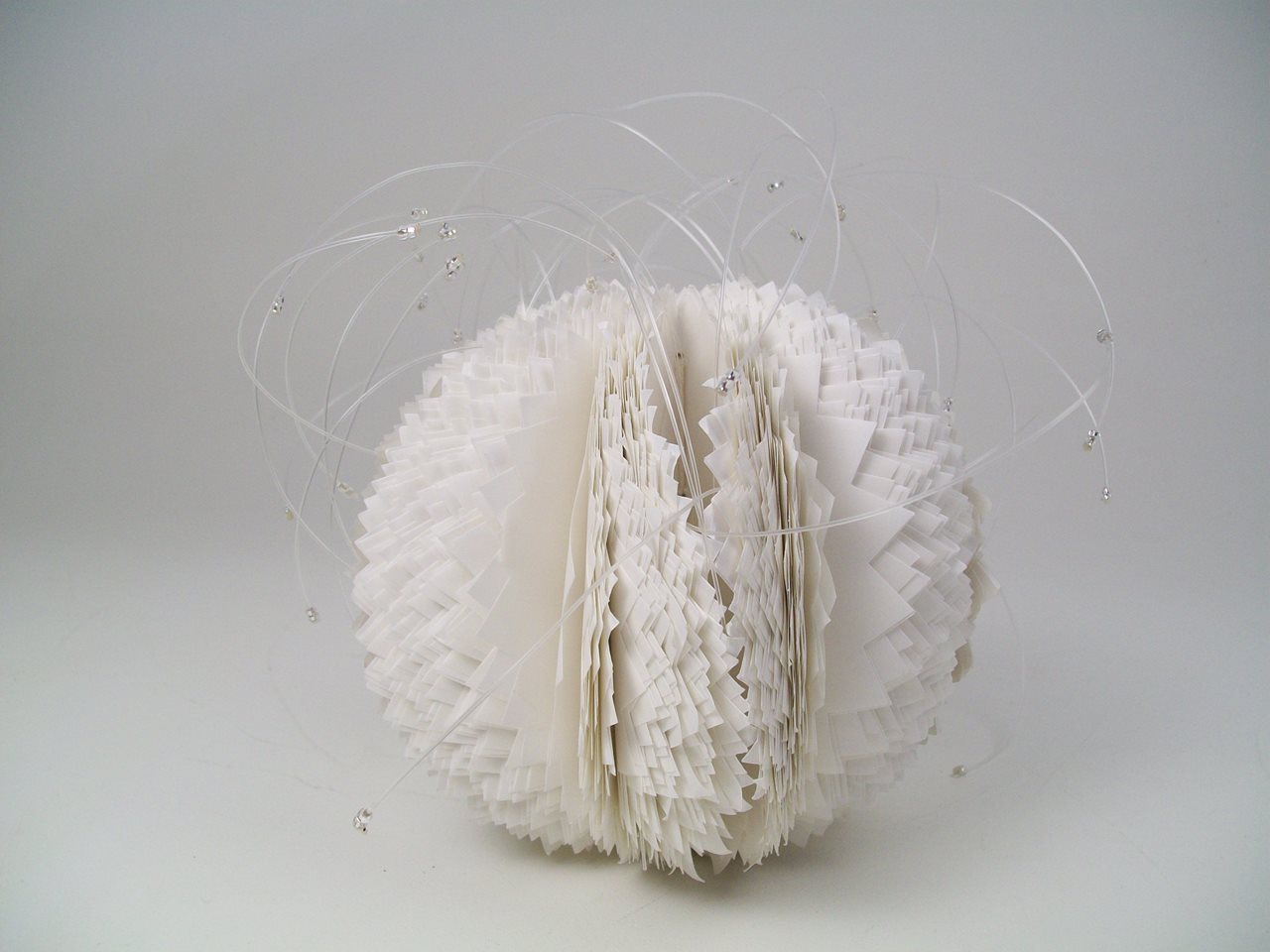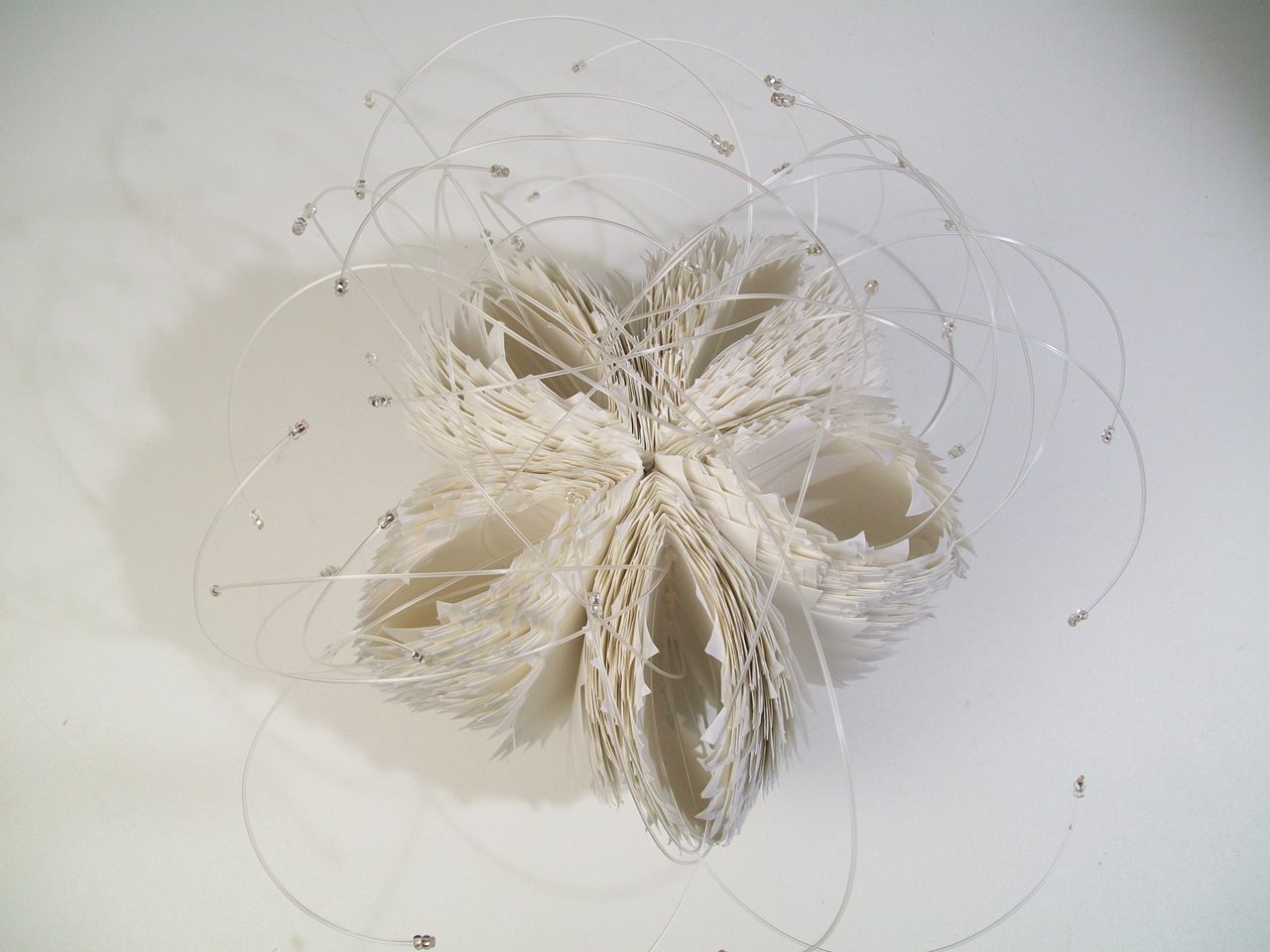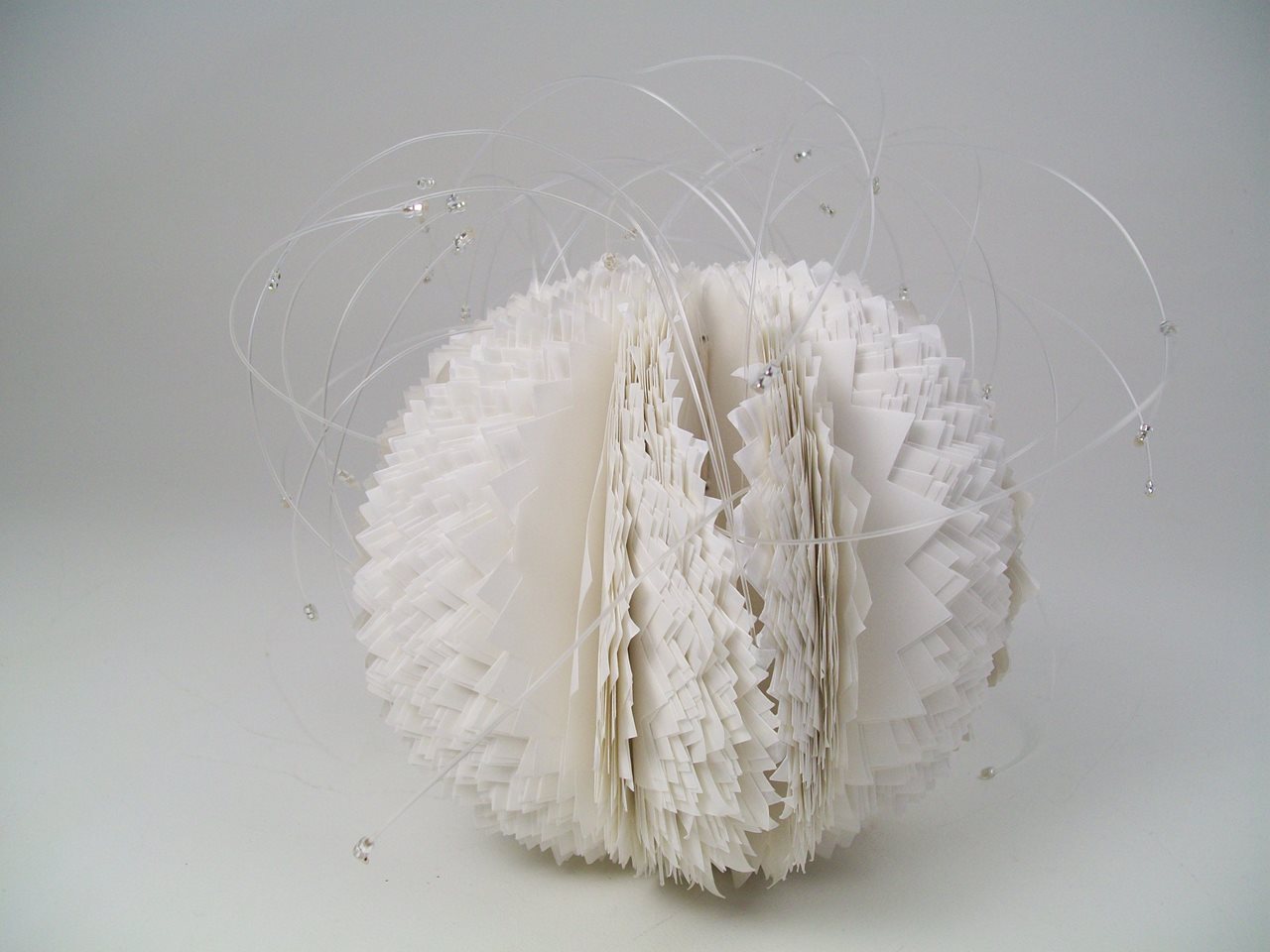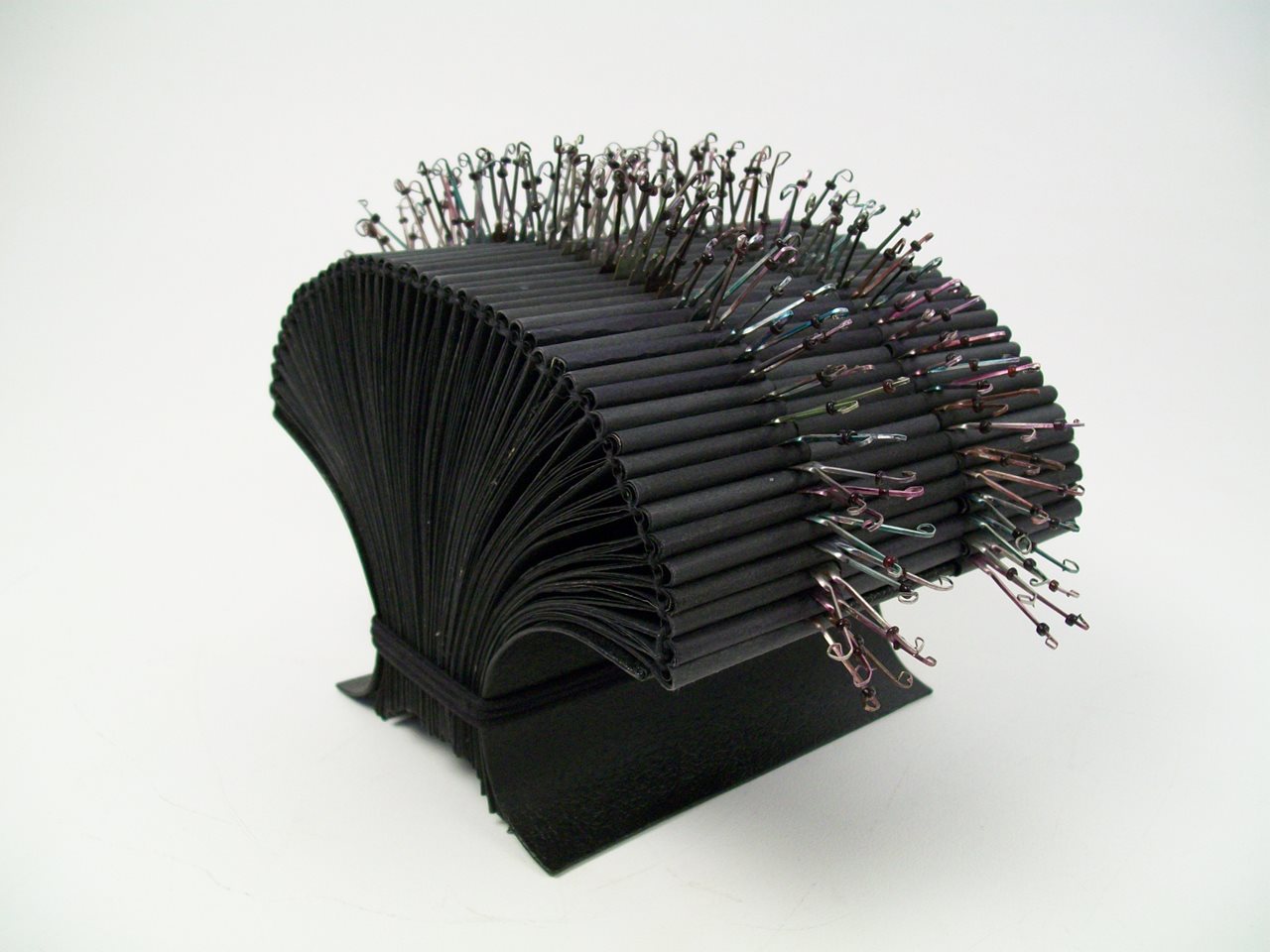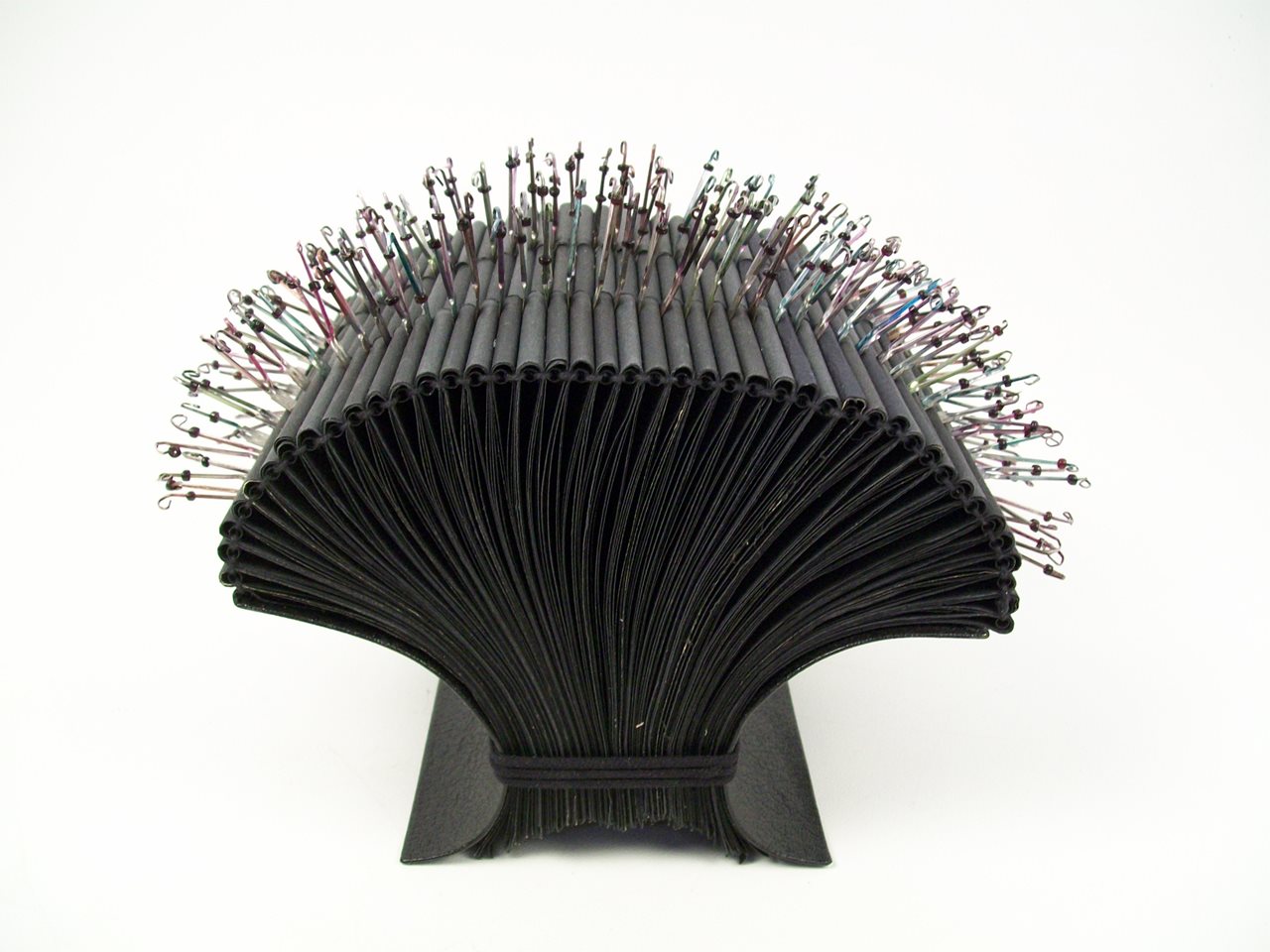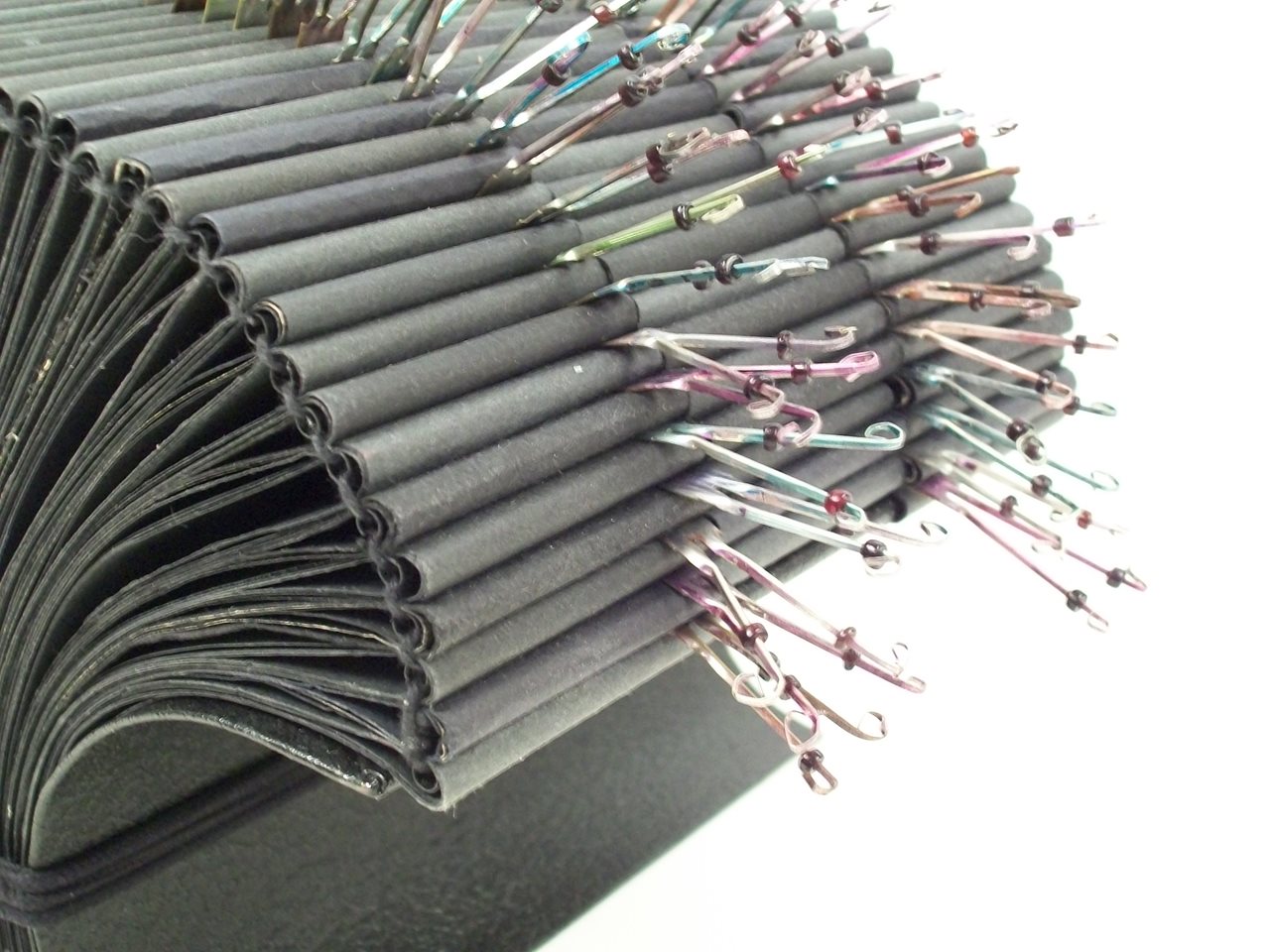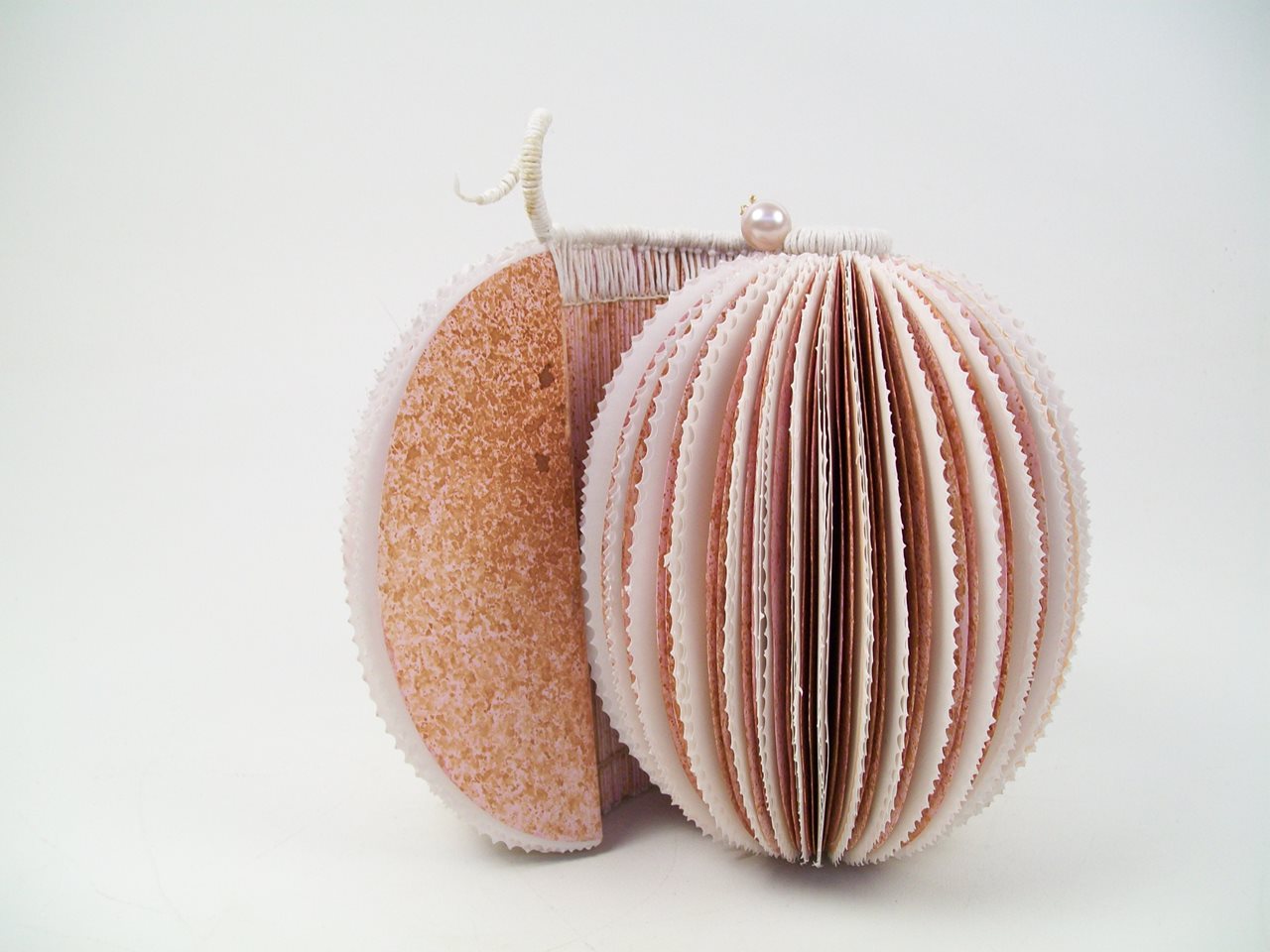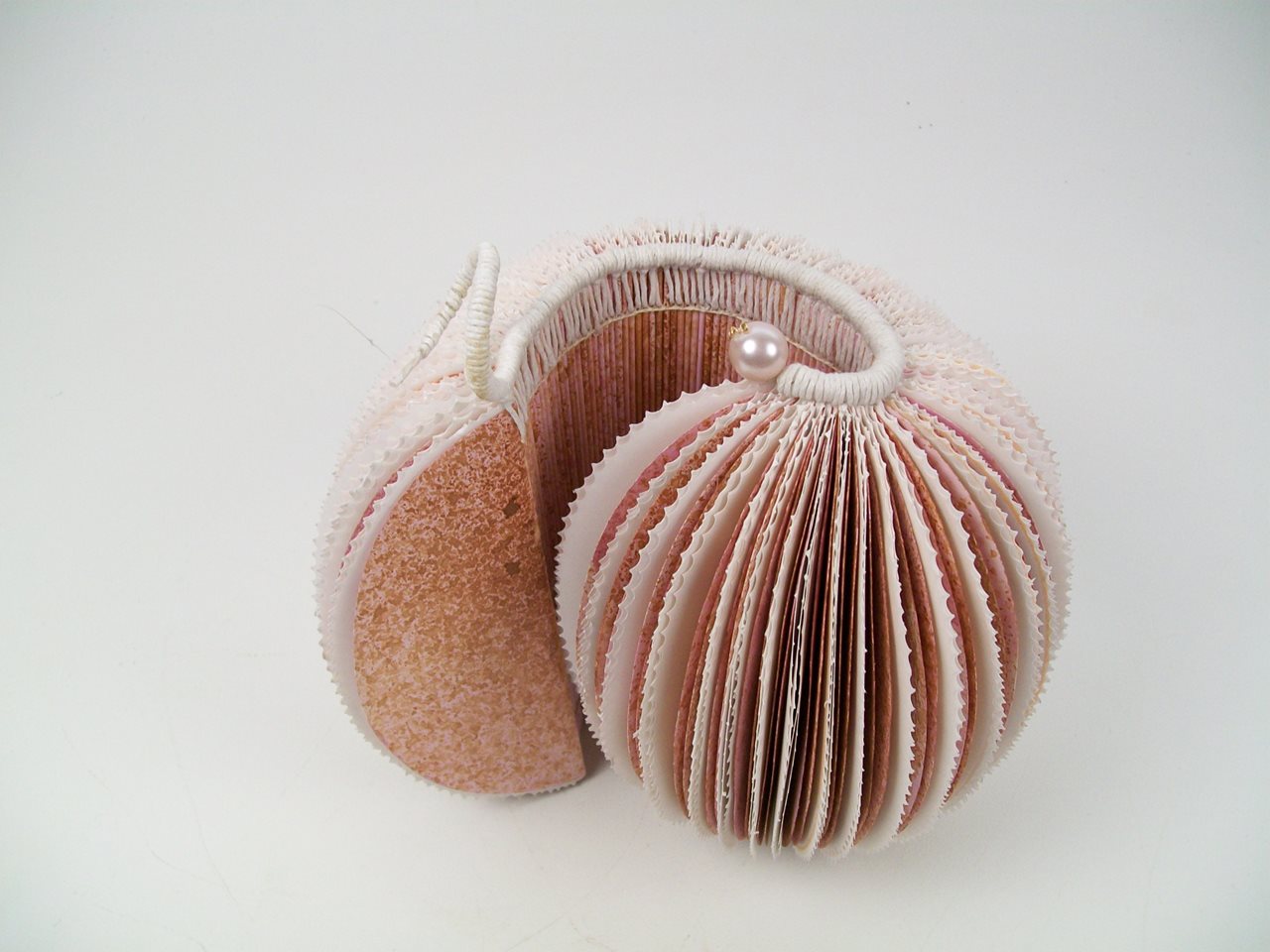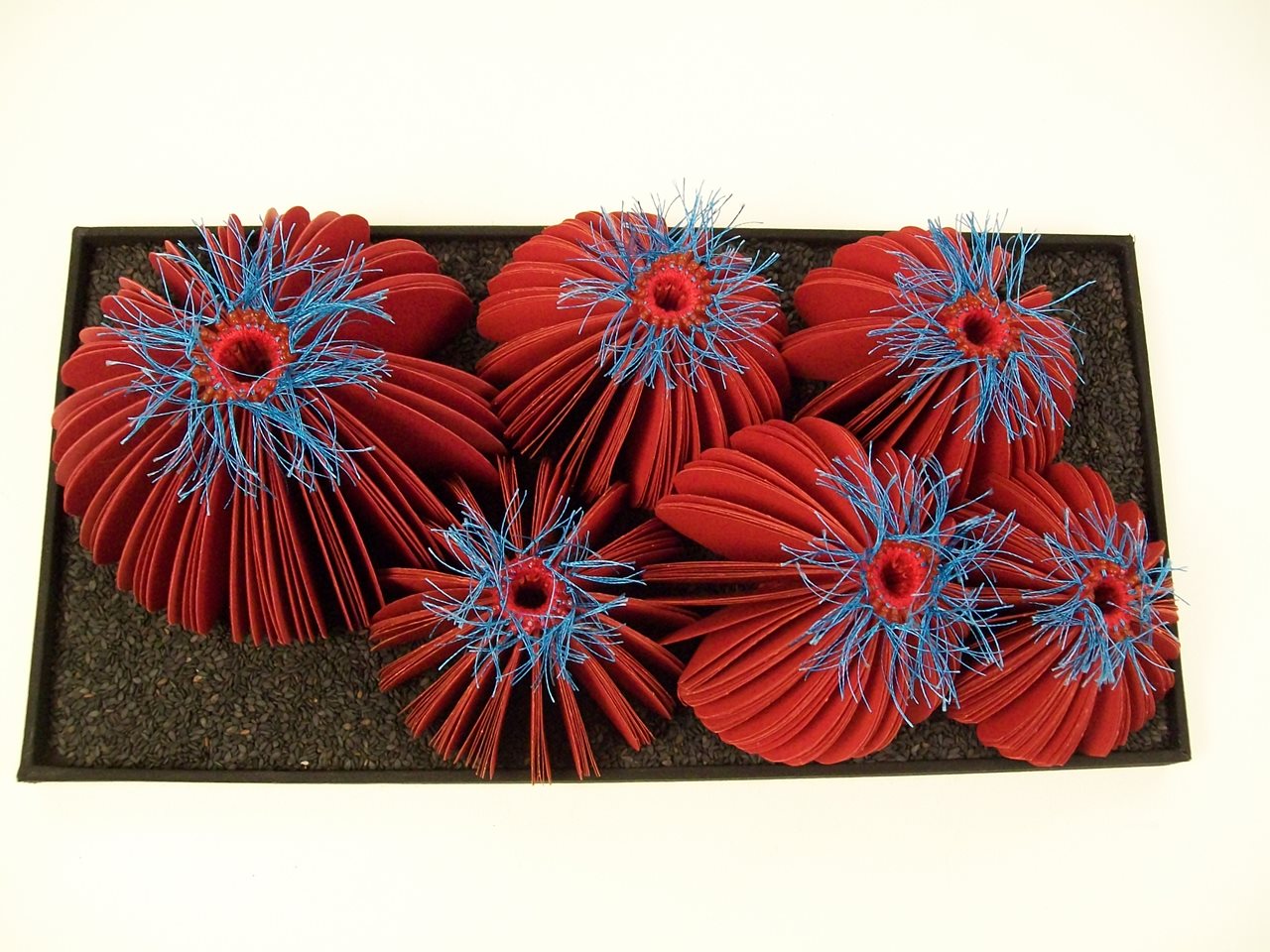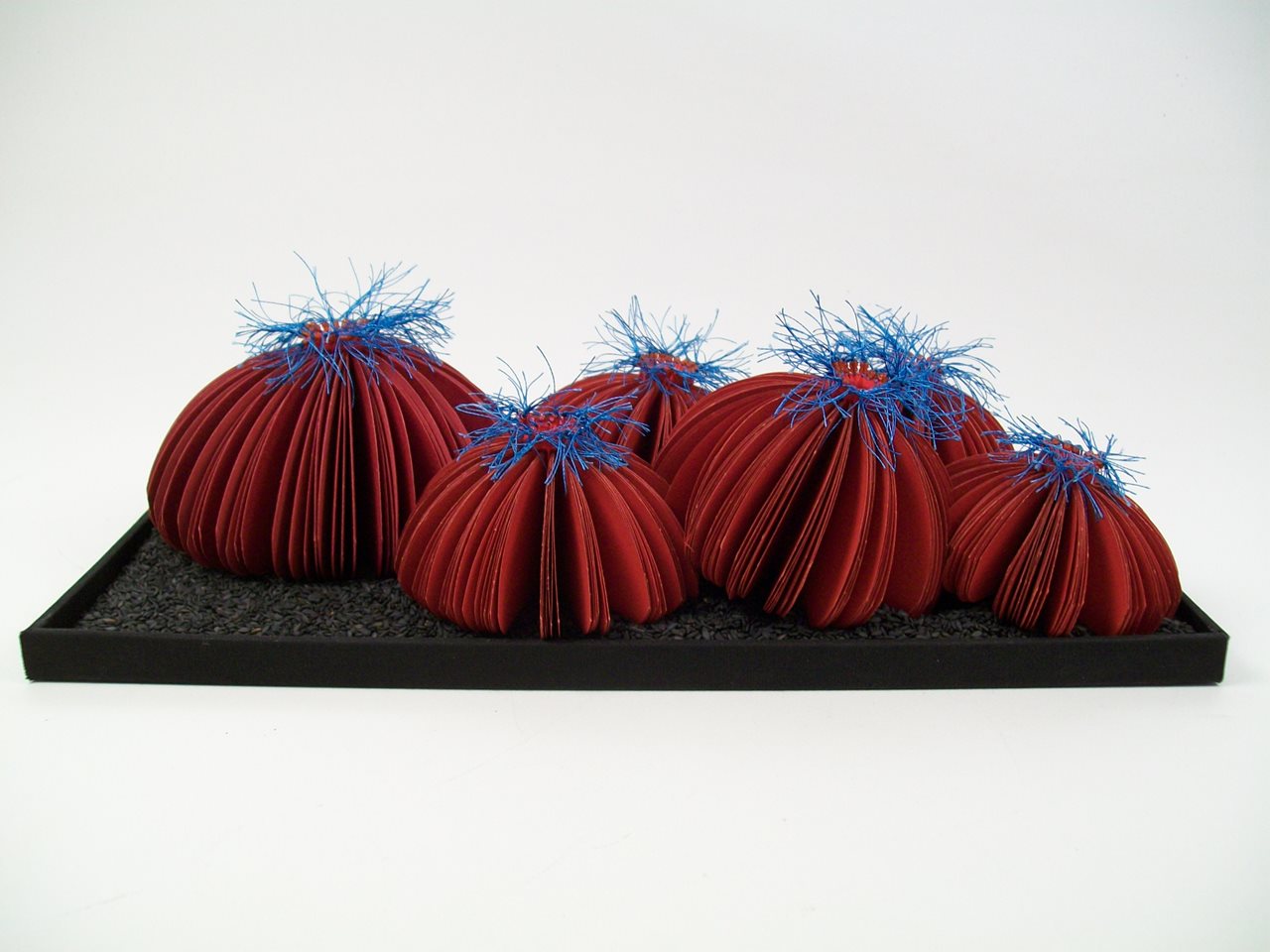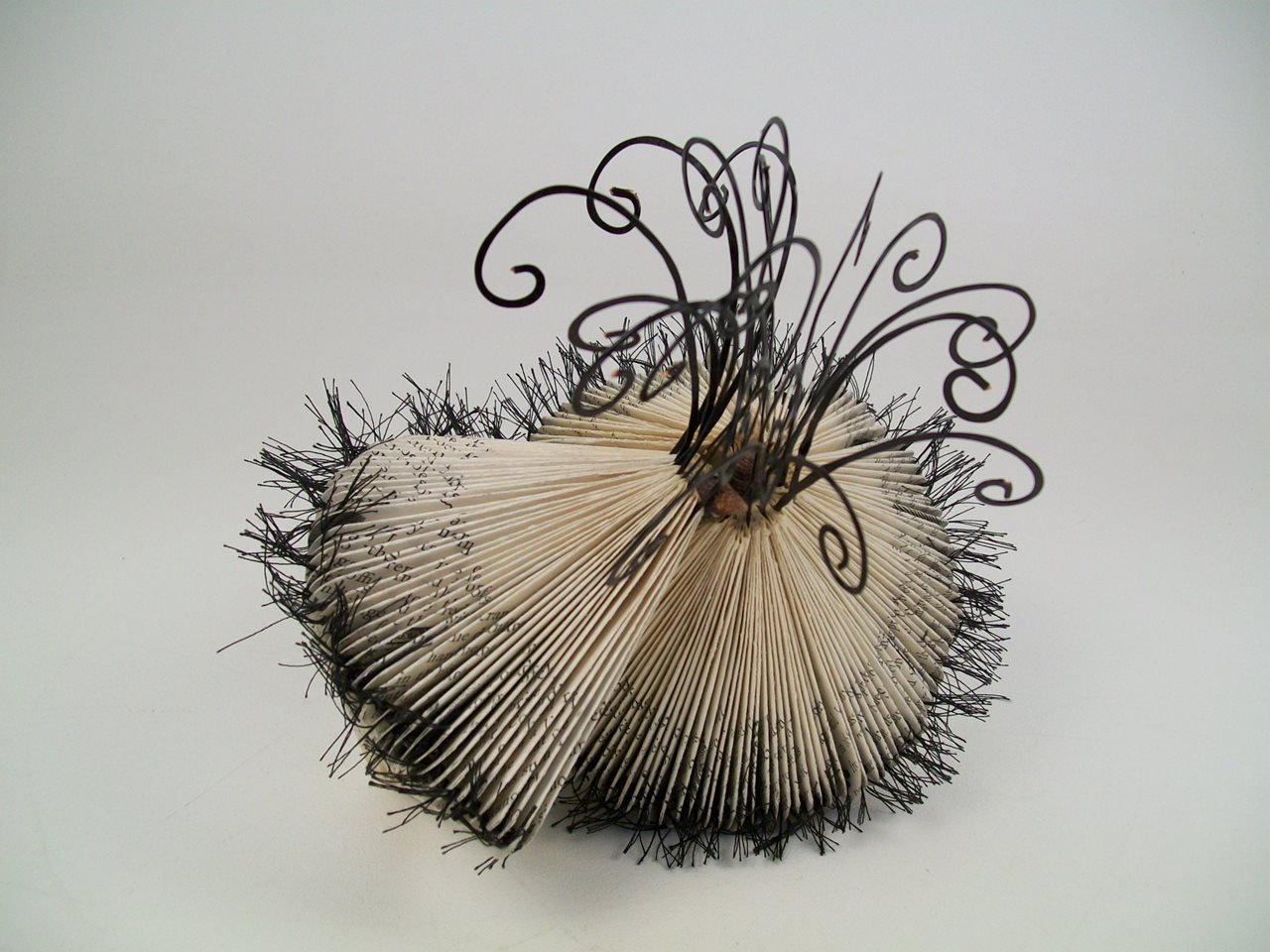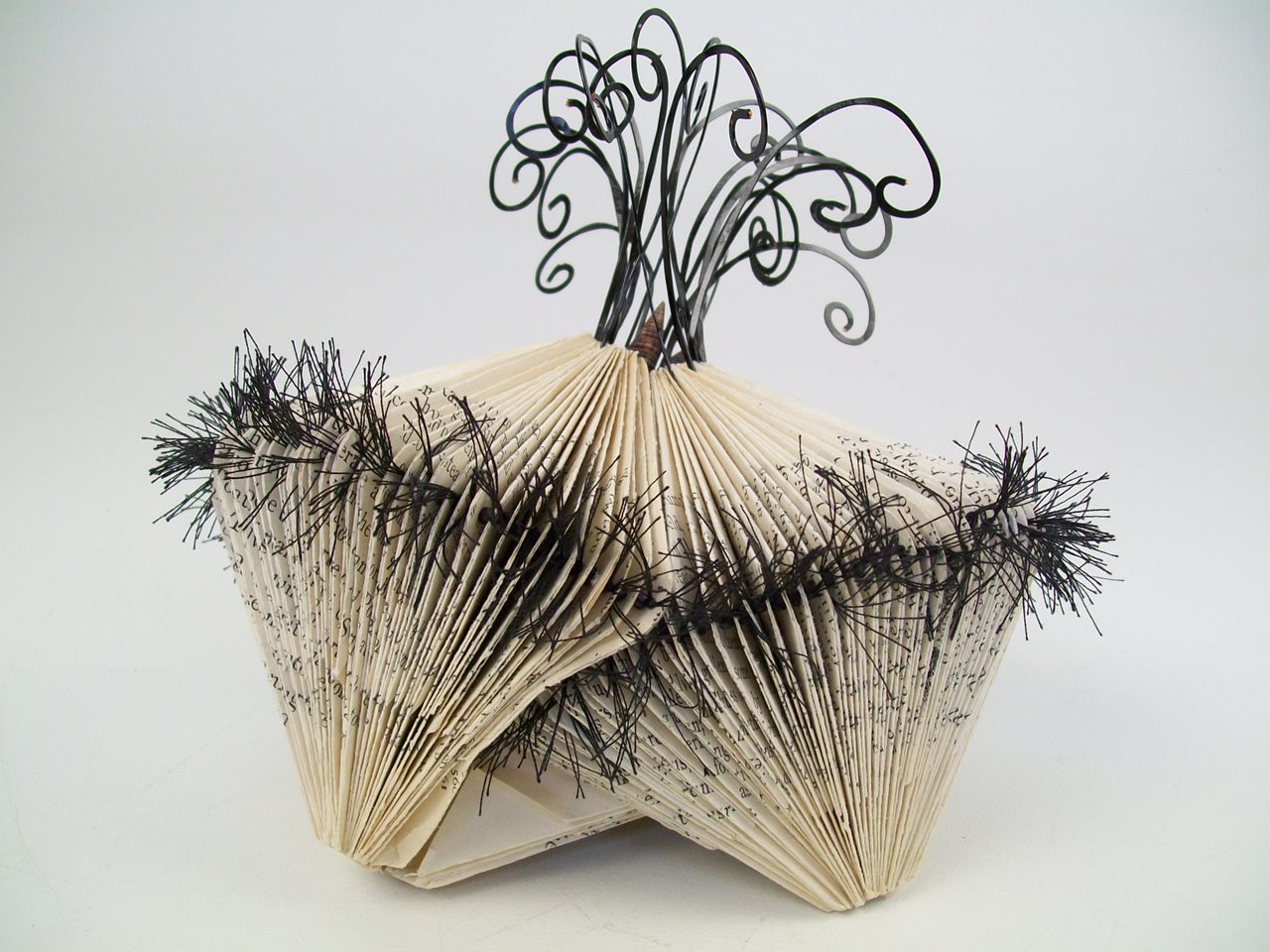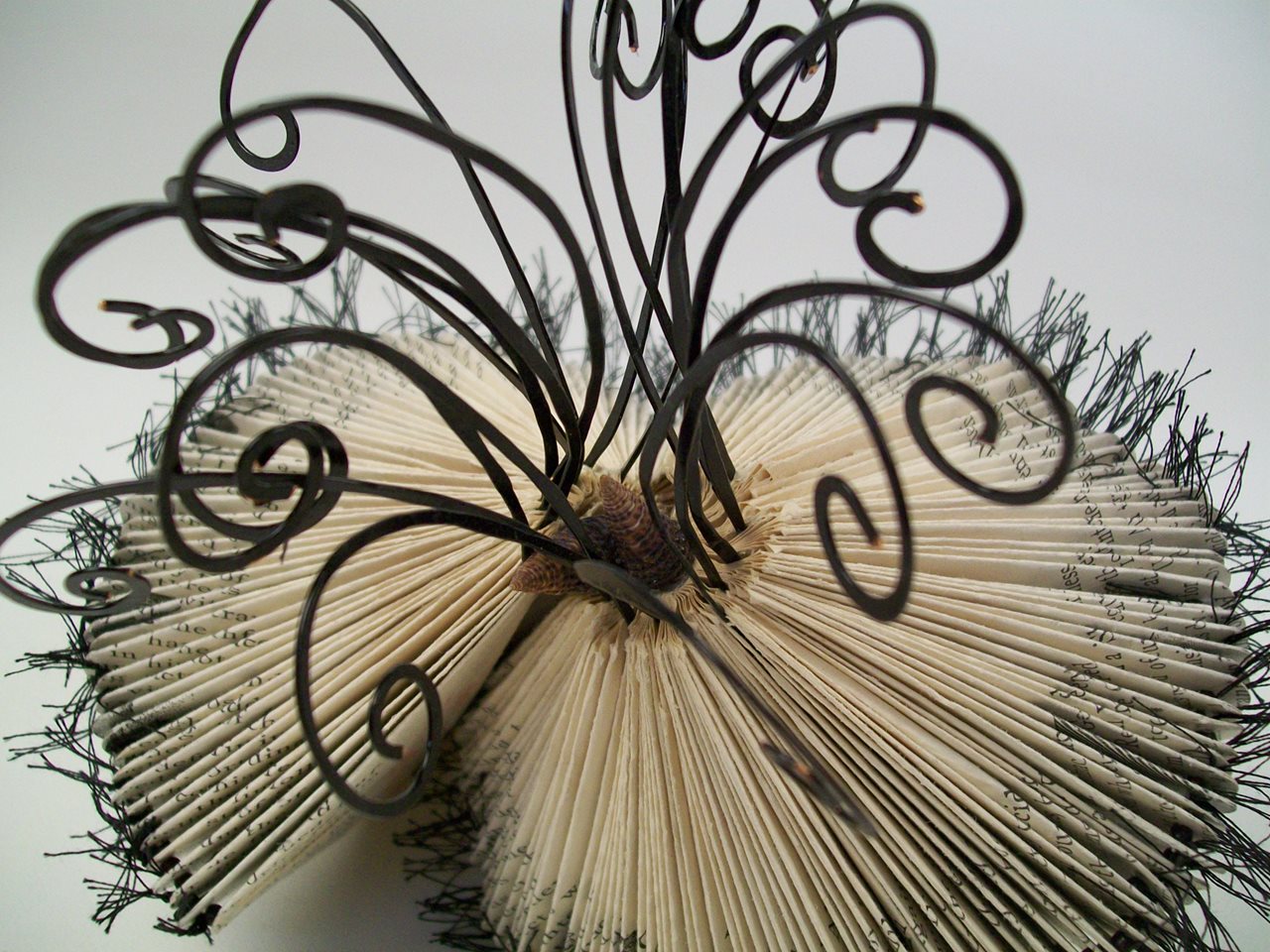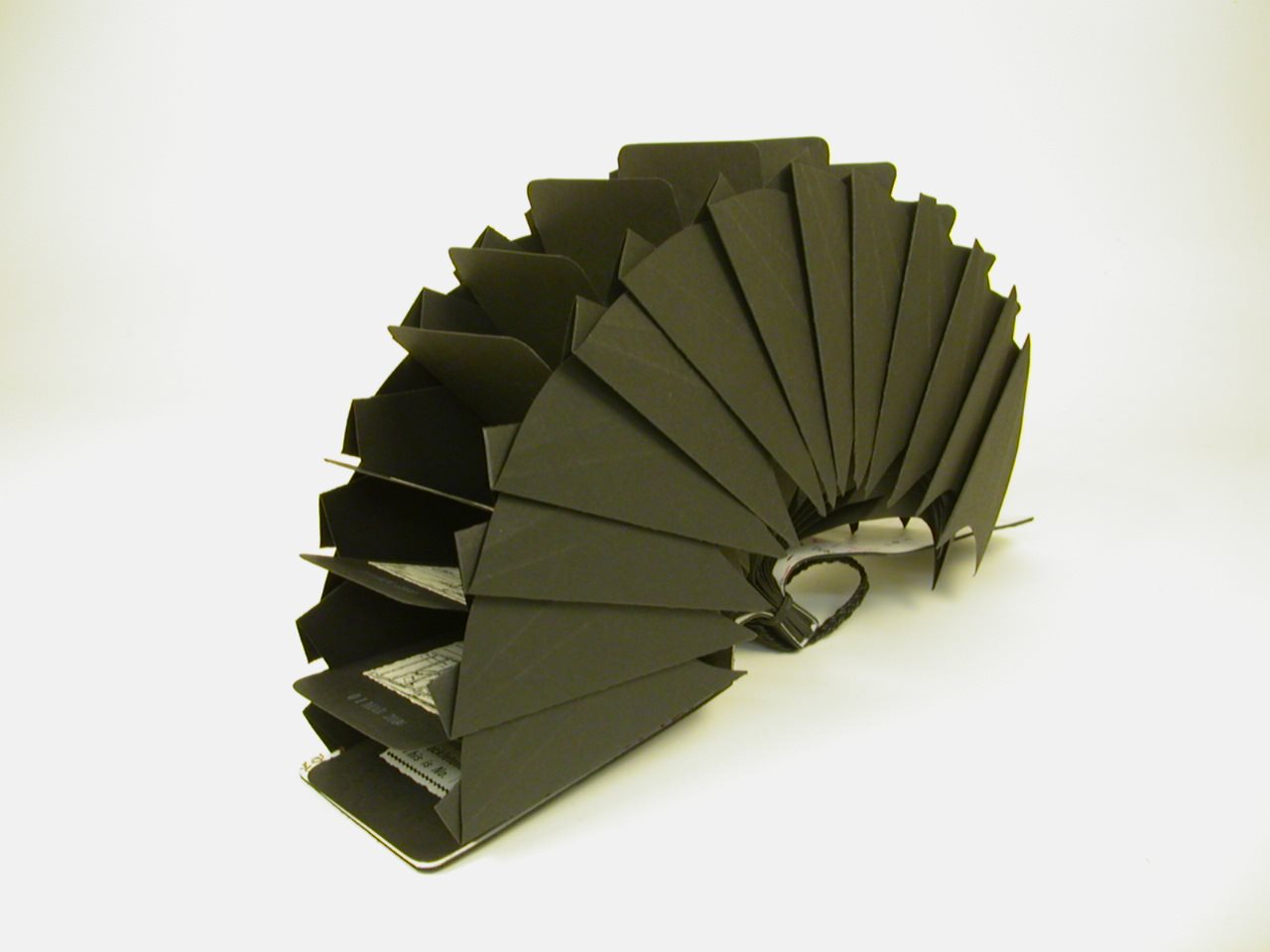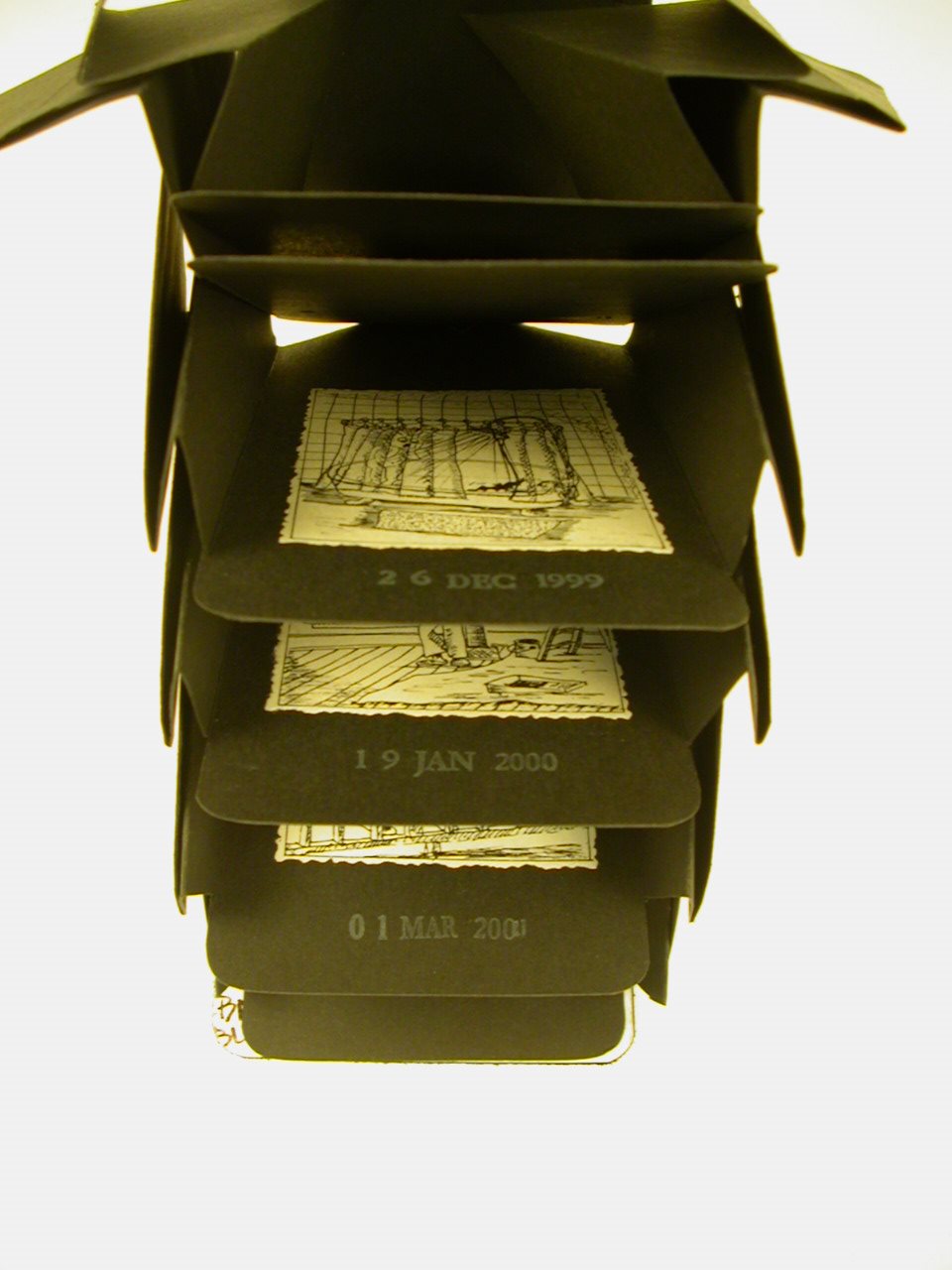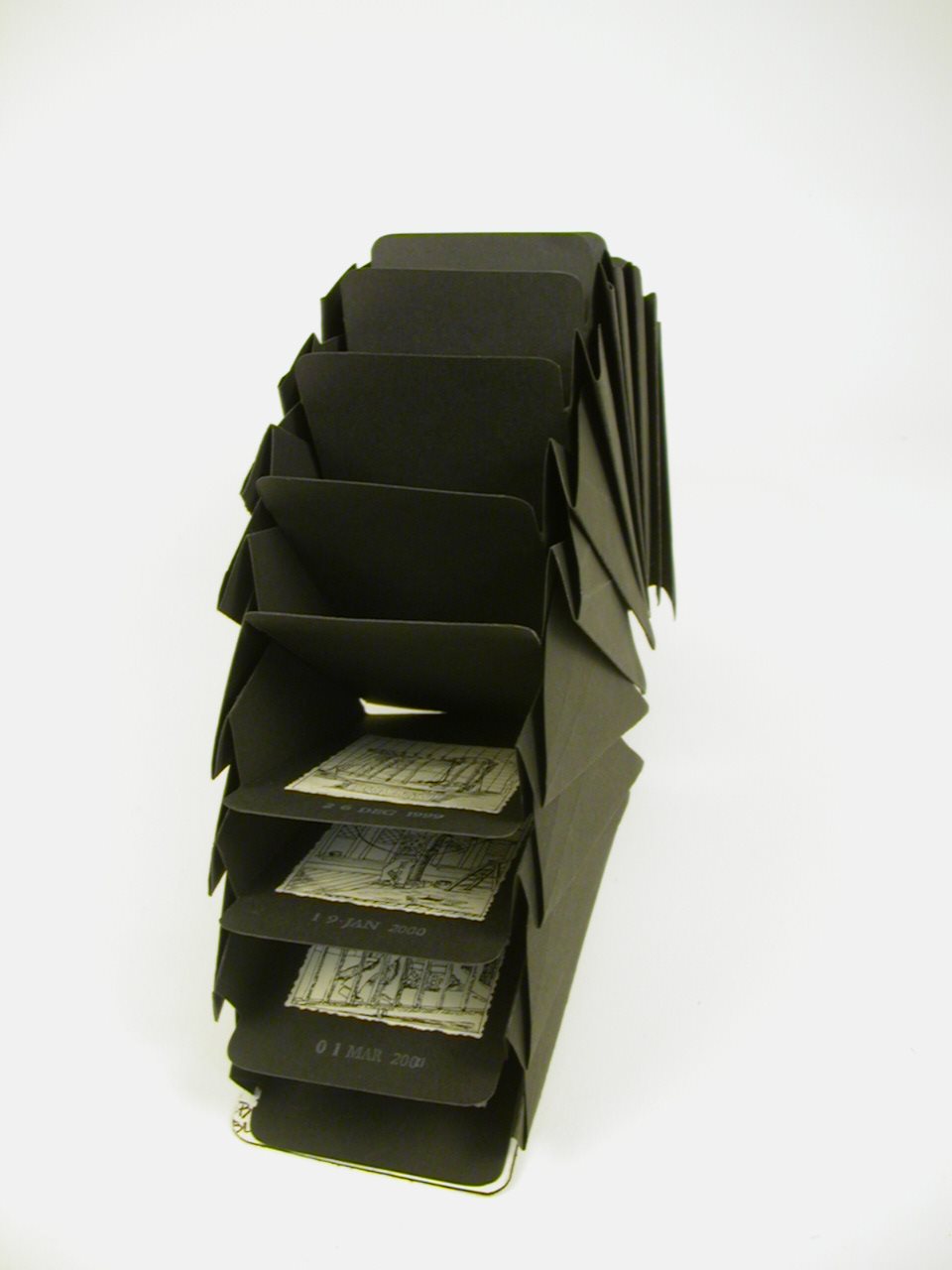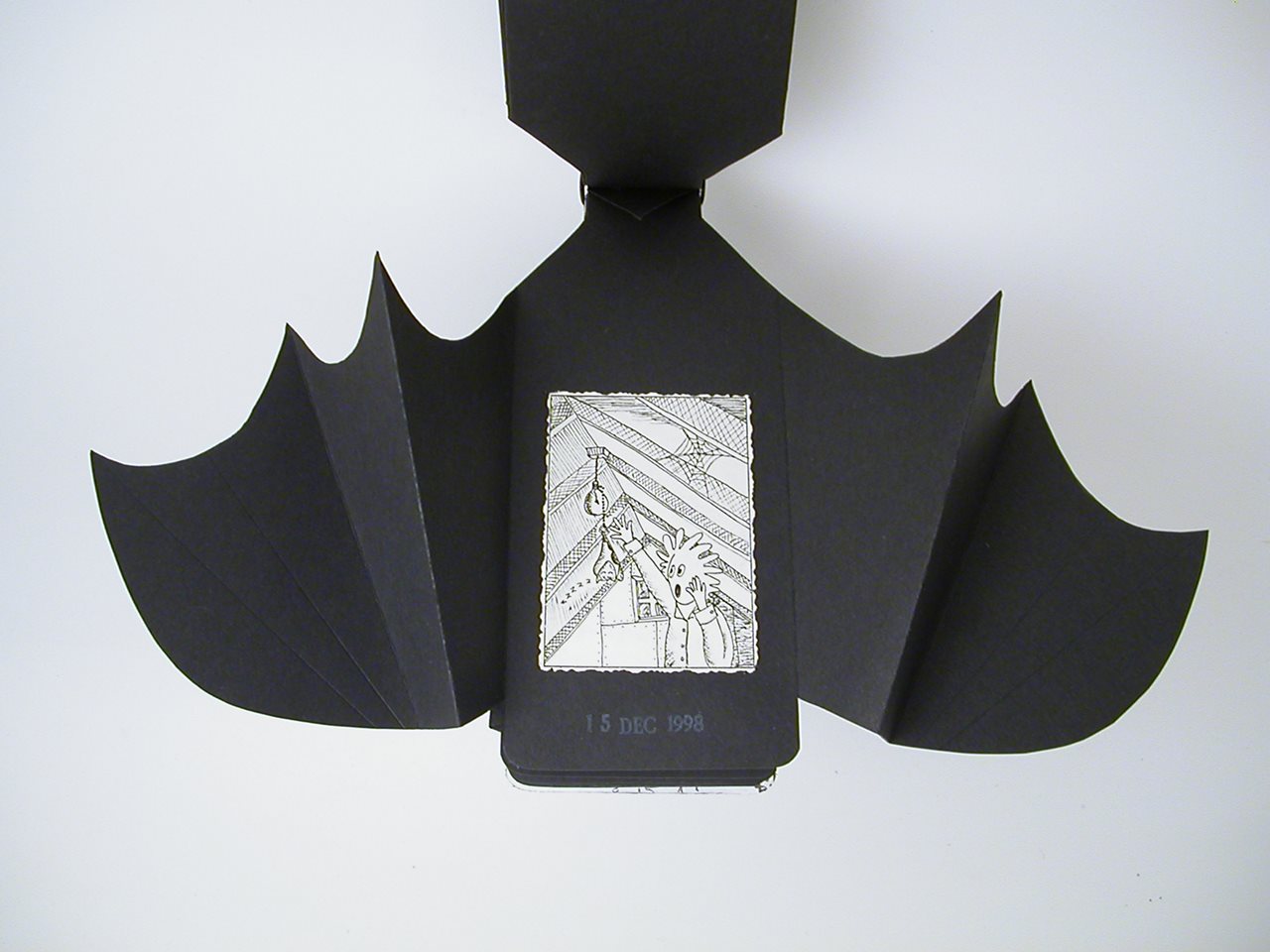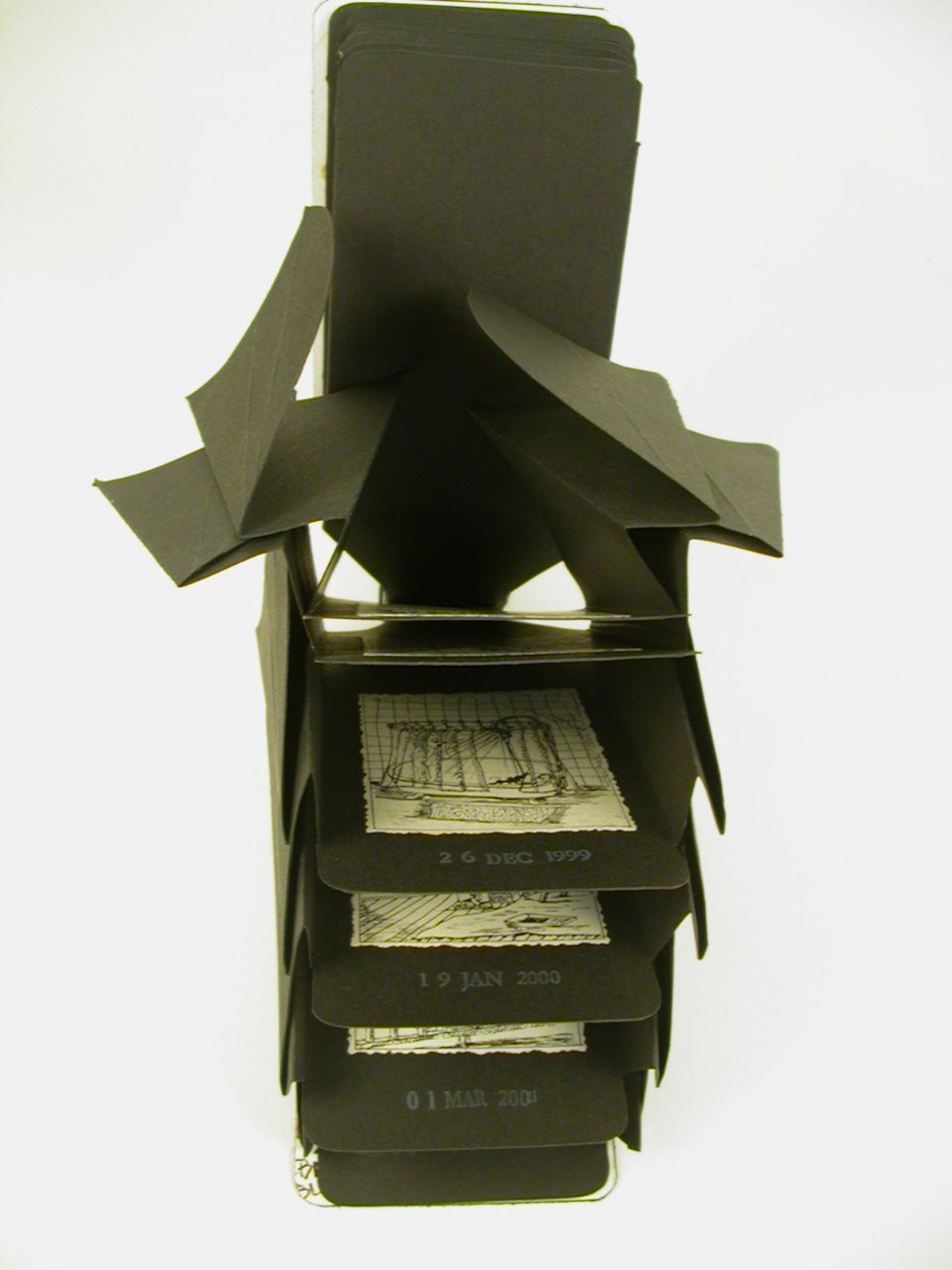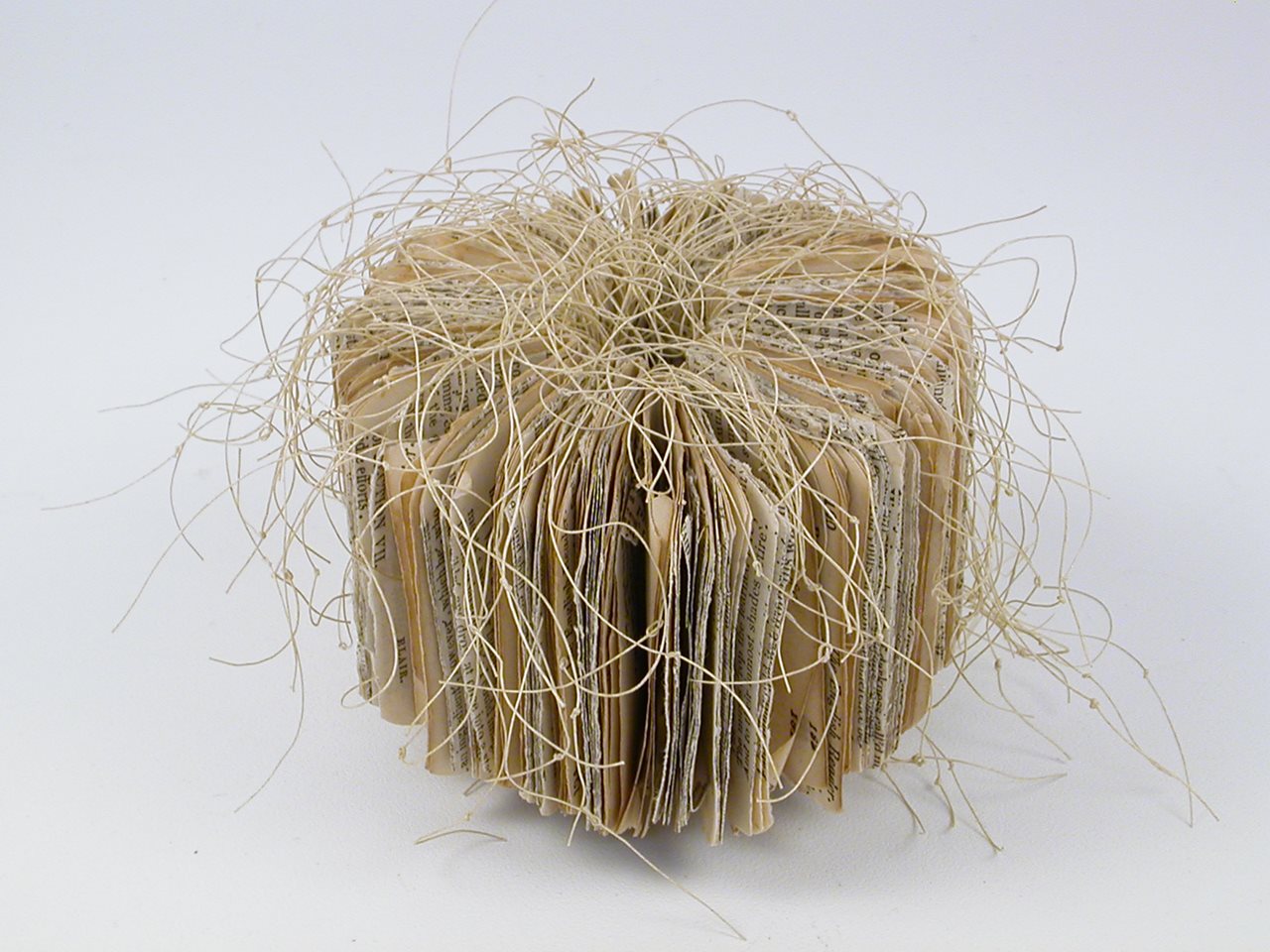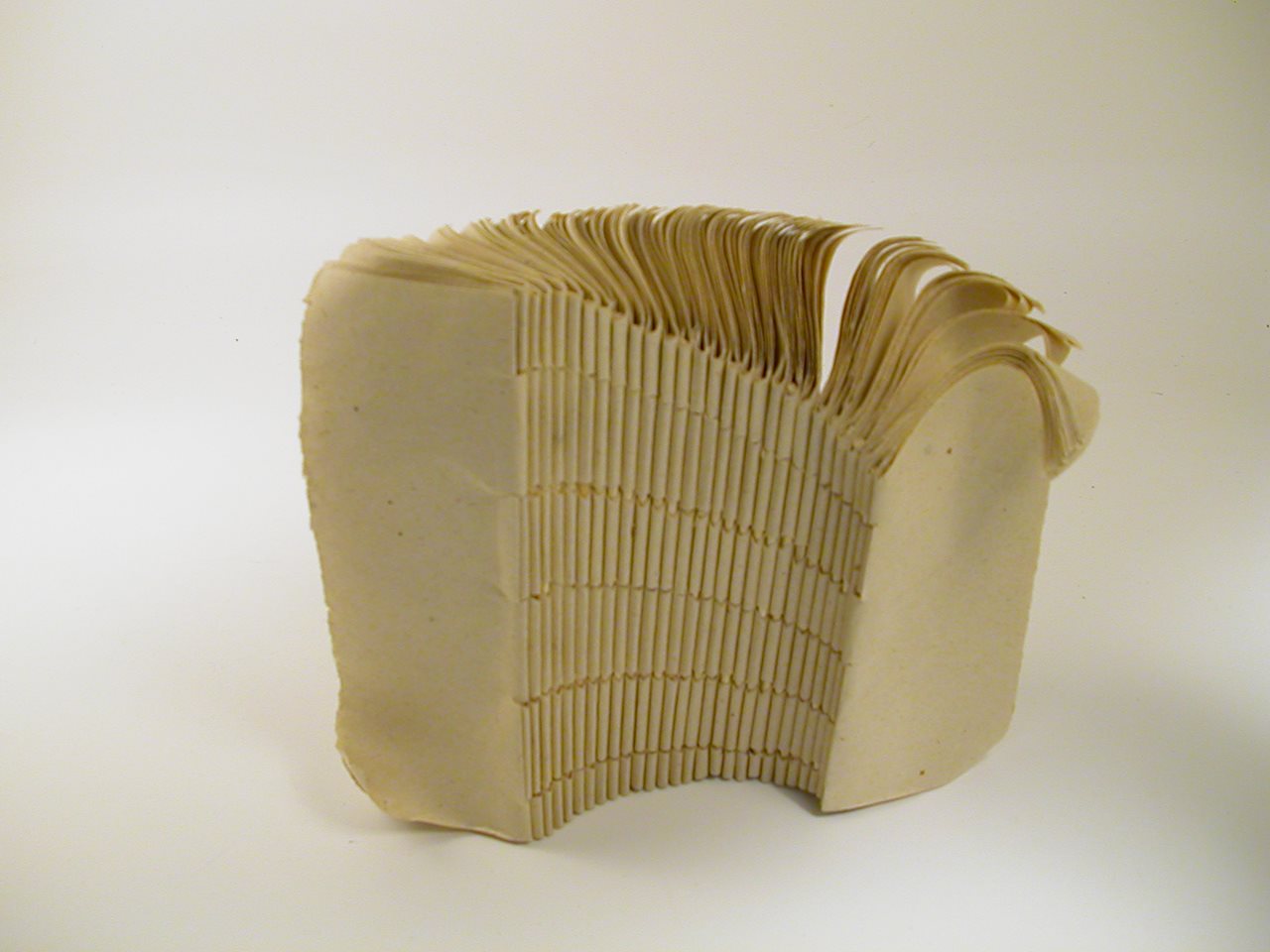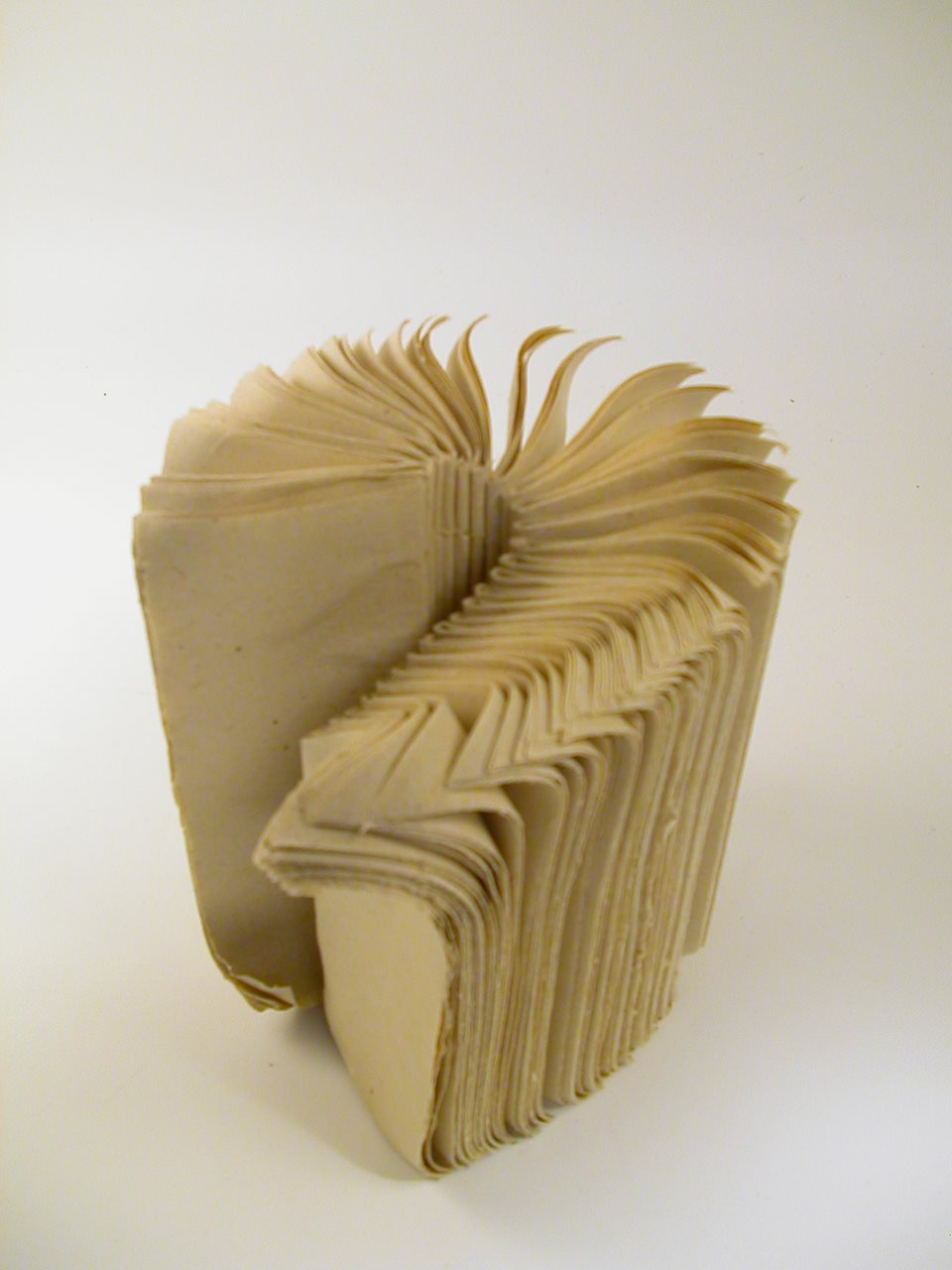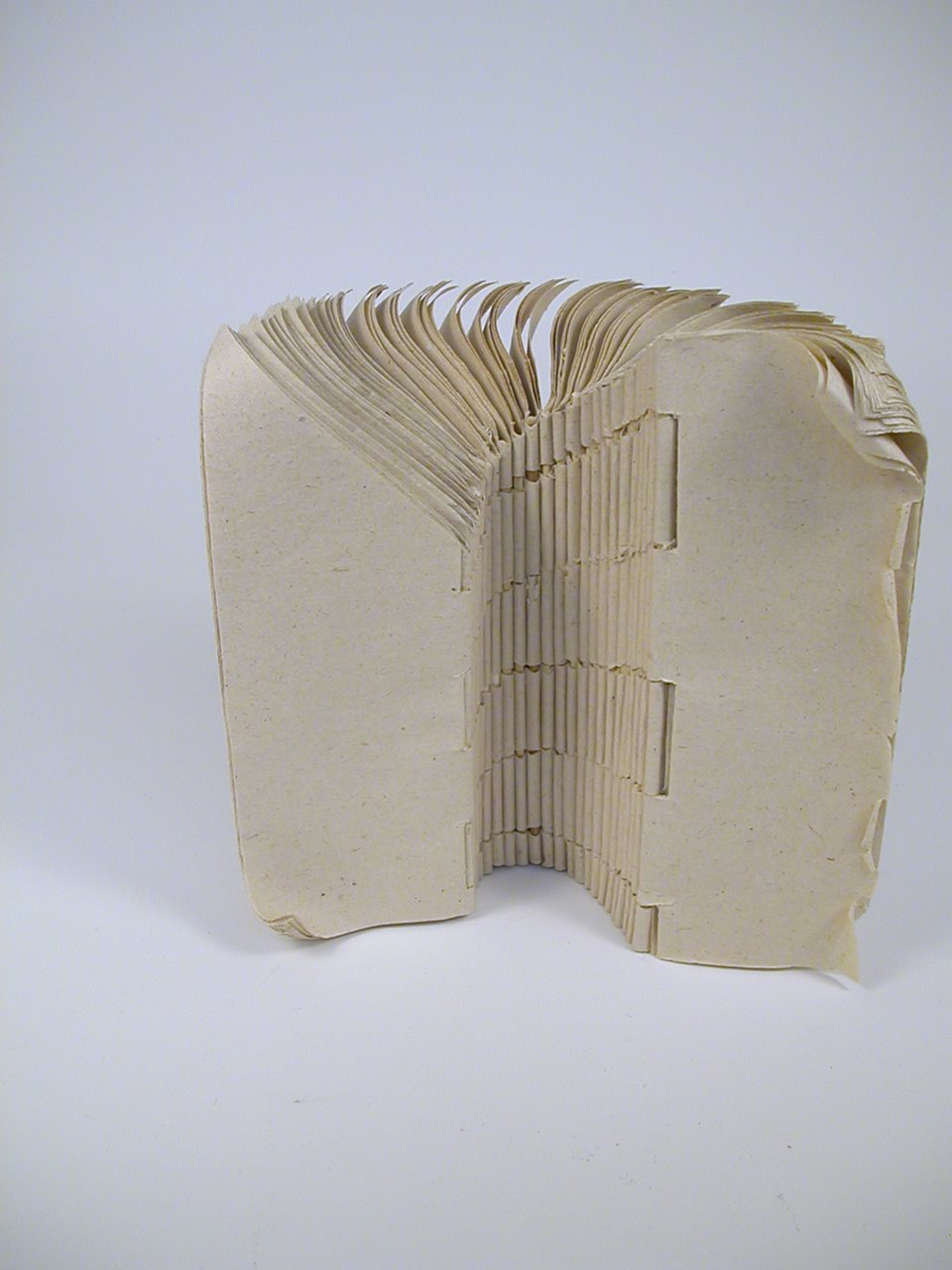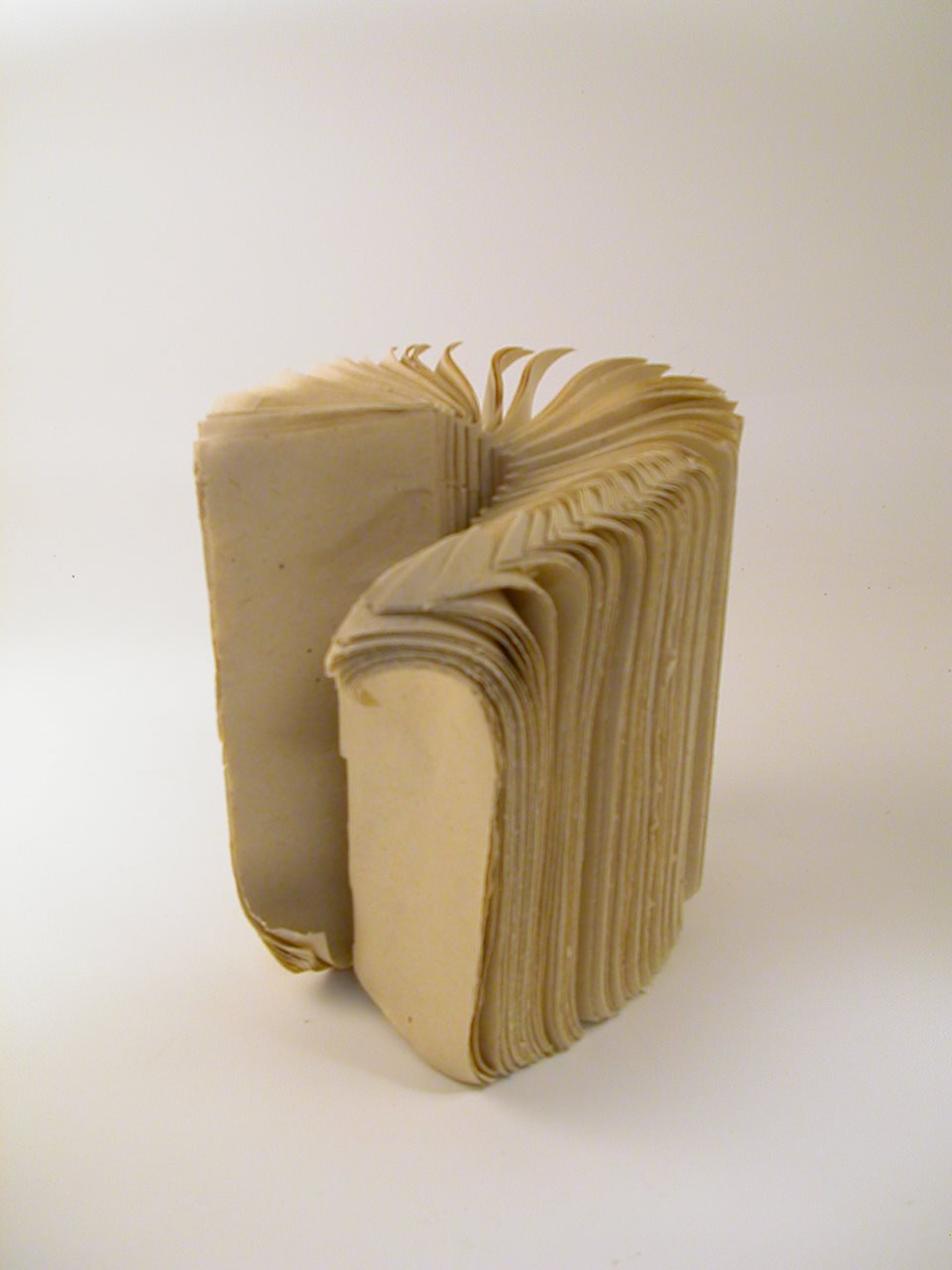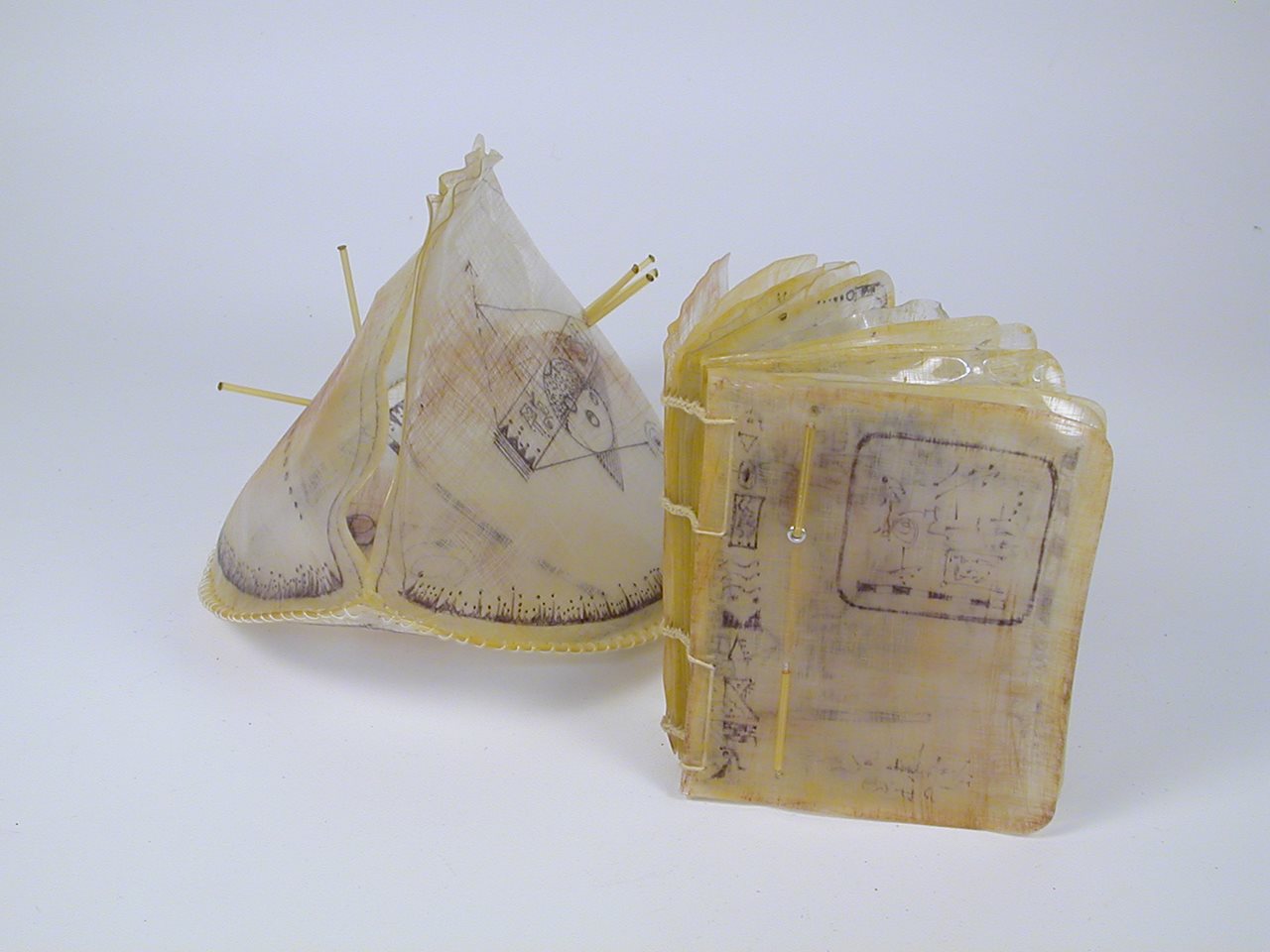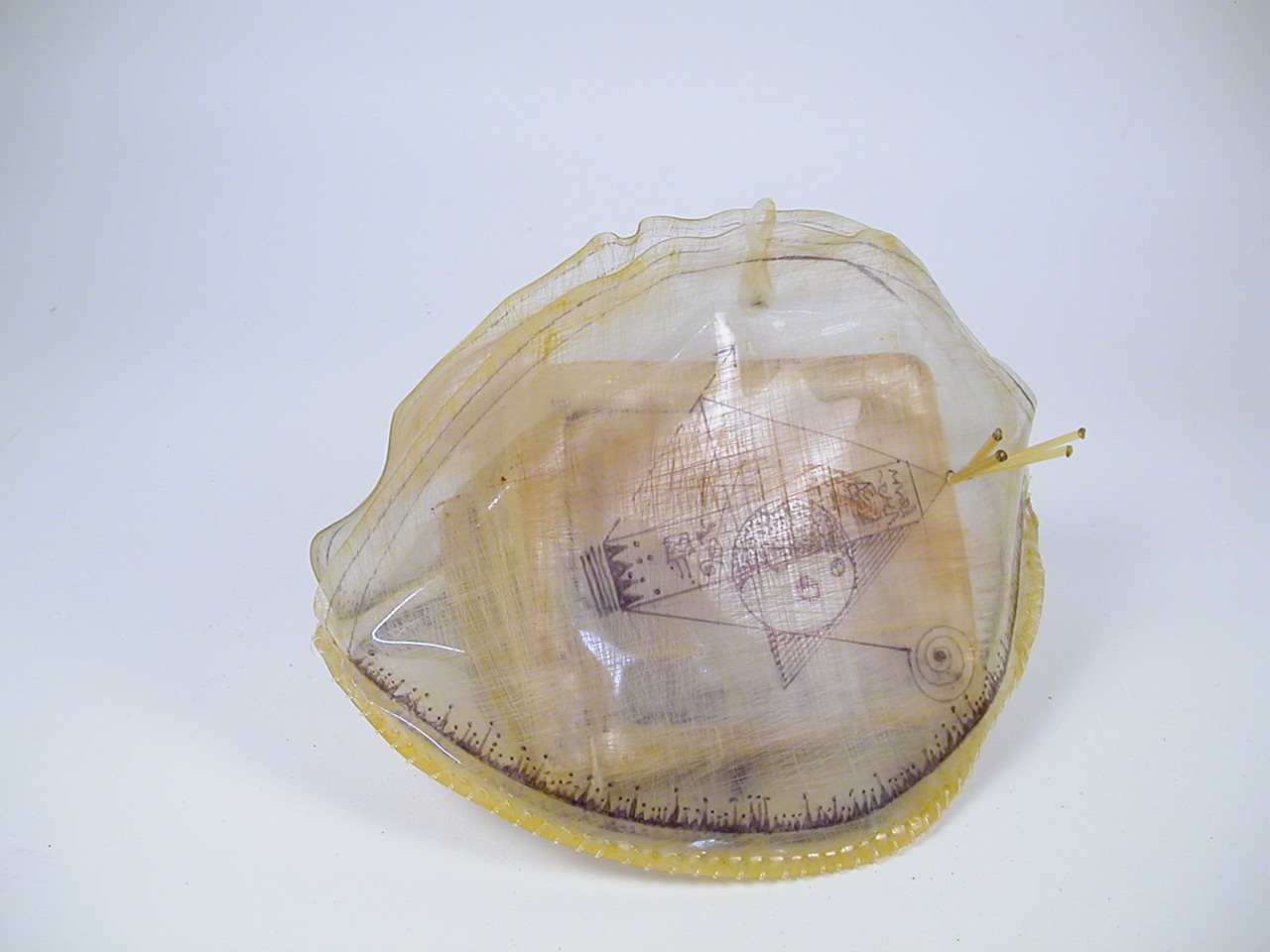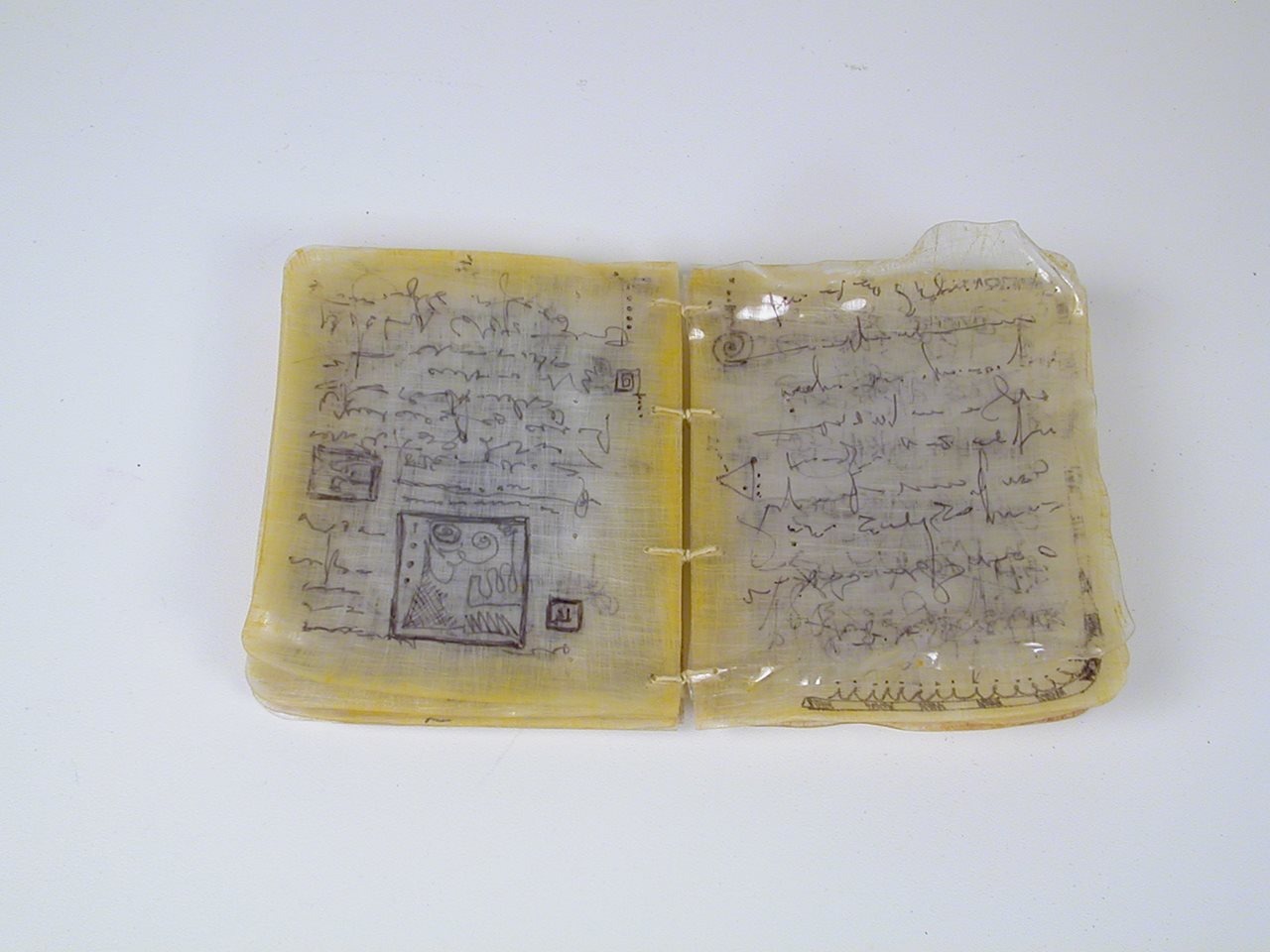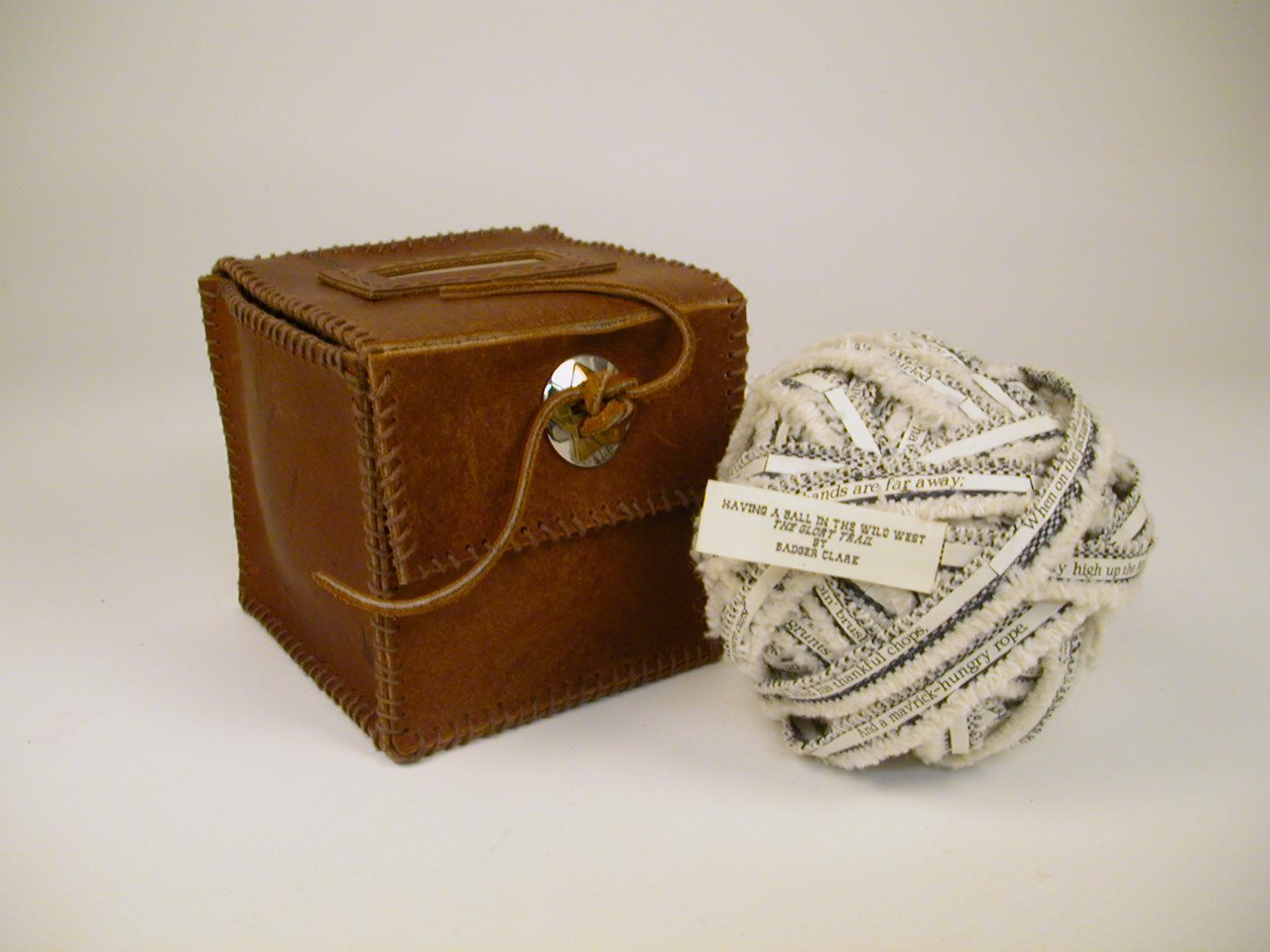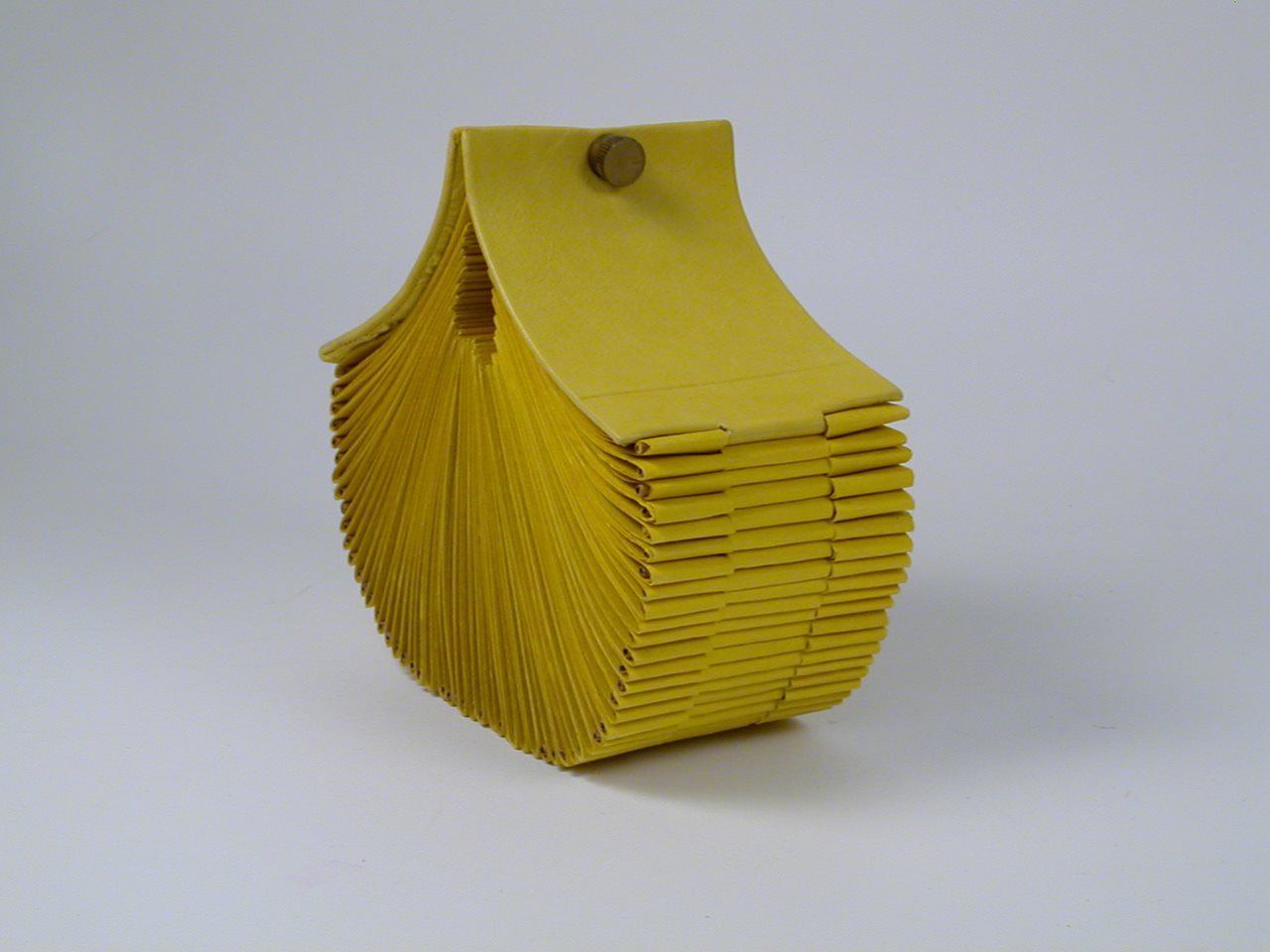Peggy’s sculptural book objects are often inspired by organic forms or by the materials themselves. She sometimes coins faux Latin names for her pieces (Podiforma Pricularium), and other times she refers to a pictorial dictionary where an image similar to the sculptural form provides the title (Radiolaria).
Hybrid Hive Peep Show
2022
7.5″ h x 15.0″ w x 12.5″ d
Pâpier-maché, lemon verbena branch, LED lights, paper straws, acrylic paint, and binder’s board.
Hybrid Hive Peep Show
Altered book.
A wonderful wasp nest in the Mexican Sierra Madres inspired this piece. The idea sparked a search for a book to alter. I found one, on-line, Wasps and Their Ways, a delightful book written in the early 1900s.
I saved the contorted branches and twigs of a lemon verbena that had been bonsaied and nurtured for years before it finally died. The book was repurposed into a wasp nest attached to the twisted verbena branch. The inside of the pâpier-maché hive has readable bits from the book overlaid with gold paint, and a “comb” made from paper straws. LED lights glow from inside the comb. The exterior of the hive is covered using the mostly blank pages from the book. The hive rests on a box that mimics the book and its batteries are contained inside. Assorted drawings of the wasps are crawling around the hive.
Artichoke-ish
2020
9″ h. x 15″ w. x 6.5″ d
Assorted papers, beads, thread, wire, pâpier-maché, florist’s tape, and acrylic paint.
Artichoke-ish
A pair of cardboard shoe inserts inspired this piece. I envisioned a corolla with splayed petals emanating from it. The use of pâpier-maché, over an armature created the receptacle for the Coptic and post-bound book which consists of crumpled and stained tracing velums. I used a metallic coated paper from China to produce the pointed scales on the exterior of the corolla. The stem is wrapped with florist’s tape.
Geode
2018
Irregular spheroid approximately 6.0″ h x 5.5″ w x 5.5″ d
Pâpier-maché, assorted papers, acrylic paint, thread, thermographic powders, and rhinestones.
Geode
The name geode comes from the Greek word Geoides, which means “earthlike.” Geodes are spherical rocks that contain cavities lined with crystals. These unique rocks are formed in hollow areas in the soil. Over hundreds of millions of years, groundwater seeps through, leaving the crystalline deposits.
This Geode is has a pâpier-maché, shell, and a pair of single sheet Coptic books made with layers of sparkly papers that suggest the crystals found inside the rock.
Thermographic powder around the hollow and rhinestones add to the effect.
Podiforma Prickularium
2018
5.0″ h. x 11.0″ w. x 6.5″ d.
Pâpier-maché, acrylic paint, fishing line, vellum paper, and threads.
Podiforma Prickularium
A single quire book of die-cut vellum paper is housed in a pâpier-maché pod. I originally envisioned an elegant, smooth graceful pod, but pâpier-maché, is lumpy. So I added warts and prickly parts. The inside of the pod is painted copper, as are the tips of the prickles. Assorted metallic and frayed cords accent the center of the book.
Scorpius Anomalus
2018
9″ h. x 18″ w. x 3″ d.
Paper, thread, plastic, paint, glue, beads and pins.
Scorpius Anomalus
I often make up pseudo-Latin titles for my pieces.
This one is inspired by the scorpion-tail end of the book’s container and the name of an early shrimp-like fossil (Anomalocaridid).
The warped circular pages are sewn together with a coptic stitch, then stitched to a plastic strap to give it more strength and flexibility. Plastic milk jug circles with beads and thread are attached along the strap. In the end, the book was too unstable to stand alone, so the container evolved to support it for display. The container was formed from half of a mailing tube which is covered with paper on the outside, and painted silver on the interior. Glass quilting pin heads line the container’s exterior to give it texture and “feet” on which to stand.
Does this Make Me Look Fat?
2017
5.5″ h. x 8.0″ w. x 8.0″ d.
Coffee filters, mushroom coral, thread, acrylic paint, chicken bone, copper filament, foil, and wire.
Does This Make Me Look Fat?
This piece was inspired by the mushroom coral on the top. It reminds me of signatures sewn into a circle. I used a Coptic stitch to create the base (which is made of coffee filters) then dipped it into an acrylic wash. It was too dark, so I added the copper elements. Then it needed a face. It’s made from the shoulder bone of a chicken.
That’s How We Roll
2017
6.0″ h. x 4.0″ w. x 6.0″ d.
Coffee filters, thread, acrylic paint, plywood, Chinese paper, Chinese coins, tacks, glue and beads.
That’s How We Roll
This sculptural piece was too flimsy to stand on its side, which is what I envisioned, even after the addition of beads between the signatures. So, I put it on wheels.
That’s how I roll.
Caterpillar
2016
4.25″ h. x 40.0″ w. x 2.25″ d.
When displayed, 8.5″ h. x 18″ w. 4.25″ d.
Leather, beads, monofilament, waxed linen thread, crinoline, copper welding studs, and vintage guard material.
Caterpillar
The inspiration for this piece was a box of copper welding pins that I found at an auto swap meet. The 270 signatures are folded circles of crinoline (super) sewn with black monofilament to pleated guard material (used in the construction of oversized ledgers long ago). The guard material is stitched with waxed linen thread to a strip of leather, and embellished on the outside of the leather with three stacked beads at each pleat. Over 2500 holes were punched in the leather and guard material for the sewing stations.
I had no idea when I started the piece what it would look like or how it would behave once I had sewn it.
I love to be surprised by my work. I often feel that the creative process controls me. Sometimes, as in this piece, the materials dictate the outcome of the piece.
This piece weighs 2.4 pounds.
Ammonite II
2015
6.0″ h. x 4.75″ w. x 11.0″ d.
When displayed, 8.5″ h. x 18″ w. 4.25″ d.
Assorted wall paper and other paper, binder’s board, mica, and linen thread.
Ammonite II
Beginning with a circular shape of less than an inch, I cut 163 signatures of assorted papers, each section slightly larger than the previous one. The final signature is a bit more than 6 inches high. The signatures are held together with a Coptic stitch. The cover at the large end is mica over binder’s board. The finials are of the same mica as the cover. Inspired by organic forms: in this case, fossil snails or ammonites.
Meerchin
2013
6.5″ h. x 7″ w. x 7″ d.
Overbeaten flax paper, pâpier-maché finial with taxidermy eyes, thread, and acrylic paint.
Meerchin
I named this piece Meerchin because it reminds me of a meercat and a sea urchin. The pages are of overbeaten flax. It took me most of a summer to make them, by pouring the pulp into embroidery hoops, and then waiting for them to dry. Since the amount of pulp varied, so did the amount of shrinkage as it dried, resulting in circles of varying diameters. They are folded and sewn together in an endless Coptic binding. The finial is pâpier-maché over the stem of a Schefflera plant that I found on a Florida beach. Taxidermy fish eyes and waxed linen tufts add to the painted pâpier-maché. A dyed lamb chop “Panty” encircles the Meerchin’s neck.
Reticula Curva
2012
6.5″ h. X 16.5″ w. x 9.0″ d.
Walnut dyed rosin paper, waxed linen thread and copper.
Reticula Curva
Book object. 118 signatures of walnut dyed rosin paper are sewn with a herringbone stitch to copper straps. The ends of the straps are coiled into opposing spirals. Folded discs of copper accent the fore edge of the pages. Inspired by organic forms.
Argonautes
2012
6.5″ h. x 7.5″ w. x 10.0″ d.
Paper, thread, cloth, glass beads and copper filament.
Argonautes
The 75 pinked sections of this sculptural book are made of book cloth and various types of paper. Lokta paper lines the spine and finishes the covers of the piece. A beard of copper filament and glass beads runs along the edge of the base, and more filament fringes the head and tail of the form. The book object is inspired by organic forms, in this case, the paper Nautilus or (Papier Argonautes).
Rotundiforma
2011
7.5″ h. x 6.00″ w. x 6.00″ d.
Vellum and Parchtex papers, thread, 50# test fish line and beads.
Rotundiforma
Book object. An inside-out book of 45 die-cut sections bound with a link stitch. The exaggerated end band is embellished with beads and fishing line.
Inspired by organic forms.
Radiolaria
2011
5.5″ h. x 5.75″ w. x 5.75″ d.
Tea-dyed laboratory filter paper, thread, and copper filament.
Radiolaria
Book object. Bound in an endless Coptic format. The exaggerated end band is woven over leather and jute. Curled copper filaments are added to the band.
Inspired by organic forms.
Pentapod
2011
7.75″ x 5.75″ x 5.75″
Vellum, thread, 50# test line and beads.
Pentapod
Book Object. Five dye-cut signatures are bound with a link stitch. Beads and fishing line embellish the book.
Inspired by organic forms.
Curly Dredges
2010
5.75″ x 9.0″ x 5.5″
Paper, straws, thread, vintage dredge pens, elastic bands, and book cloth.
Curly Dredges
Book Object. A friend gave me several boxes of dredge pens when cleaning out the inventory at her family printing and office supply business. Eighty six of the ink-stained dredge pens comprise the ornamentation on this piano hinge book. Dredge pens were used to create ledger and columnar pages in the days when letterpress printing was the standard. 44 signatures.
Mollusk
2010
6.50″ x 6.00″ x 2.25″
Tea stained ovals, linen thread and a bead.
Mollusk
Book Object. Folded tea stained ovals and pinked vellum ovals are sewn into an ovoid shape using a link stitch. The end band tapers beyond the edge of the piece and curls down to a point. A single “pearl” is at the opposite end of the end band.
Inspired by organic forms.
Star Coral
2010
12.50″ x 6.00″ x 2.50″, installed
Books: Paper, beads and thread.
Tray: Davey board and book cloth.
Tray filler: Black sesame seeds.
Star Coral
Book Objects in a small installation. The red mound-shaped books are sewn with link and Coptic stitches. Beads and thread suggest cilla on the top of each piece.
Inspired by organic forms.
Gemini Pod 2
2009
5.50″ x 6.50″ x 6.00″
Recycled book, wire, thread, beads and shells.
Gemini Pod 2
A recycled antique book is folded into pod forms. The addition of threads and beads gives the structure a sturdy feel and adds to the organic feel of the piece.
Hammered wire curls complete the effect.
Entries from the Bat Log
2007
(closed) 7.75″ x 3.00″ x 1.25″
Leather, letterpress, and drawings on paper.
Entries from the Bat Log
Edition of 25.
Urchin
2006
2.50″ h. x 4.00″ x 4.00″
Recycled antique book and thread.
Urchin
The recycled antique book has been sewn into a cylinder with a Coptic stitch. Knotted linen thread gives an organic feel to this piece. The book appears to float above its base.
Tsunami
2005
7.5″ x 3″ x 5″
Handmade paper and skewers.
Tsunami
Book object. Curled pages of descending size suggest the force of a large wave.
Piano hinge binding.
Edition of 2.
Starship Log And Pod
2004
9.50″ X 6.5″ X 6.5″
Heat-warped polyester, ink, crayon, beads and fishing line.
Starship Log And Pod
Book Object. The coptic-stitched book is inscribed with an unintelligible code, which hints at extraterrestrial origin. The book and pod show signs of wear and tear, as if subjected to great heat and other external forces.
Edition of 2.
Having A Ball In The Wild West, The Glory Trail
2003
4″ X 4″ X 4″ box holding a 4″ sphere.
Leather, denim selvage, paper, over a plastic ball.
Having A Ball In The Wild West, The Glory Trail
Book Object.
Badger Clark was named South Dakota poet laureate in 1937, but he preferred the nickname “poet lariat.” As the poet laureate, Clark produced several books as collections of his works. The earliest, “Sun and Saddle Leather,” was published in 1915, and contained “The Glory Trail.”
Found text, denim selvage and a concho-embellished leather box make up this piece. Badger Clark‘s poem tells of a cowboy‘s unfortunate decision to rope a mountain lion and the adventure that ensues. The poem is cut into strips and glued to denim selvage. Inside is a ball containing articles that relate to the poem.
Edition of 5.
Yellow Book No. 1
2001
5.00″ x 5.25″ x 11.00″
Paper, leather, brass tubing, cord and brass knobs.
Yellow Book No. 1
The flexible piano hinge binding allows Yellow Book to take on different forms. Closed, it takes on a tear-drop shape.

